Grasshoppers and Crickets (Order Orthoptera) of Mutinondo
This illustrated checklist consists primarily of species detected in November 2018 and February 2019, and the true list is undoubtedly longer. Species marked with an asterisk (*) have been identified from pictures purported but not known with certainty to be from the area.
True Grasshoppers – Family Acrididae
Small to (for insects) massive, usually fully-flighted herbivores; vying with termites for the position of most important (and often abundant) invertebrate herbivores of Miombo woodland. Due to the almost continuous presence of nymphs or adults or many species, form the major part of many insectivorous birds, mammals, amphibians and reptiles’ diets. Here split into subfamilies for ease of recognition.
Acridinae (“Silent” slant-faced grasshoppers)
Typically feeding on grasses and grass-seeds, most abundant in grassland and open woodland. Mostly silent; some species produce a rattling sound in flight.
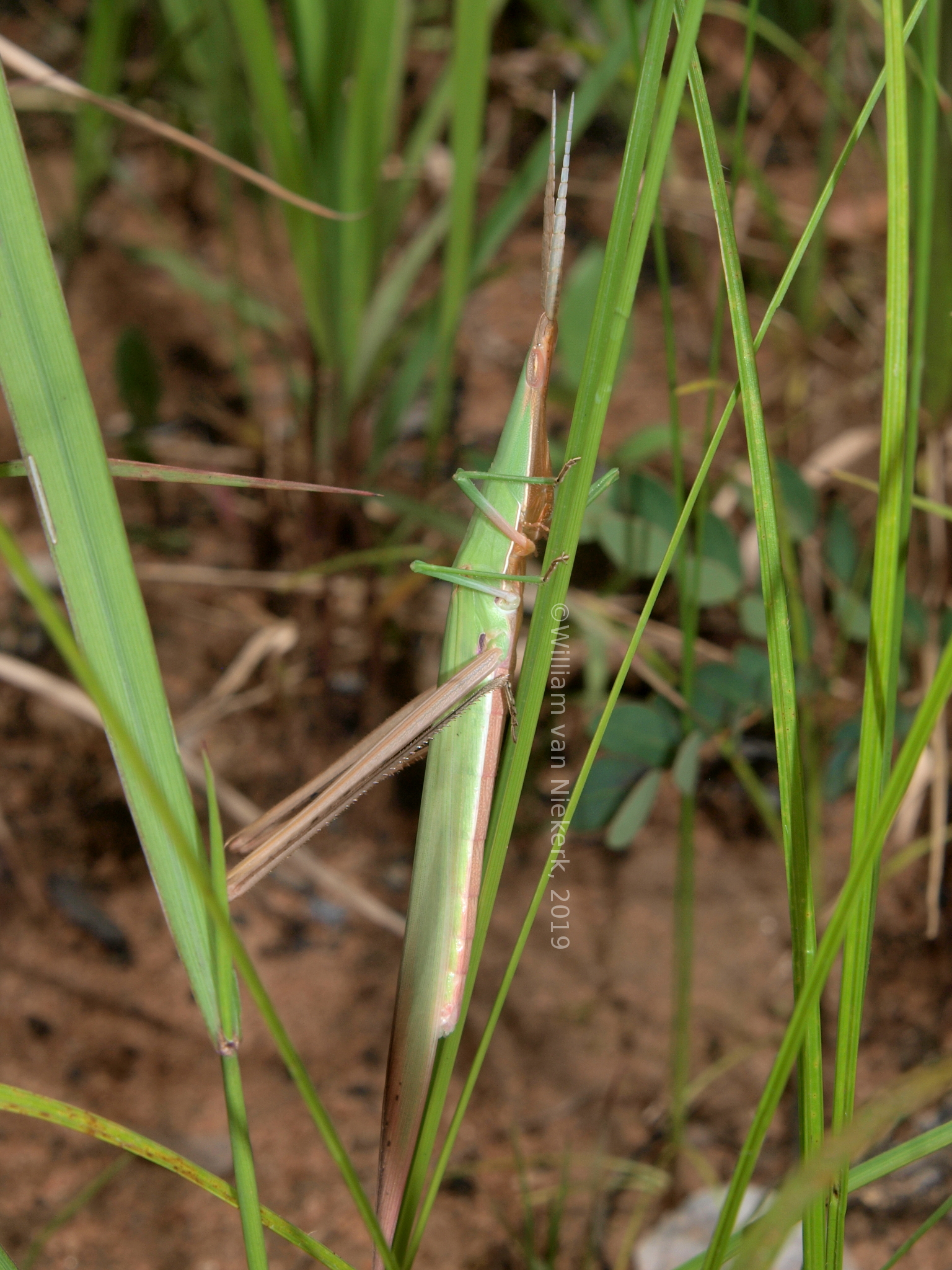
- Acrida acuminata – Widespread. Common in grassland and woodland throughout the wilderness area; likely not the only Acrida species present.
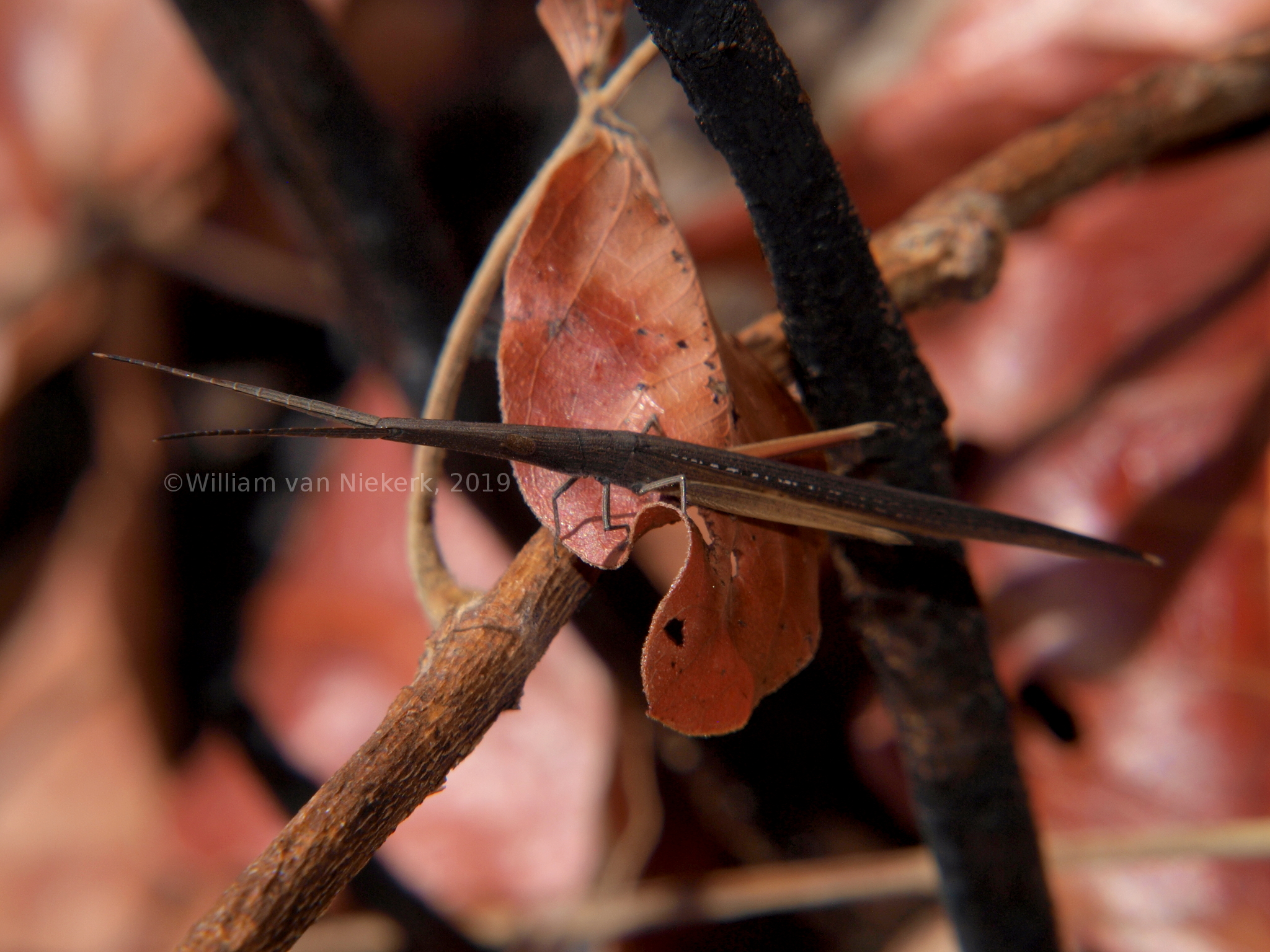
- Cannula gracilis – Widespread. Readily overlooked in grassy open woodland areas throughout the site; colour form varies with season (and fire).
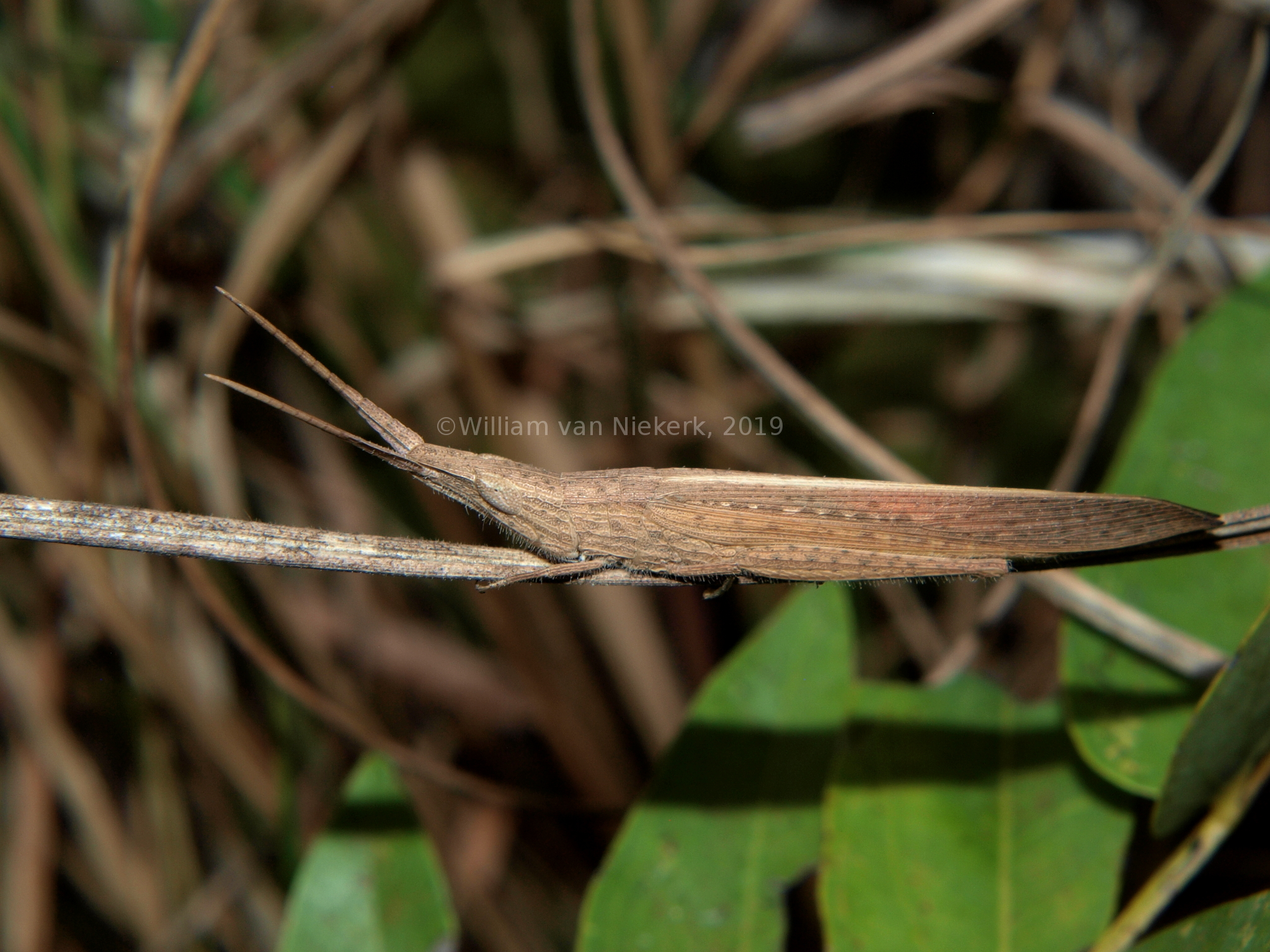
- Glyphoclonus miripennis – Widespread. Rarely common, but usually present in dry woodland areas.
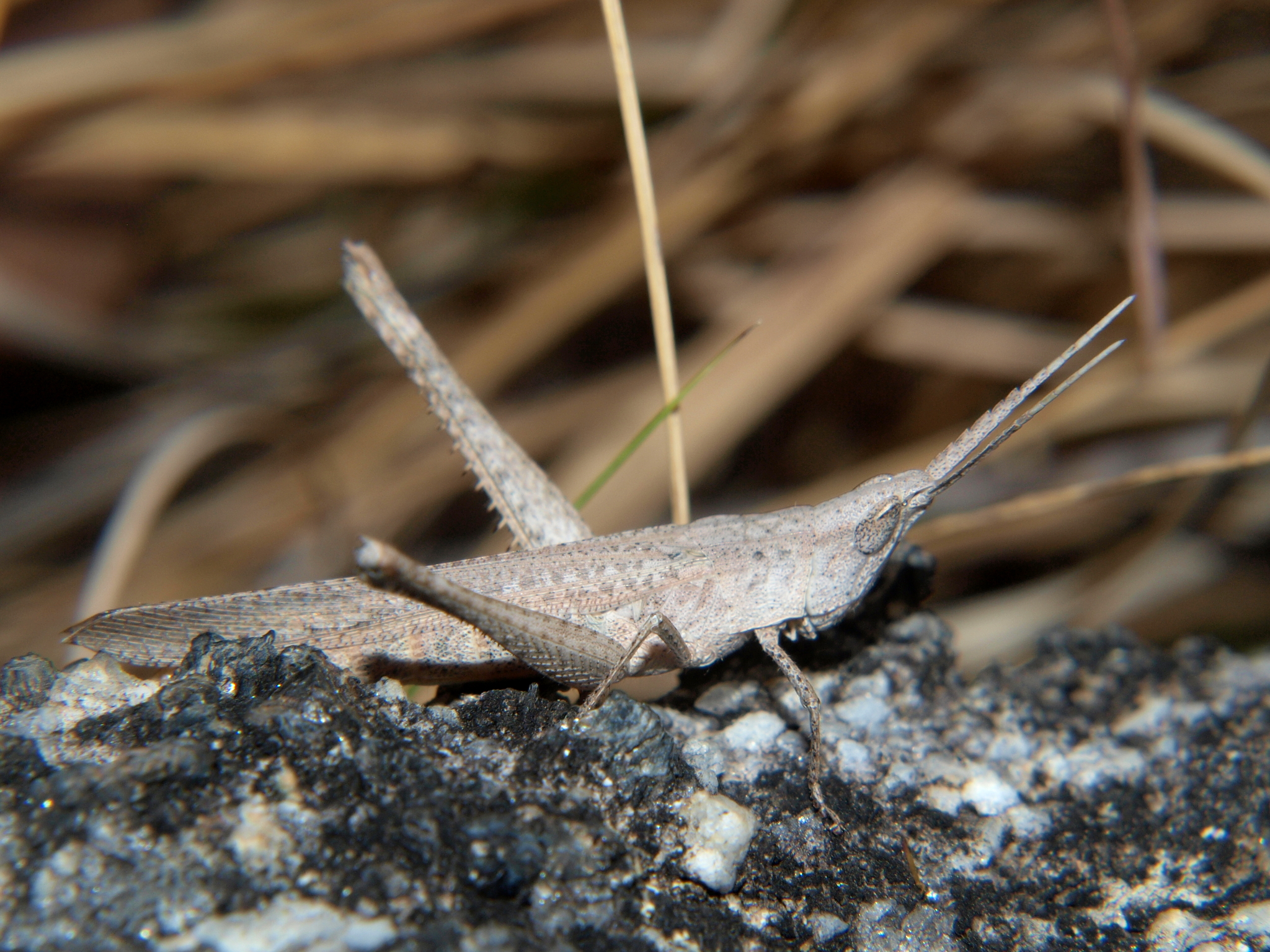
- Machaeridia conspersa – Widespread. Common in grassy woodland and woodland edge habitats.
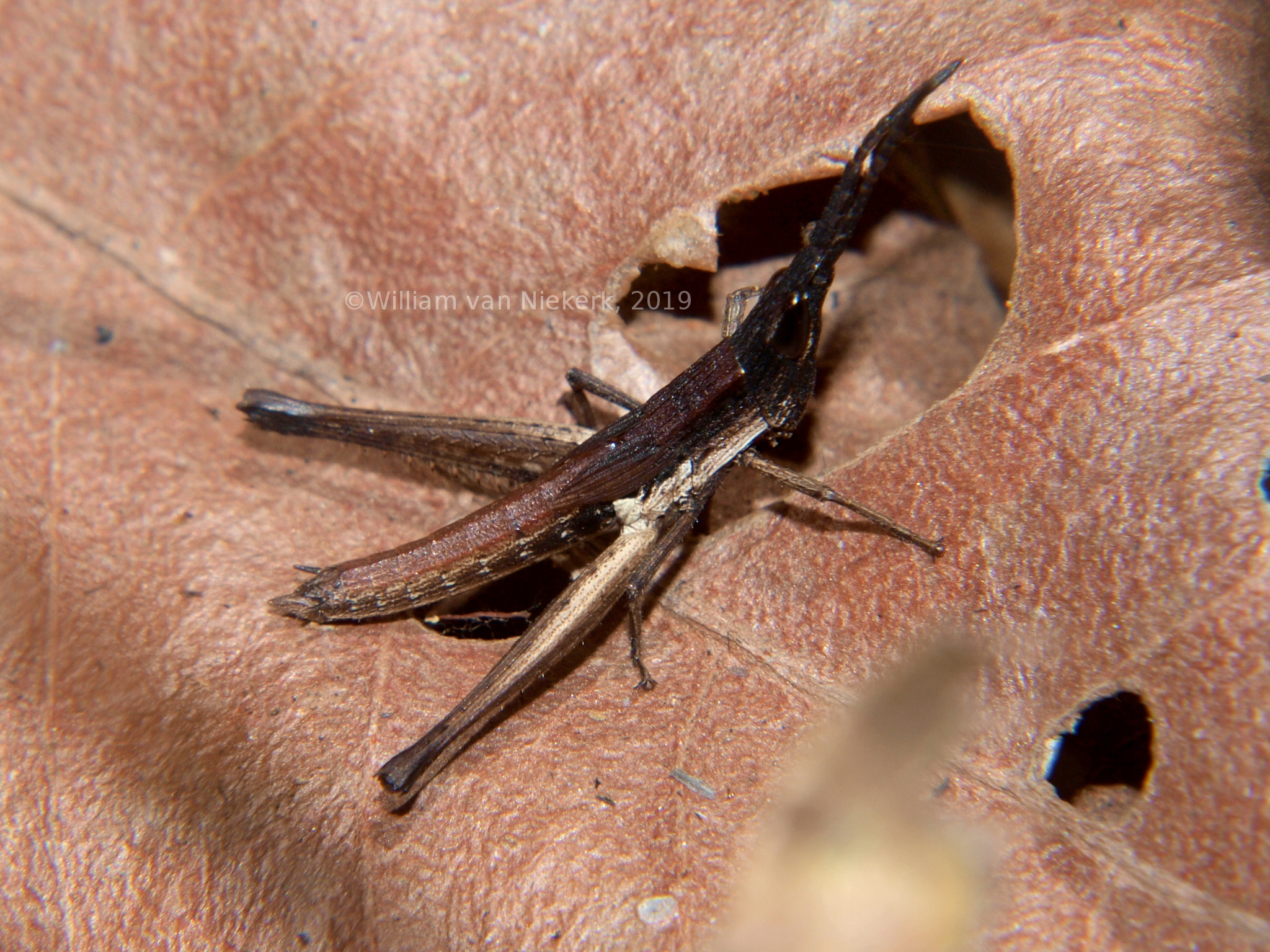
- Odontomelus zambiensis – Apparently endemic to Zambia; previously known only from near Mbala.
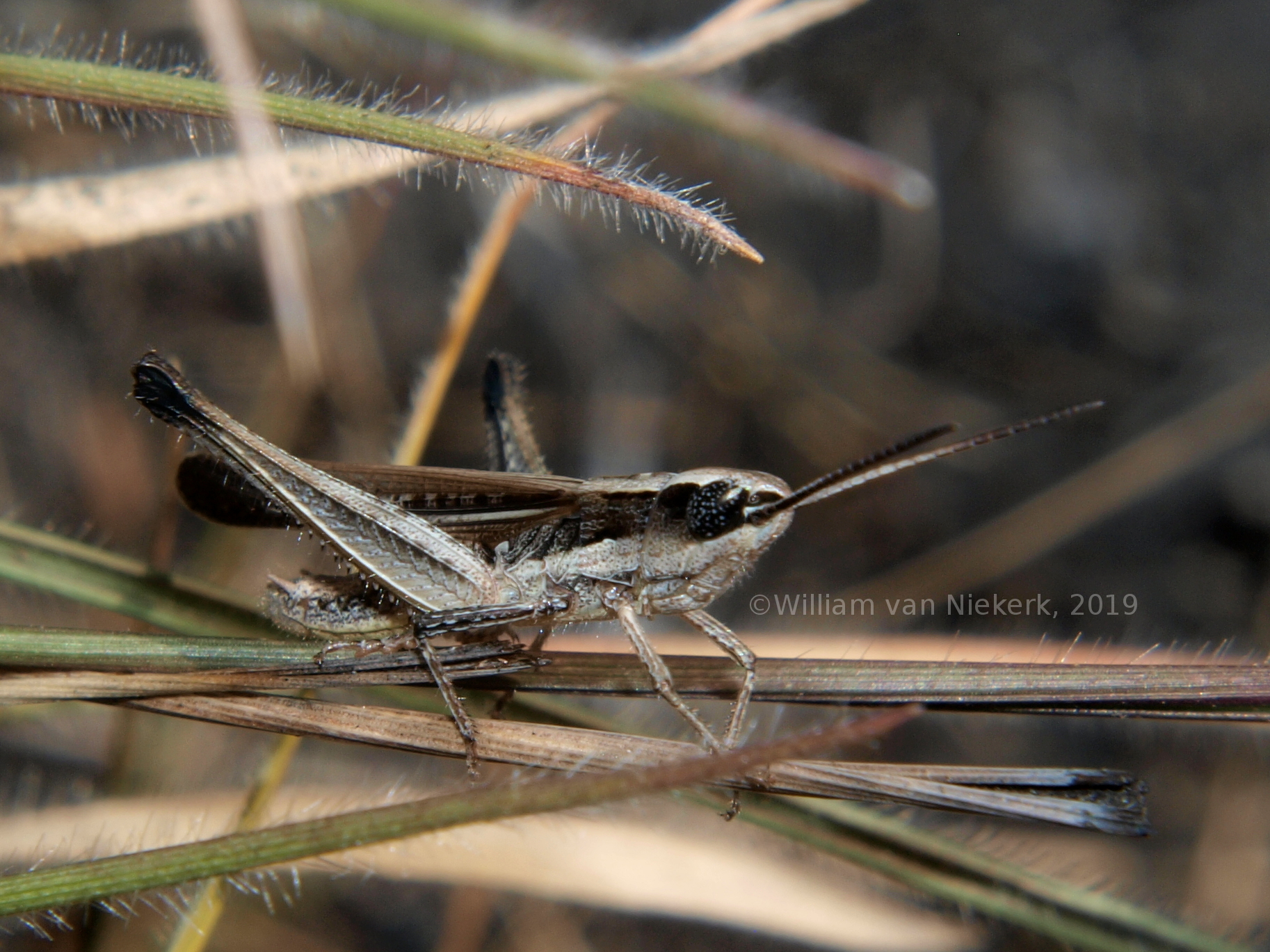
- Gymnobothrus lineaalba – Widespread. At Mutinondo, recorded only in dambo grasslands to date, but elsewhere common in miombo. As with most Gymnobothrus, highly variable in colouring.
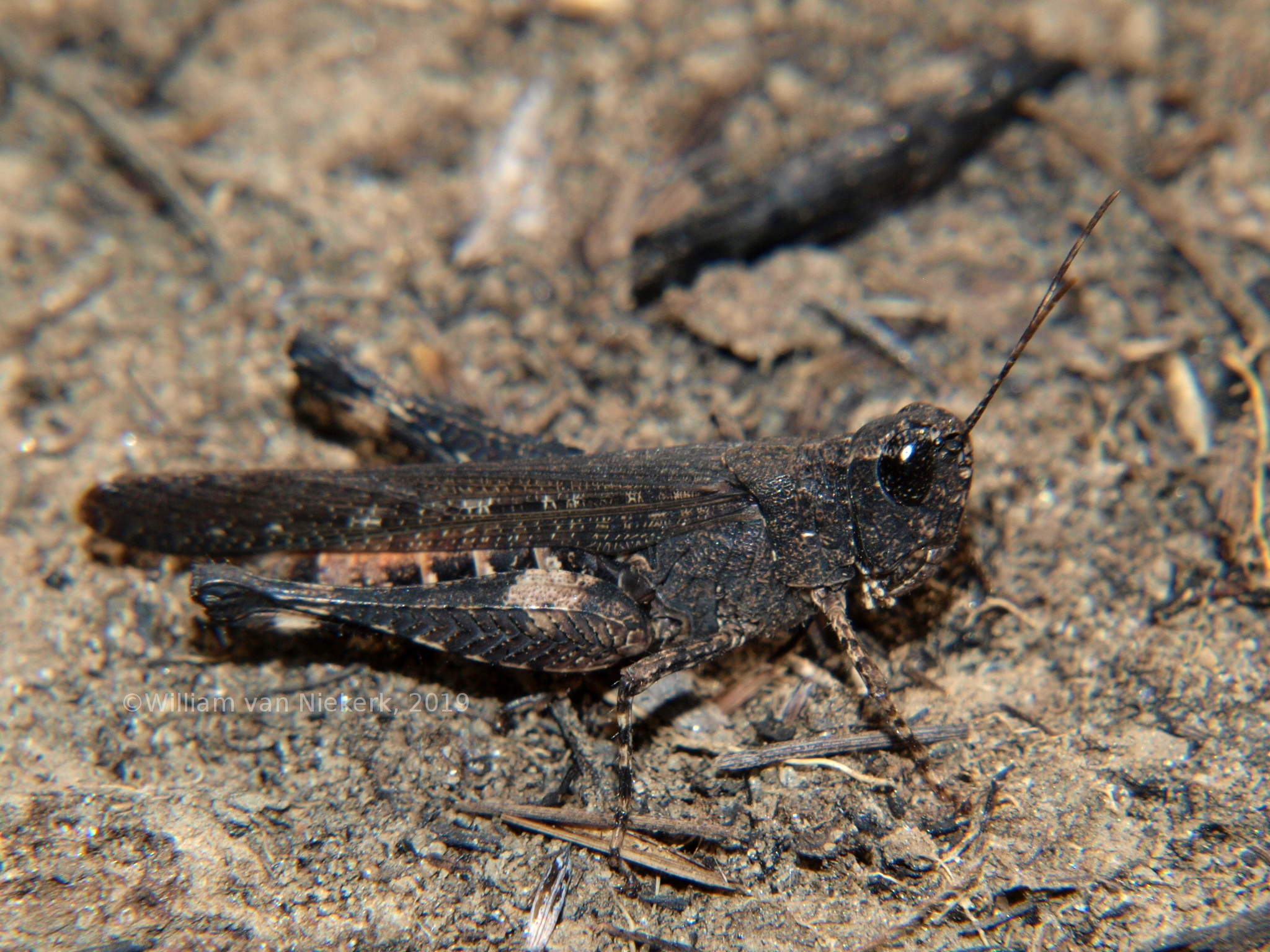
- Gymnobothrus temporalis – Widespread. Recorded in dambos and riverine woodland (not mushitu), but likely in miombo as well.
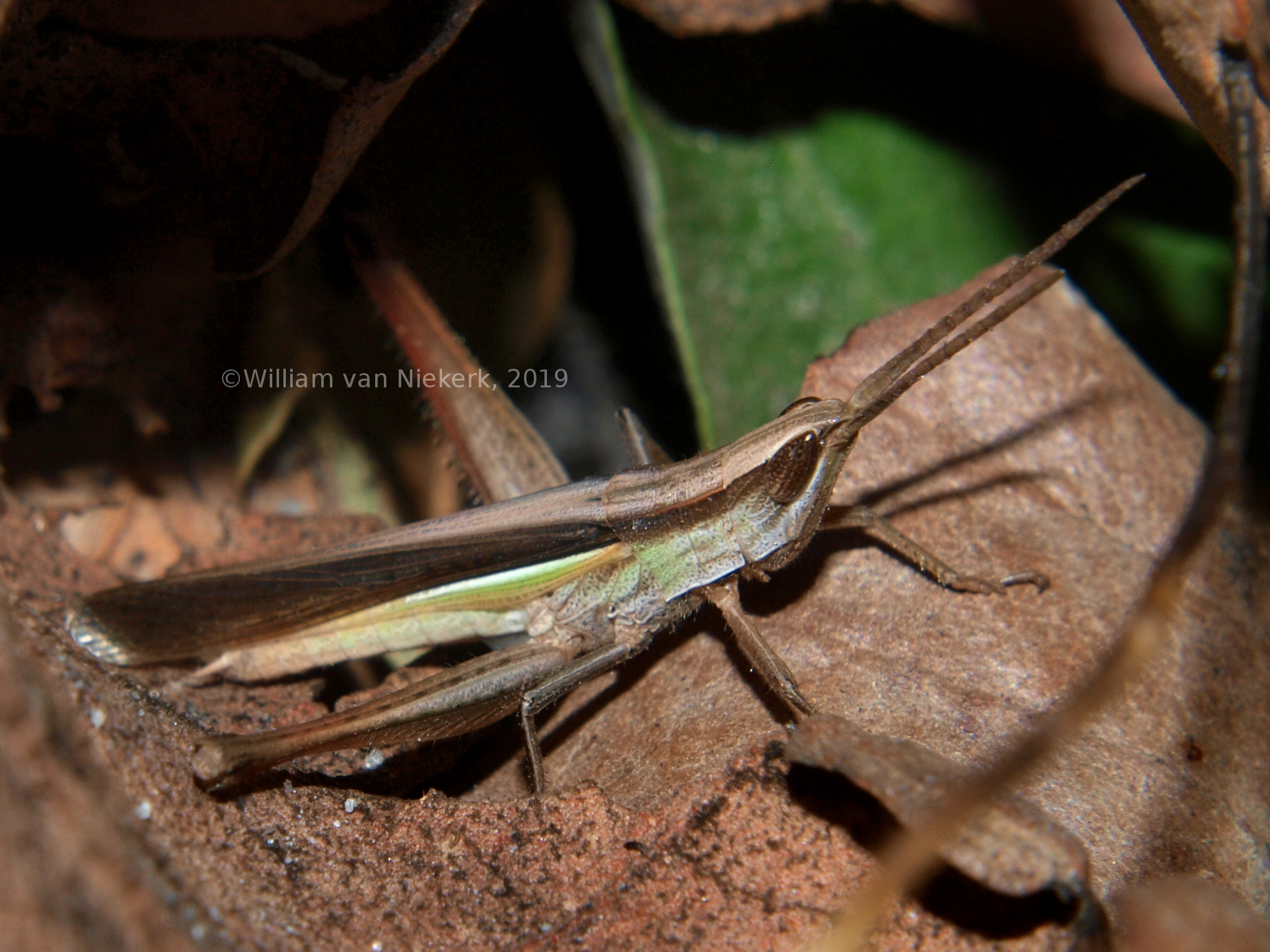
- Orthochtha dasycnemis – Widespread. Abundant in dambo grasslands, spreading into woodland during rainy season.
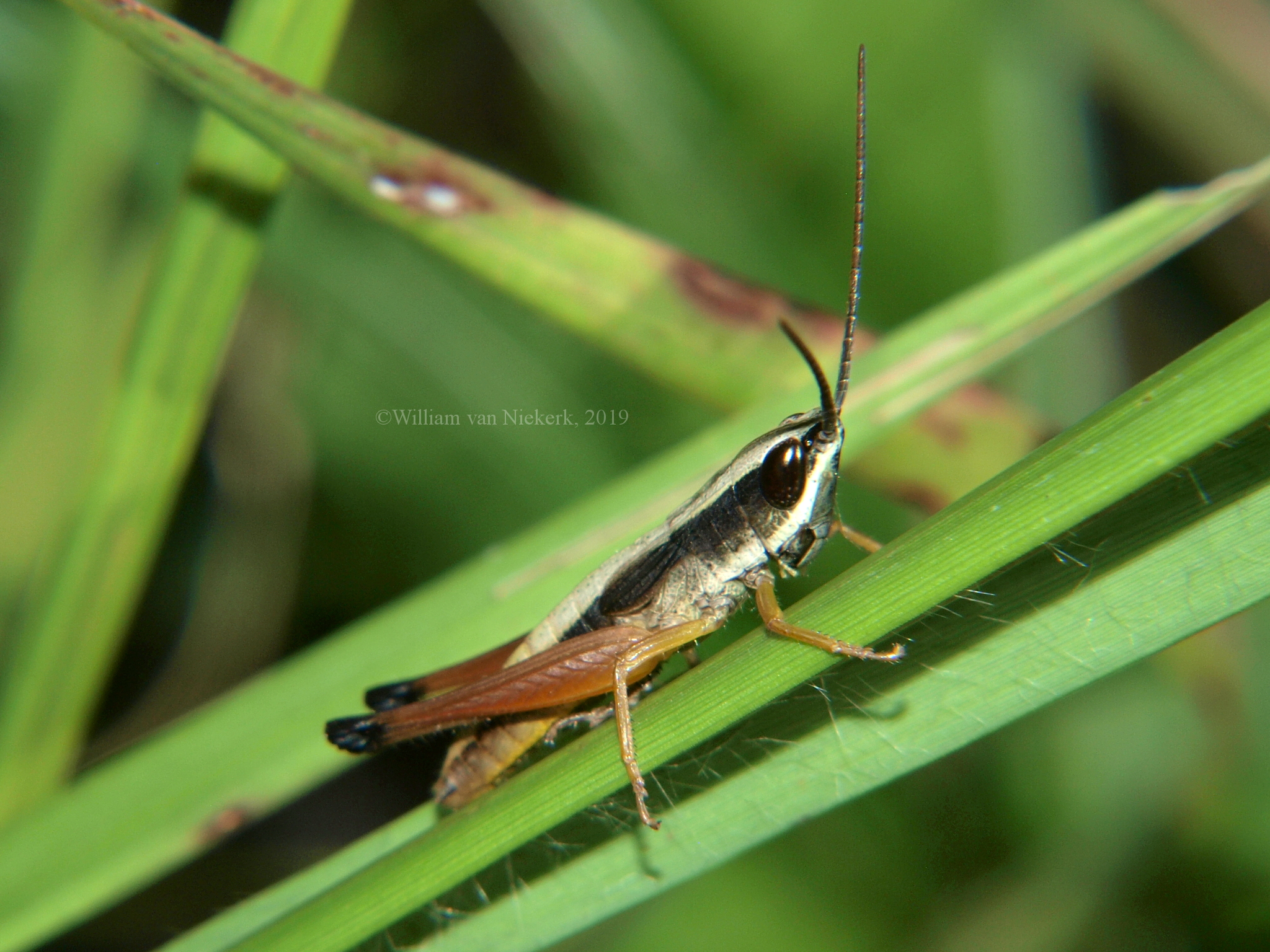
- Parodontomelus brachypterus – Records restricted to Tanzania and Zambia, probably extending in Malawi, D.R.C. and Zimbabwe at the least. Common in dry grassland and dambo sites.
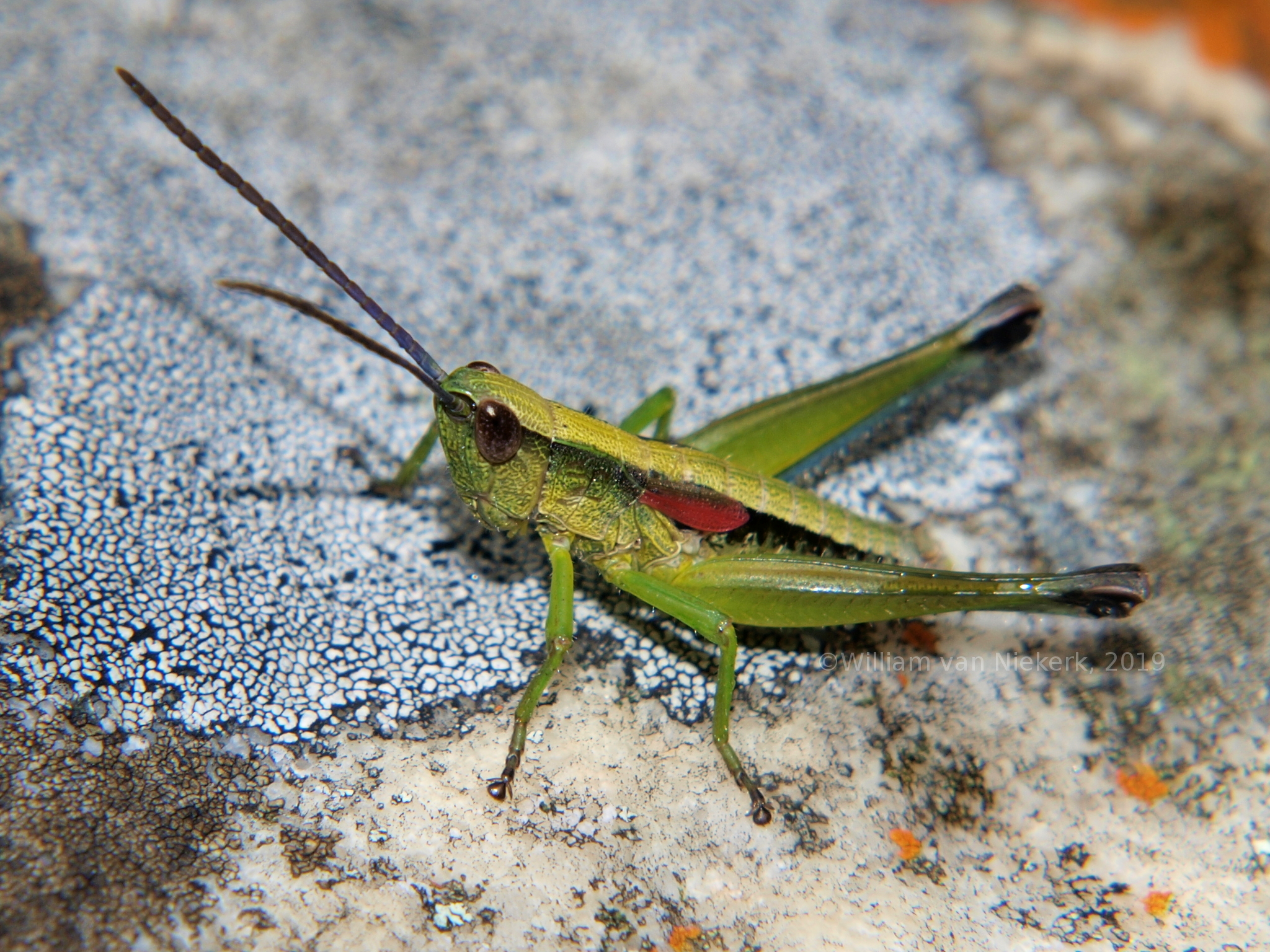
- Chokwea bredoi – near-endemic (Zambia/Malawi), at Mutinondo, on shallow-soiled grassland on granite pavement, and probably also seepage grassland . Image from Mafinga Mountains; Mutinondo image not yet prepared.
Gomphocerinae (Singing Slant-Faced Grasshoppers)
Males of most species sing by rubbing legs against wings (stridulating); often highly variable in colour and form. Usually associated with grasses and sedges; some species seemingly limited to grassy areas on inselbergs.
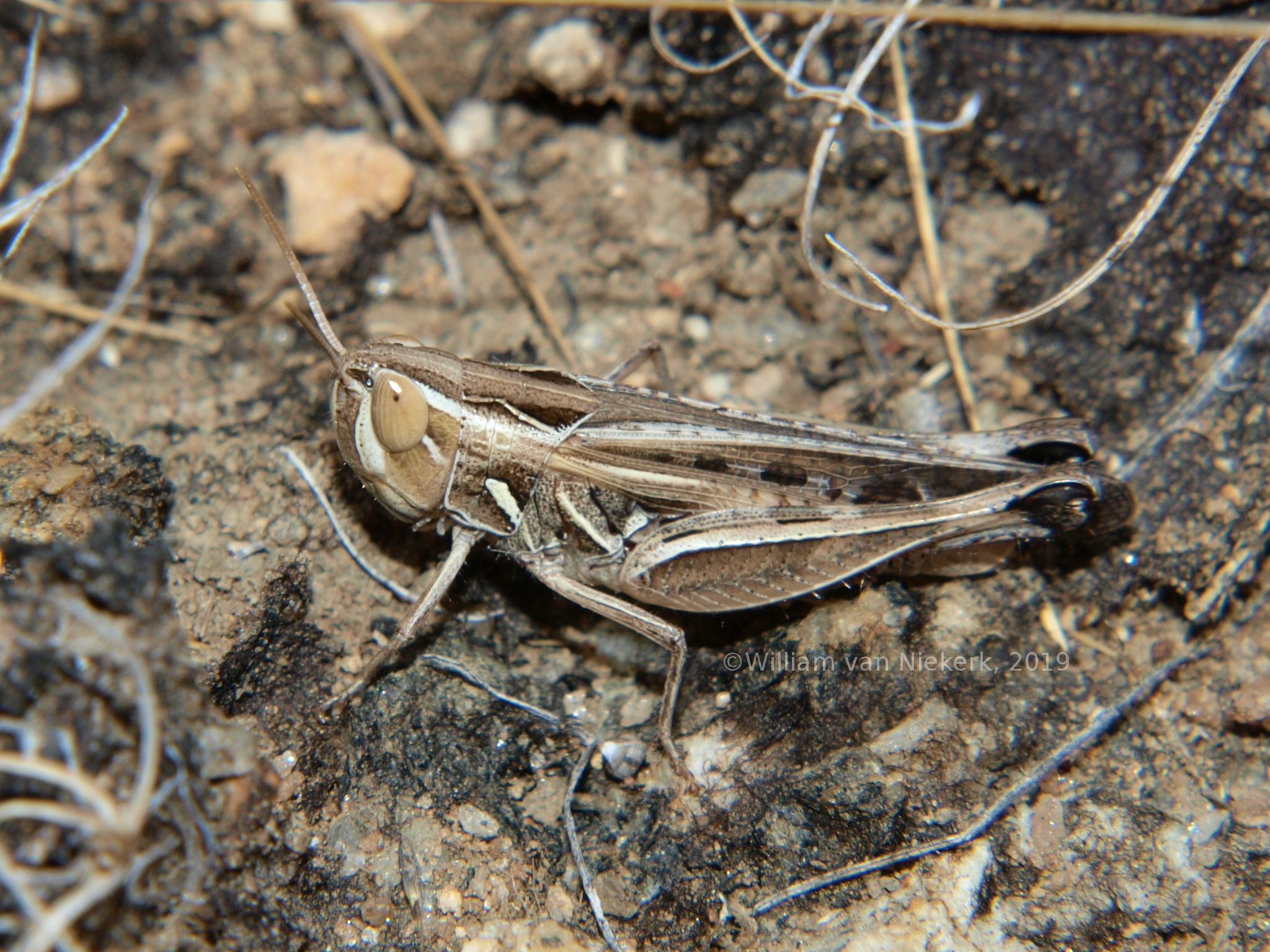
- Aulacobothrus dorsatus – Widespread. Common in woodland, especially disturbed, grassy areas. Infrequently seen on inselbergs.
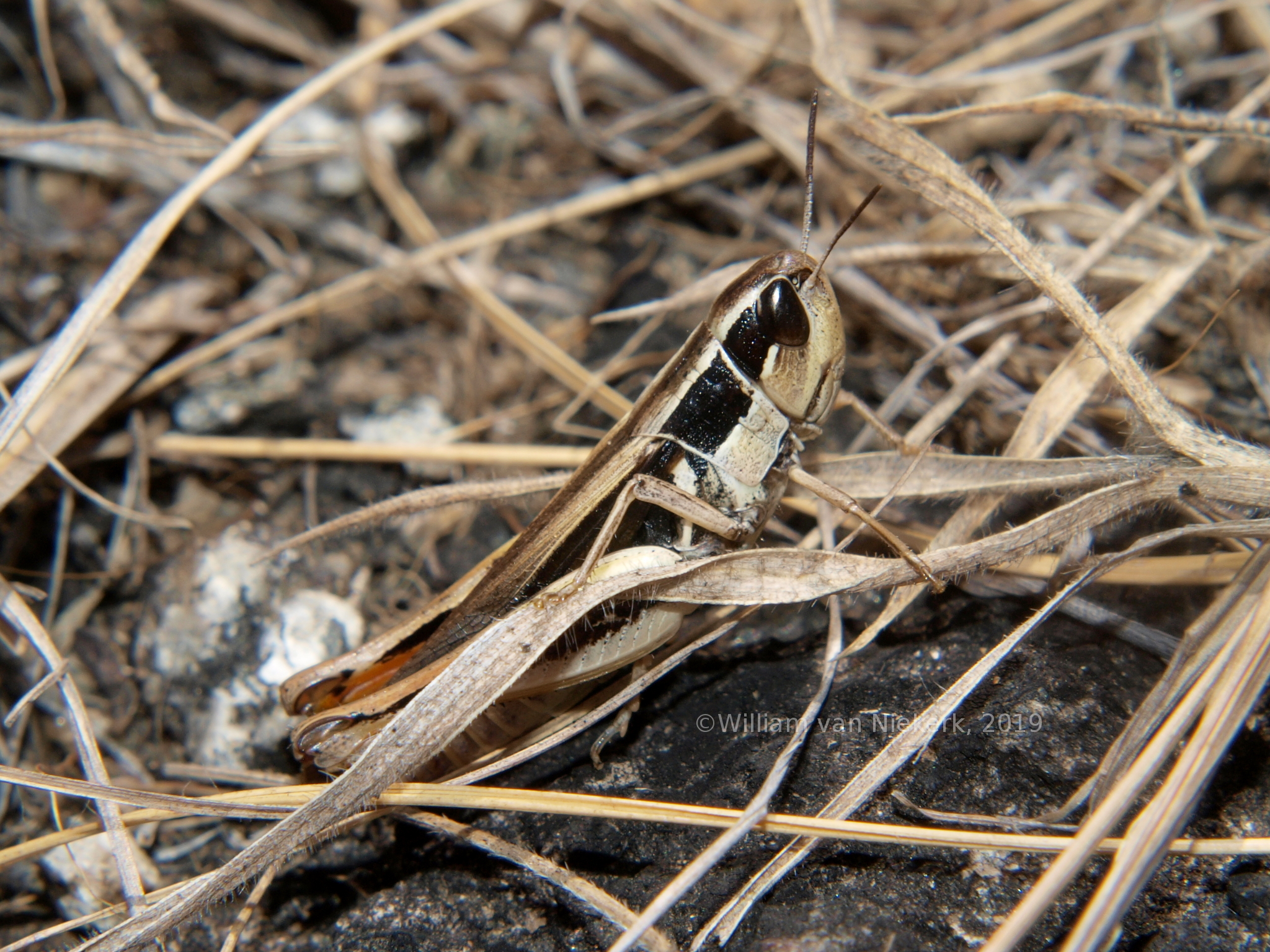
- Pnorisa squalus – Widespread. At Mutinondo, recorded only atop Mayense.
Spathosterninae
One species in the region: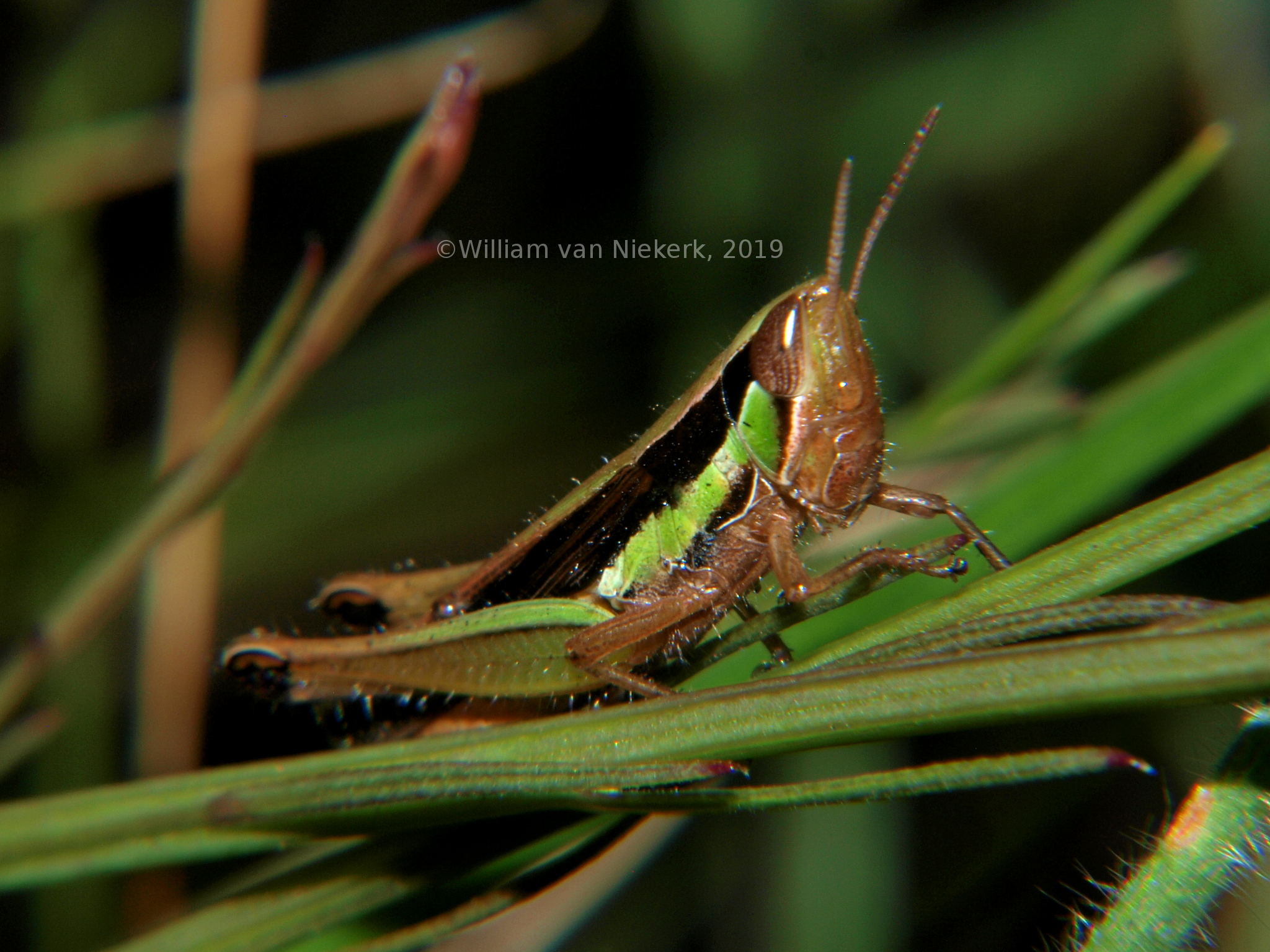
- Spathosternum nigrotaeniatum – Widespread. Common in most grassy areas, particularly riverbanks, swamps and dambo grasslands.
Tropidopolinae
Usually limited to grassy areas; presumably feeding on a range of grasses and grass-seeds.
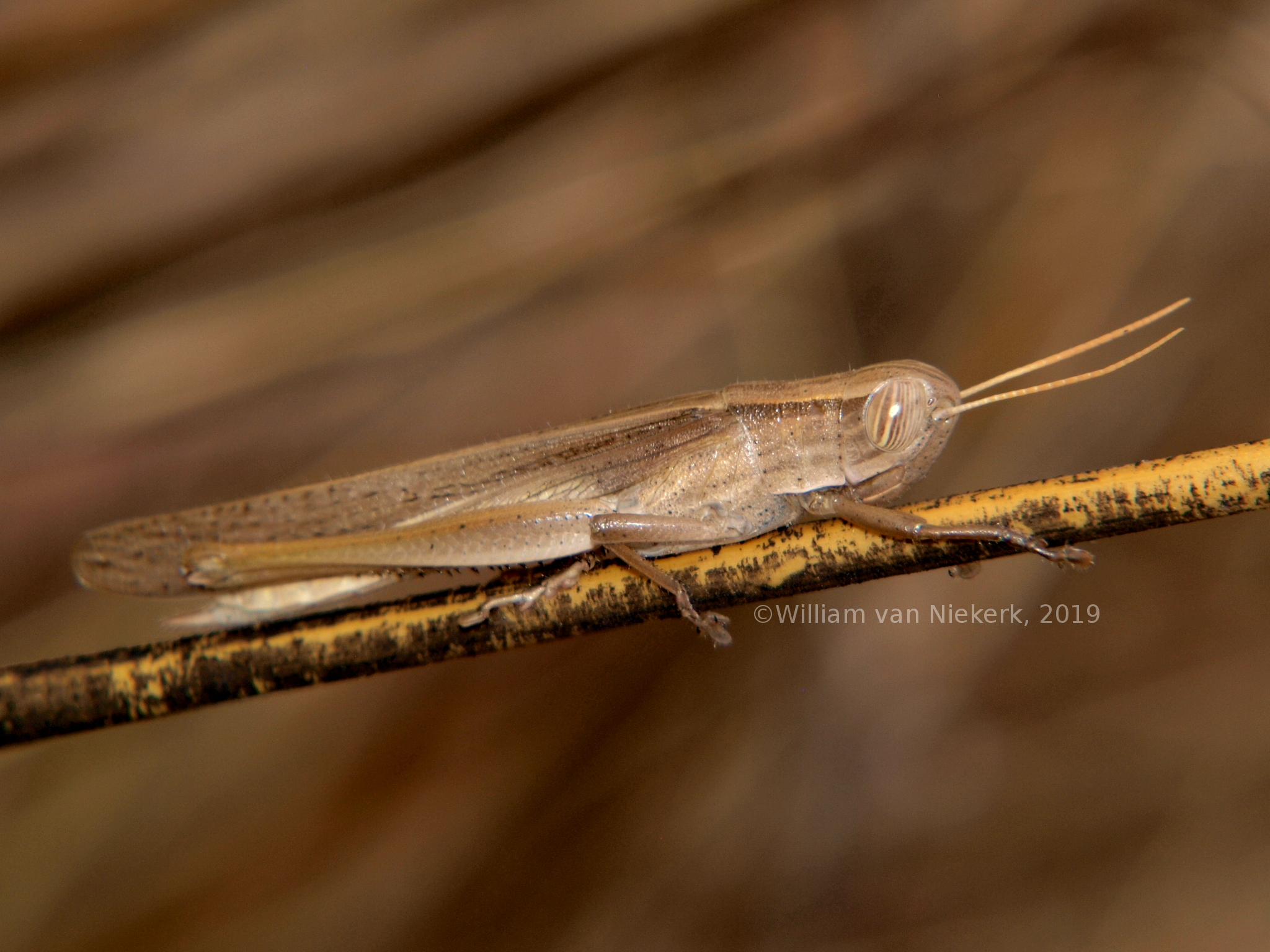
- Petamella fallax – Widespread in Tropical Africa south of the Congo River; apparently limited to Dambo grasslands at Mutinondo.
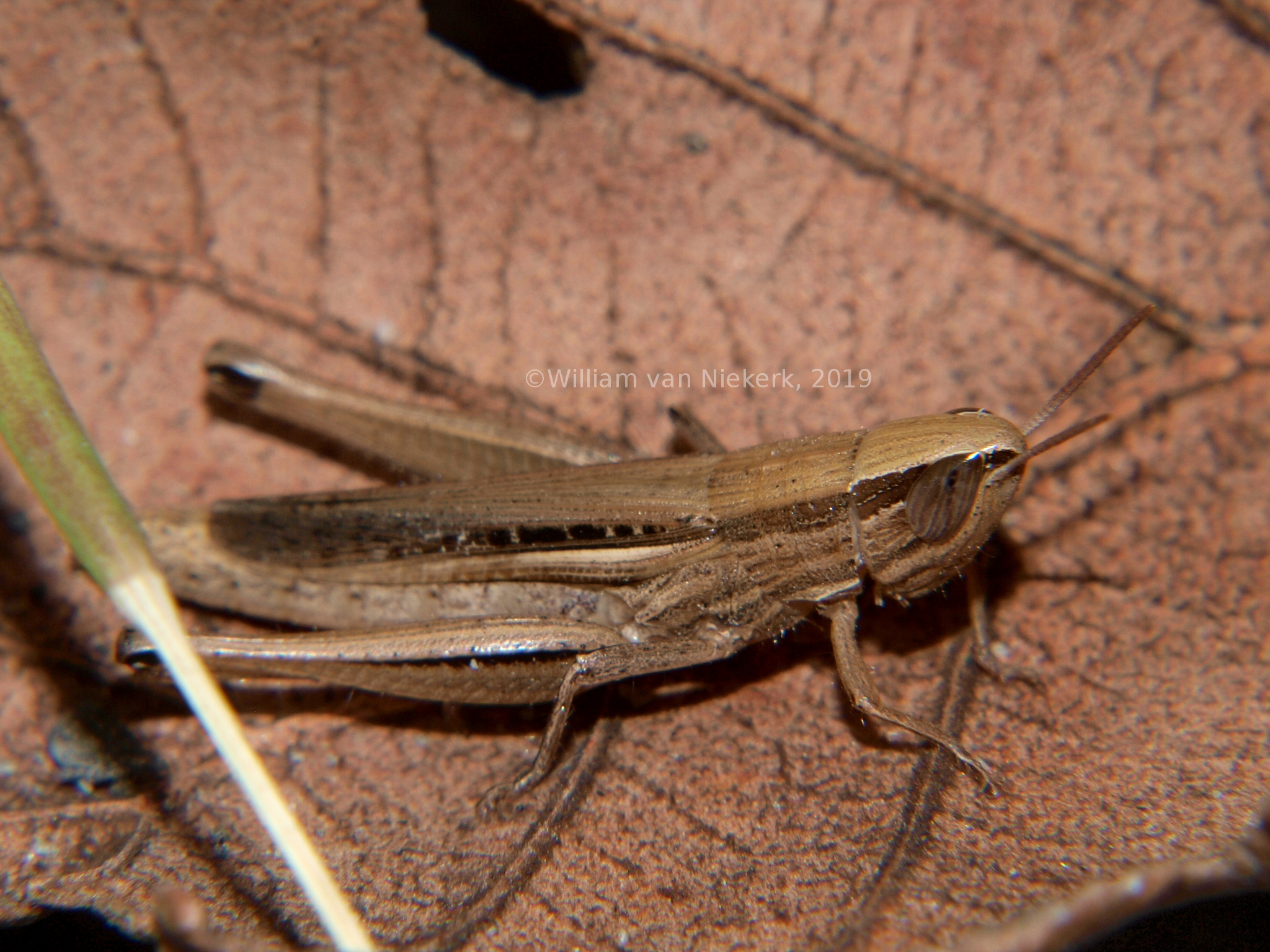
- Tristria angolensis – known from Zambia to the Republic of Congo; Mpika population was originally designated as an endemic species (T. dimorpha), synonymised in the 1960’s. Abundant in most grassy areas, including dambos.
Hemiacridinae
Diverse in form and preferred habitat, with species variously abundant in grassland, woodland canopy and deep leaf-litter.
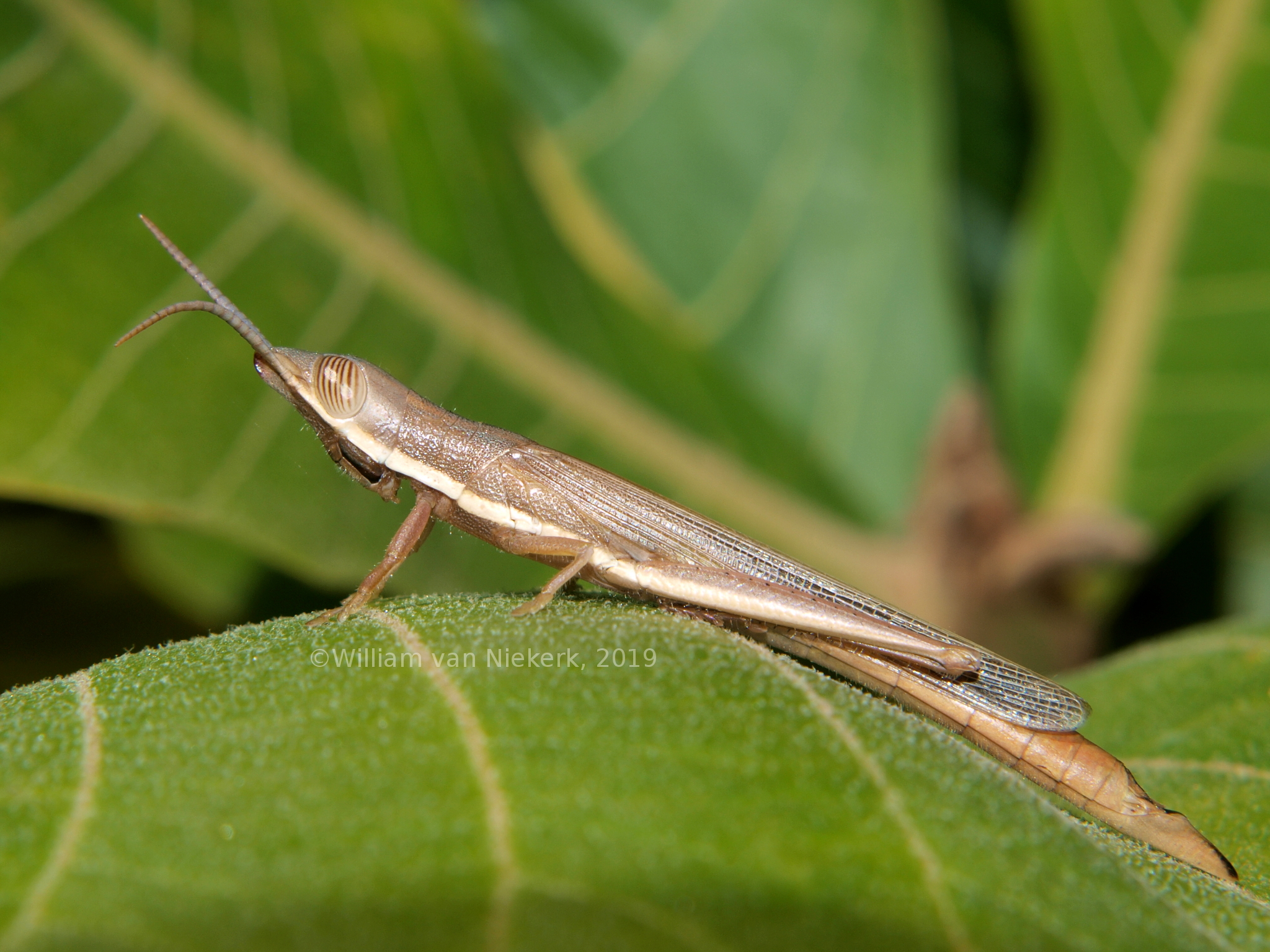
- Leptacris kraussi – generally rare, only recorded in dambo grassland.
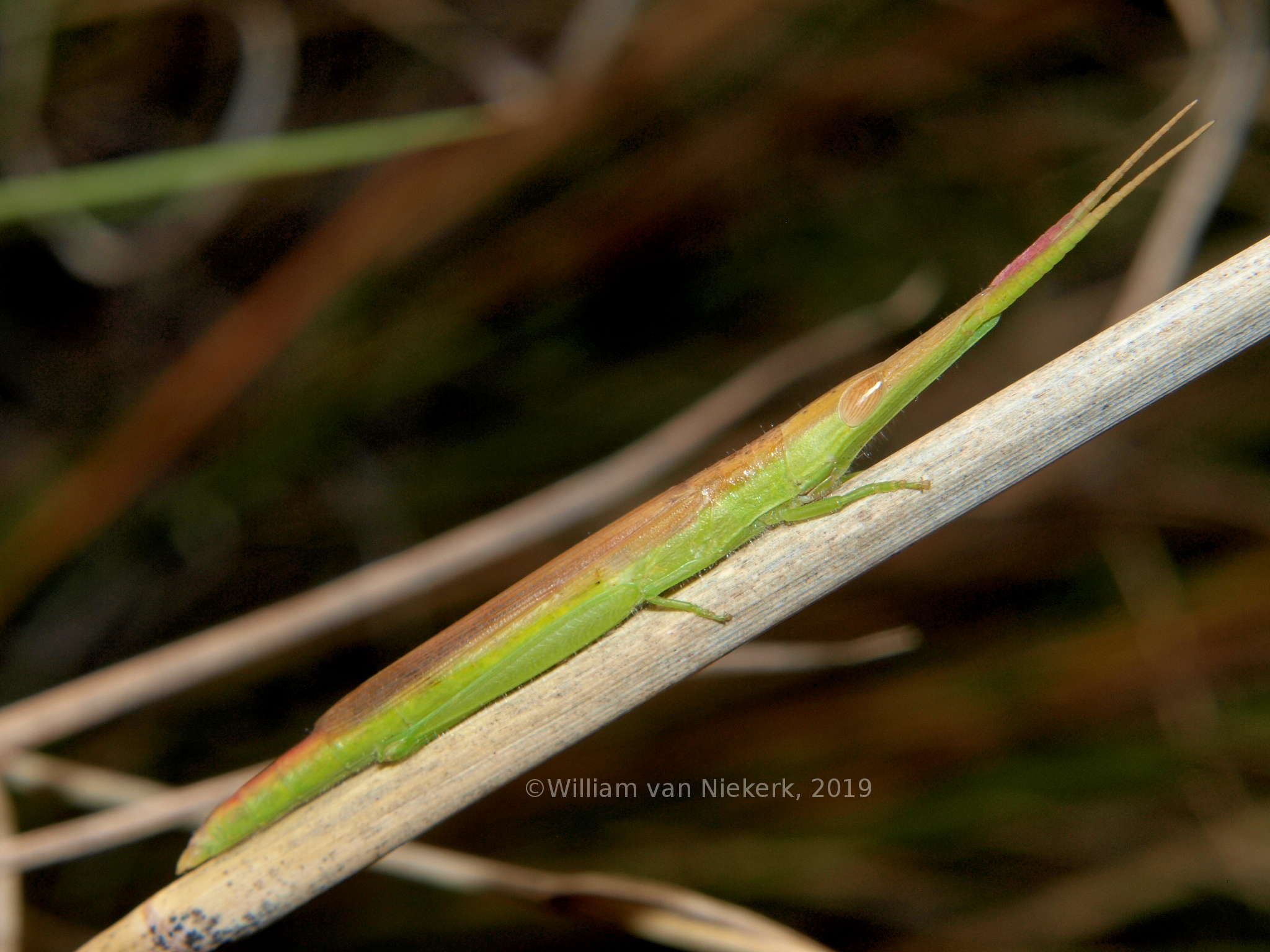
- Mesopsera filum – Widespread in Sub-equatorial tropical Africa. Fairly common in dambo grassland and occasionally open woodland, especially late in the rains. Several externally similar species (including Cannula) in other subfamilies known from the region.
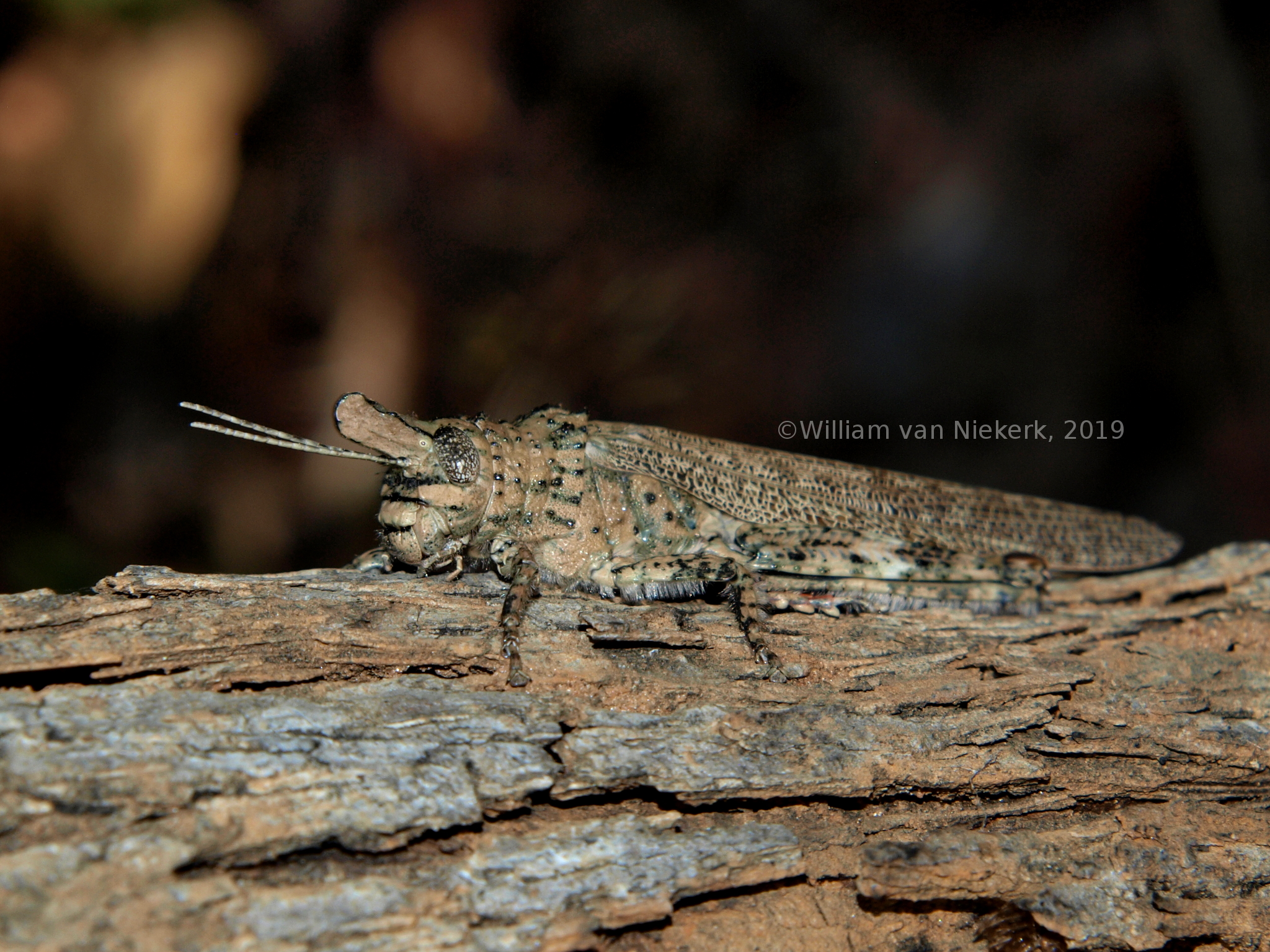
- Pristocorypha corneola – members of genus Pristocorypha underrecorded throughout their (wide) range, no previous Zambian records found; records of P. corneola apparently limited to East Africa. At Mutinondo associated with mature riparian woodland, where it is hard to spot among bark and lichen.
Coptacridinae
Usually associated with perennial and annual broad-leaved plants, often in dense woodland or mushitu.
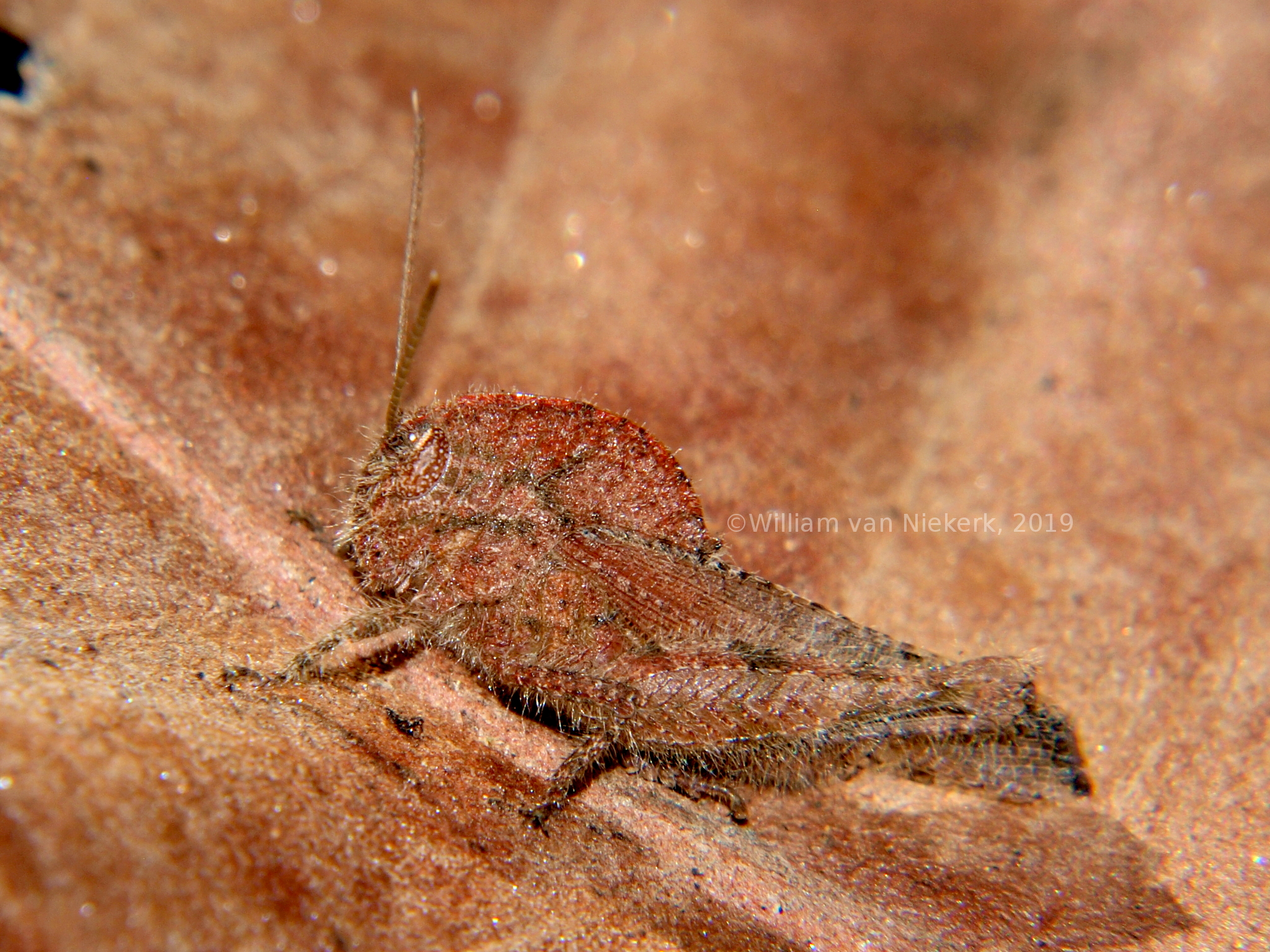
- Bocagella acutipennis – Widespread in Western and East Africa, but Mutinondo record appears to be first for this species in Zambia.
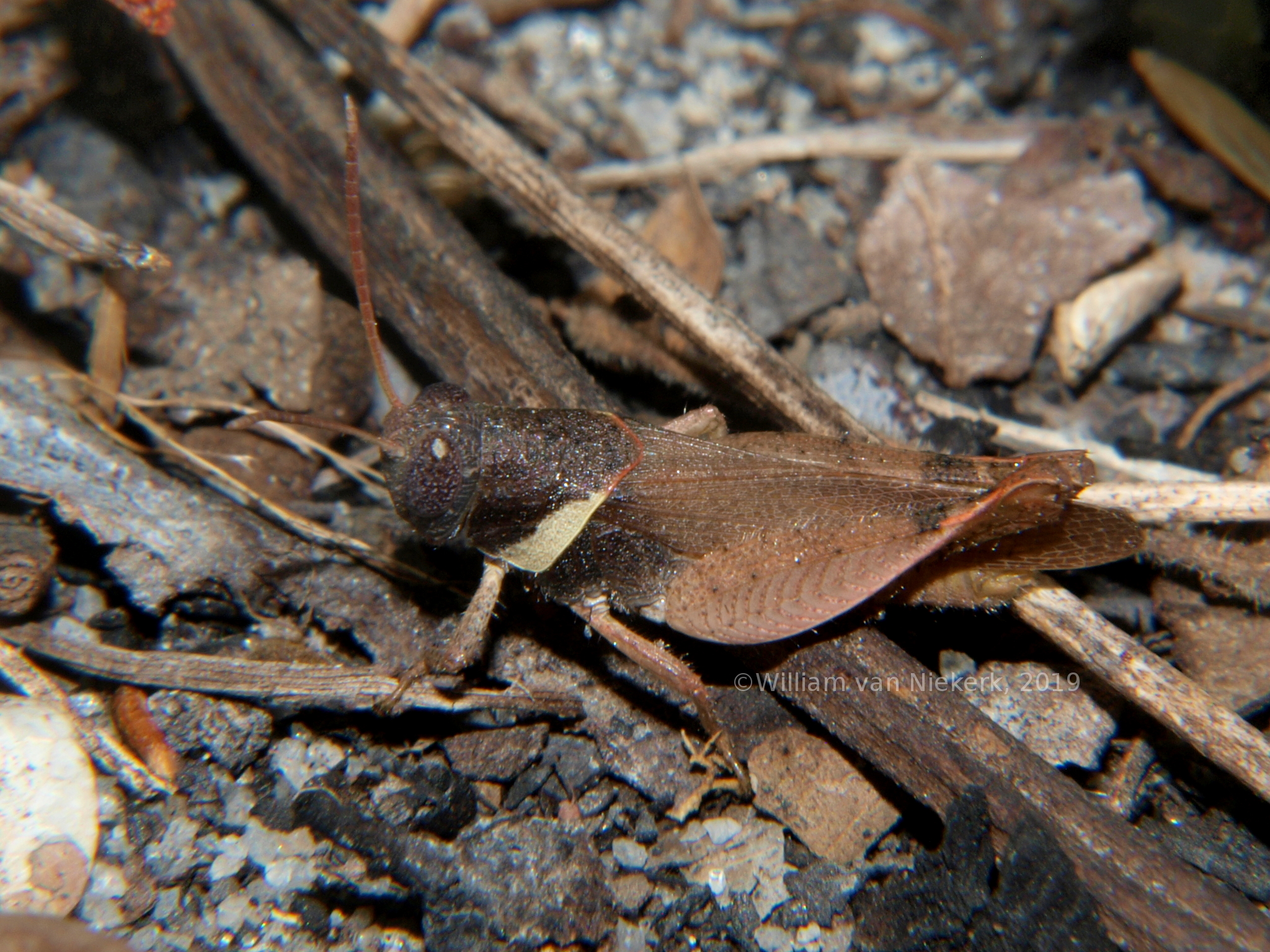
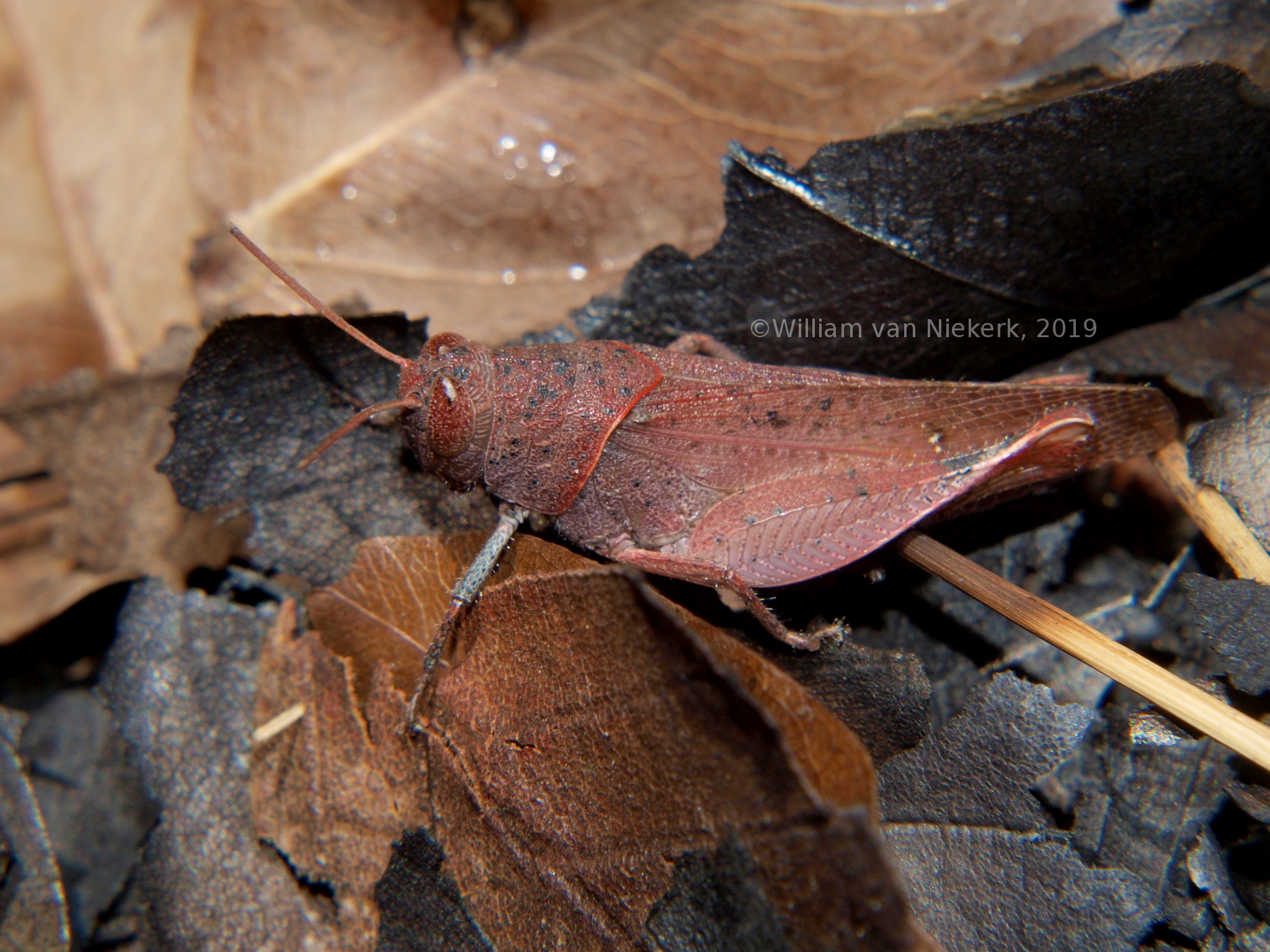
- Eucoptacra torquata – Widespread. Usually common in dense woodland; commonly seen in woodland and dambo following fires. (Male is shown above, the more plain-coloured female is shown below)
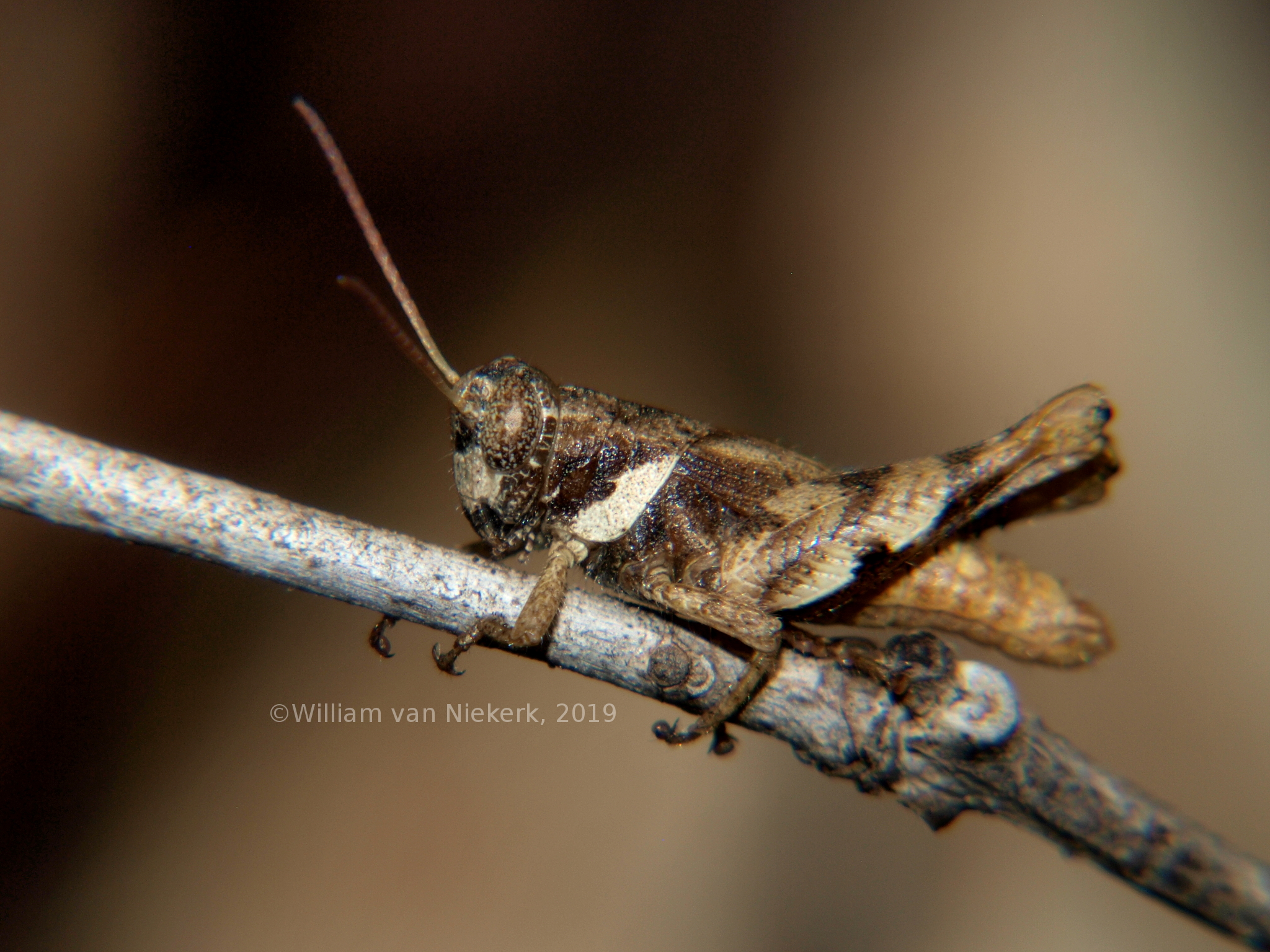
- Eucoptacra sheffieldi – originally described from Mpika, and currently known only from Zambia. Numerous similar Eucoptacra in Zambia and the wider region.
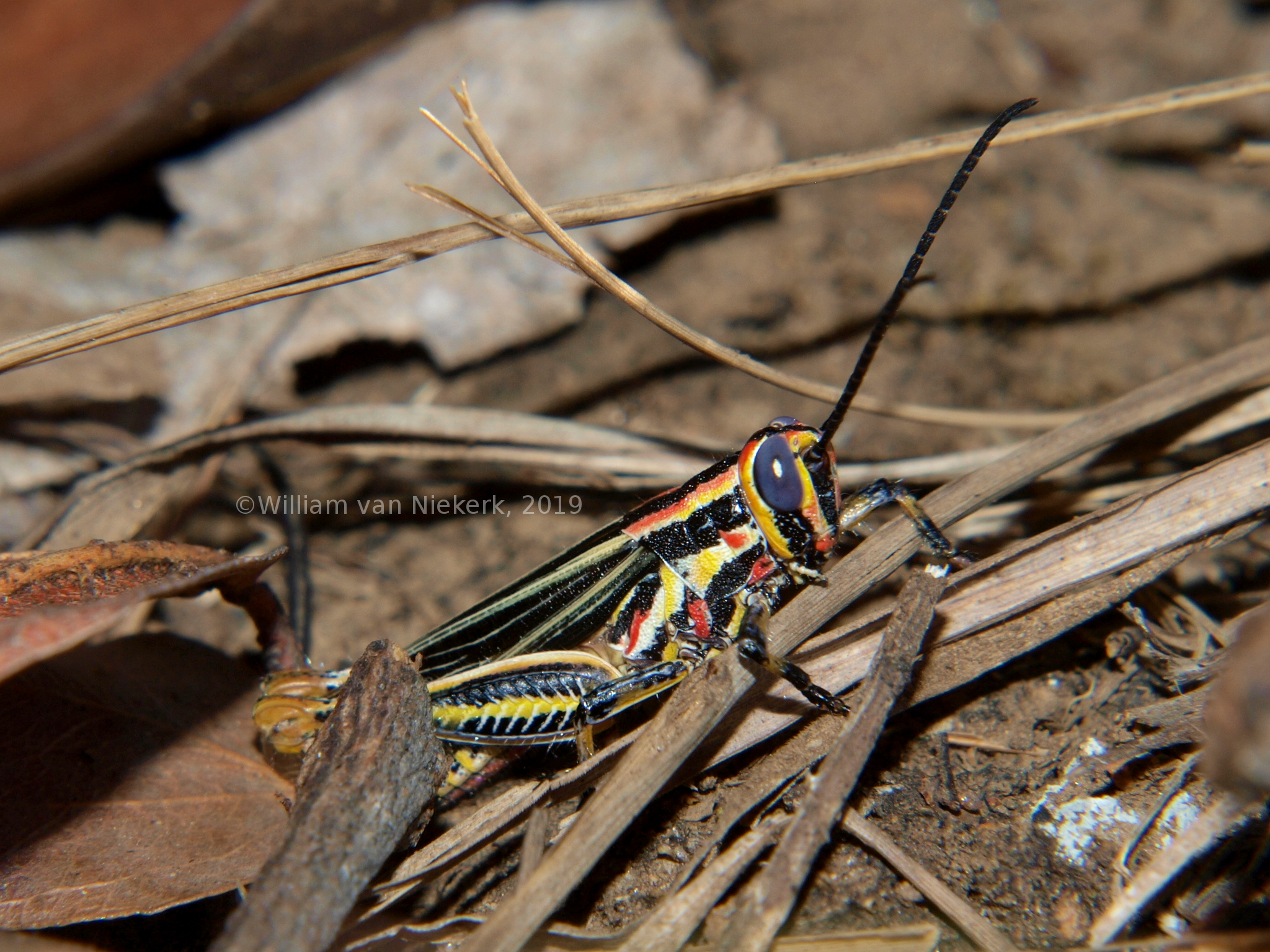
- Poecilocerastis striata – Widespread in East Africa and much of Zambia (replaced by P. tricolor in Copperbelt, and probably North-Western); typically present (rarely common) in woodland-edge, including transition to mushitu and dambo.
Catantopinae
Typically feeding on woody plants; often abundant.
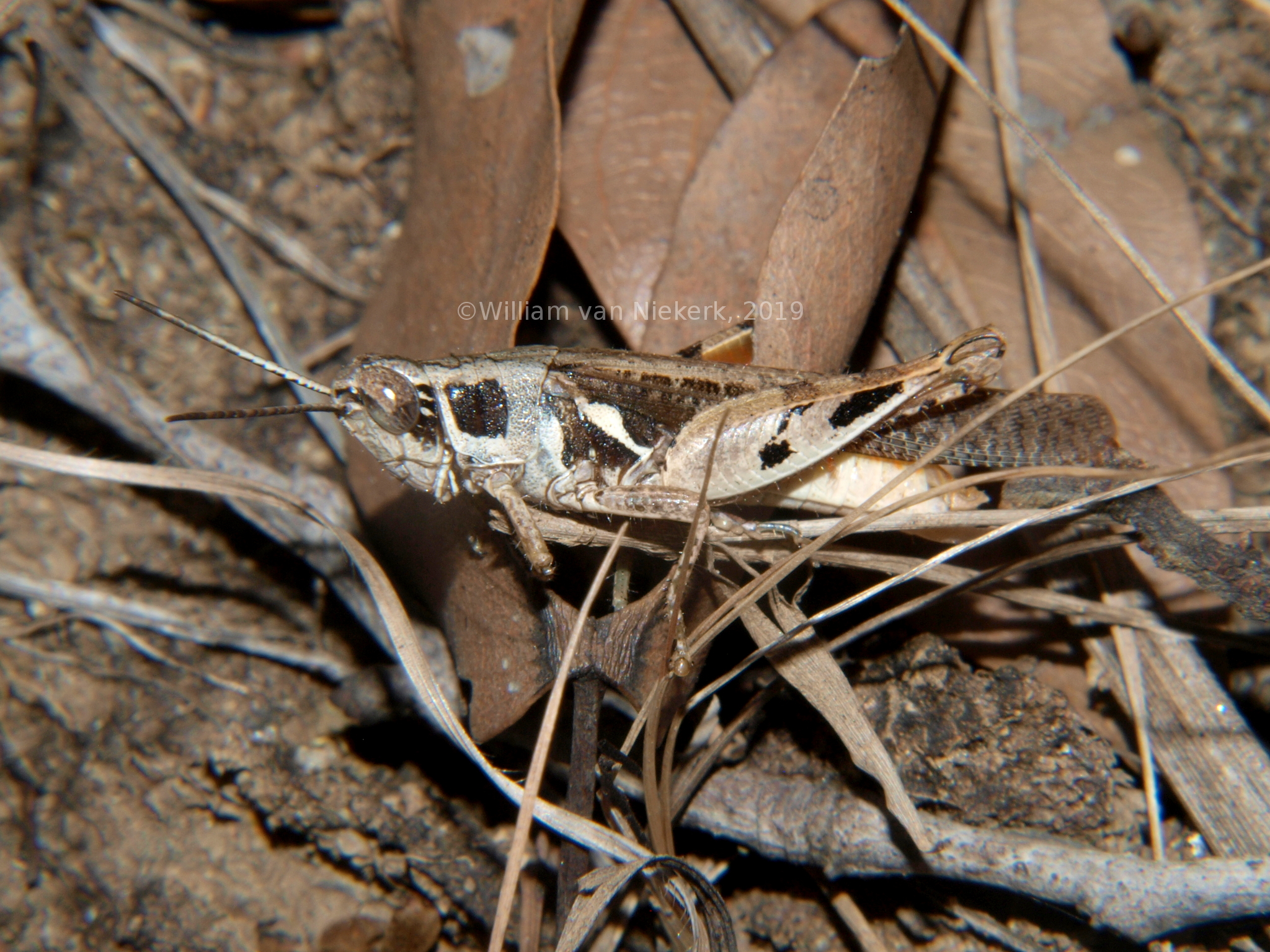
- Catantops melanostictus – Ubiquitous in the miombo belt. Often abundant in woodland, grasslands and disturbed areas. Clear separation from similar species (e.g. C. momboensis) relies the hammer-like expansions to the tip of the male cerci.
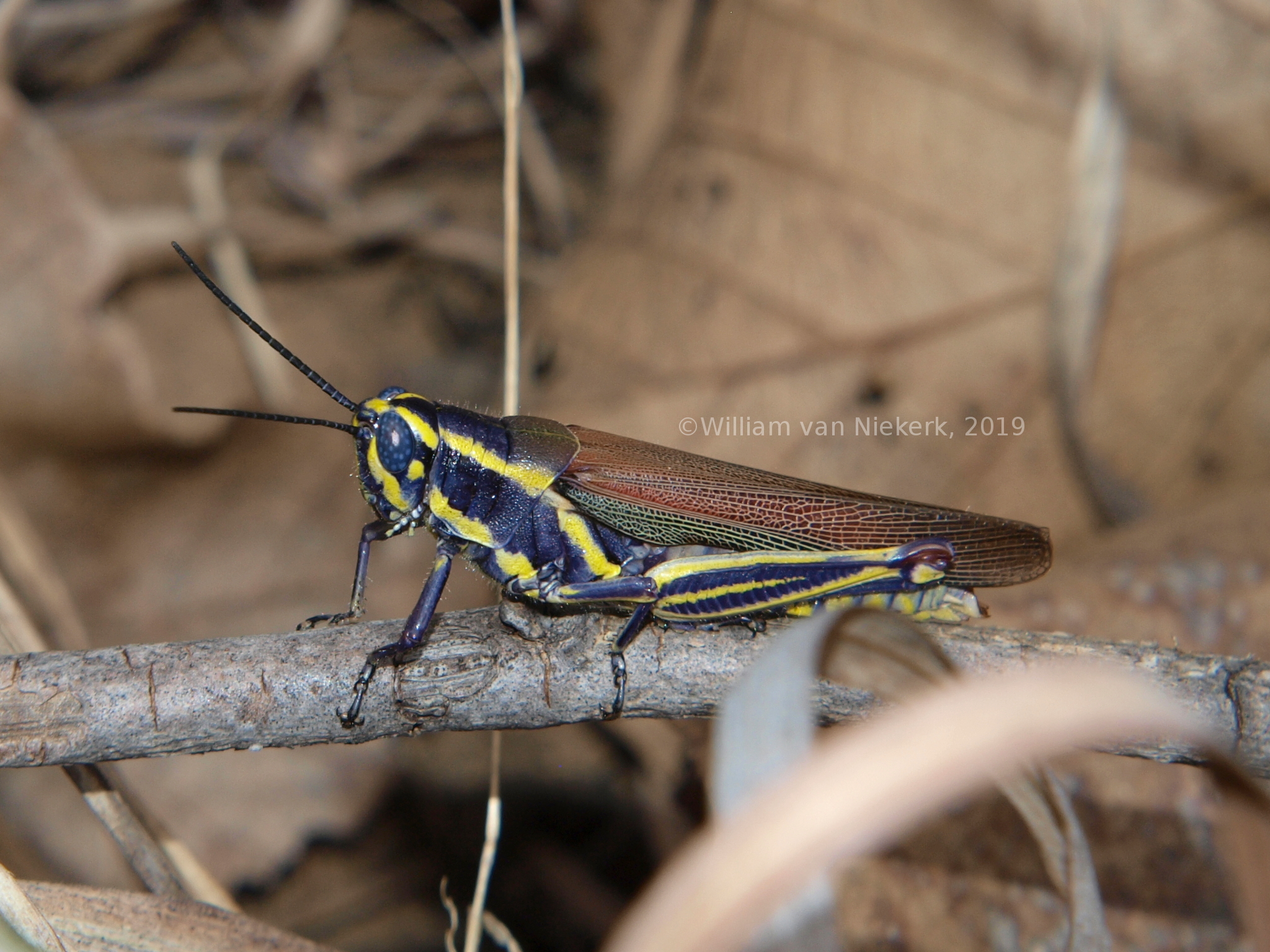
- Eupropacris cylindricollis – Widespread. Largely limited to wooded areas, often one of the most common true grasshoppers seen following fires.
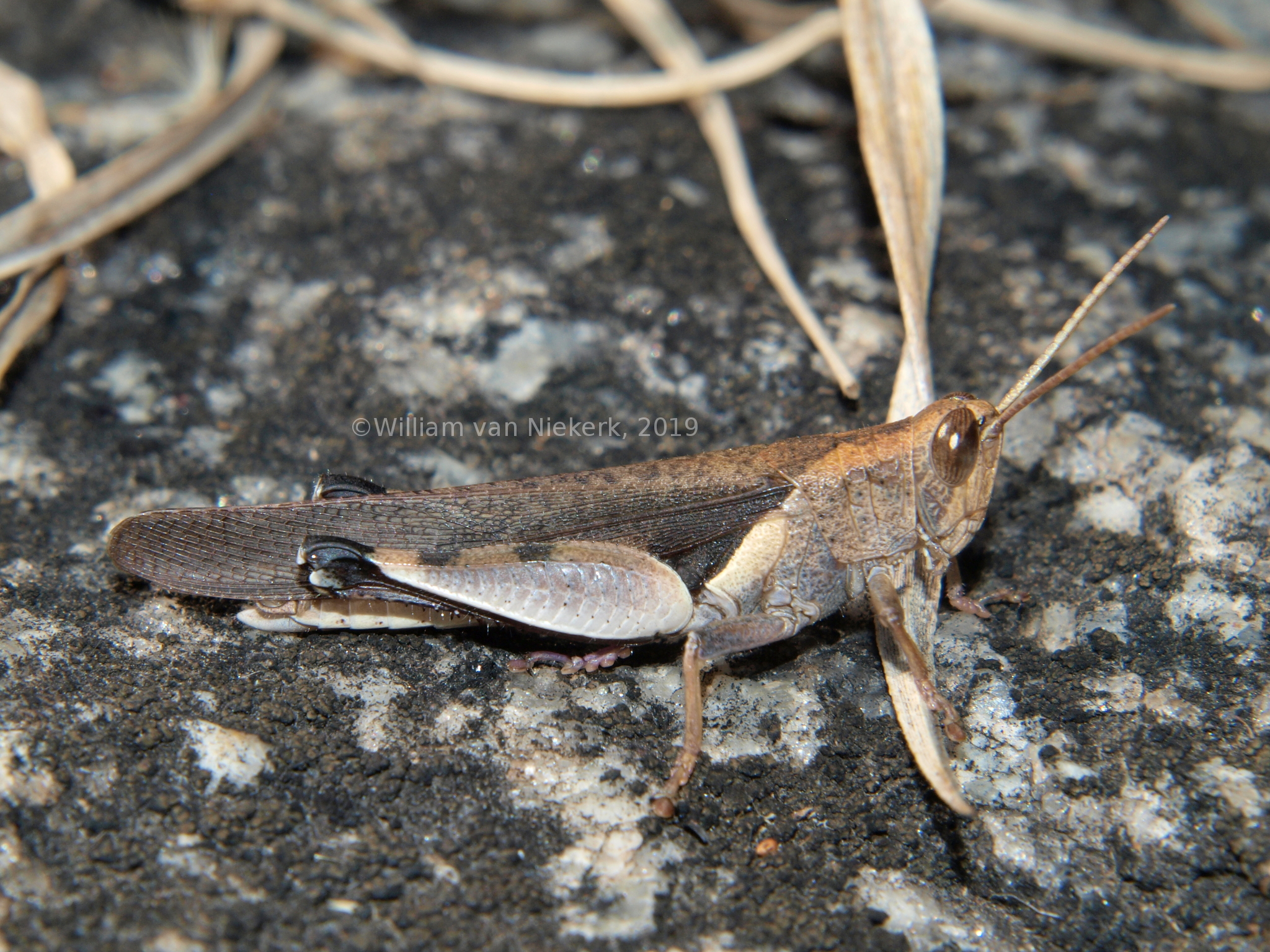
- Oxcatantops adustus – Widespread in Zambia, elsewhere to D.R.C:, Tanzania (probably also Malawi, Mozambique). Usually seen in riverine areas or on inselbergs; rarely in Miombo. Can be distinguished from the widespread O. spissus by the strongly curved male cerci; and from the near-endemic O. zambiensis by strong (not light) purple hind-tibiae, purple (not brown) colouring to the lower inner side of the hind femur, and usually blue (not grey or clear) hind wings, seen in flight.
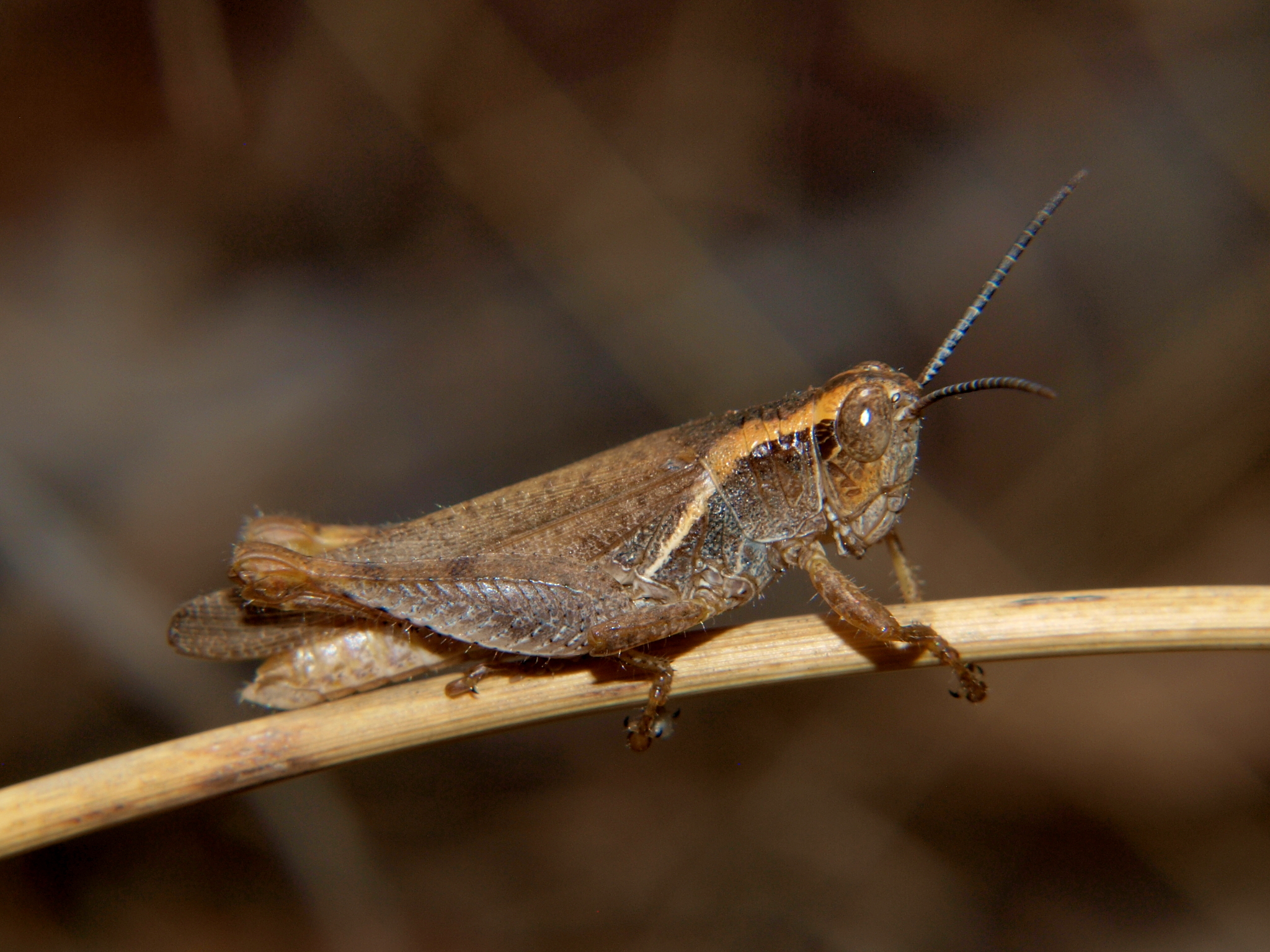
- Trichocatantops villosus – Widespread, almost throughout tropical Africa. Fairly common, but not usually abundant, in woodland, especially wetter areas (e.g. close to streams and dongas).
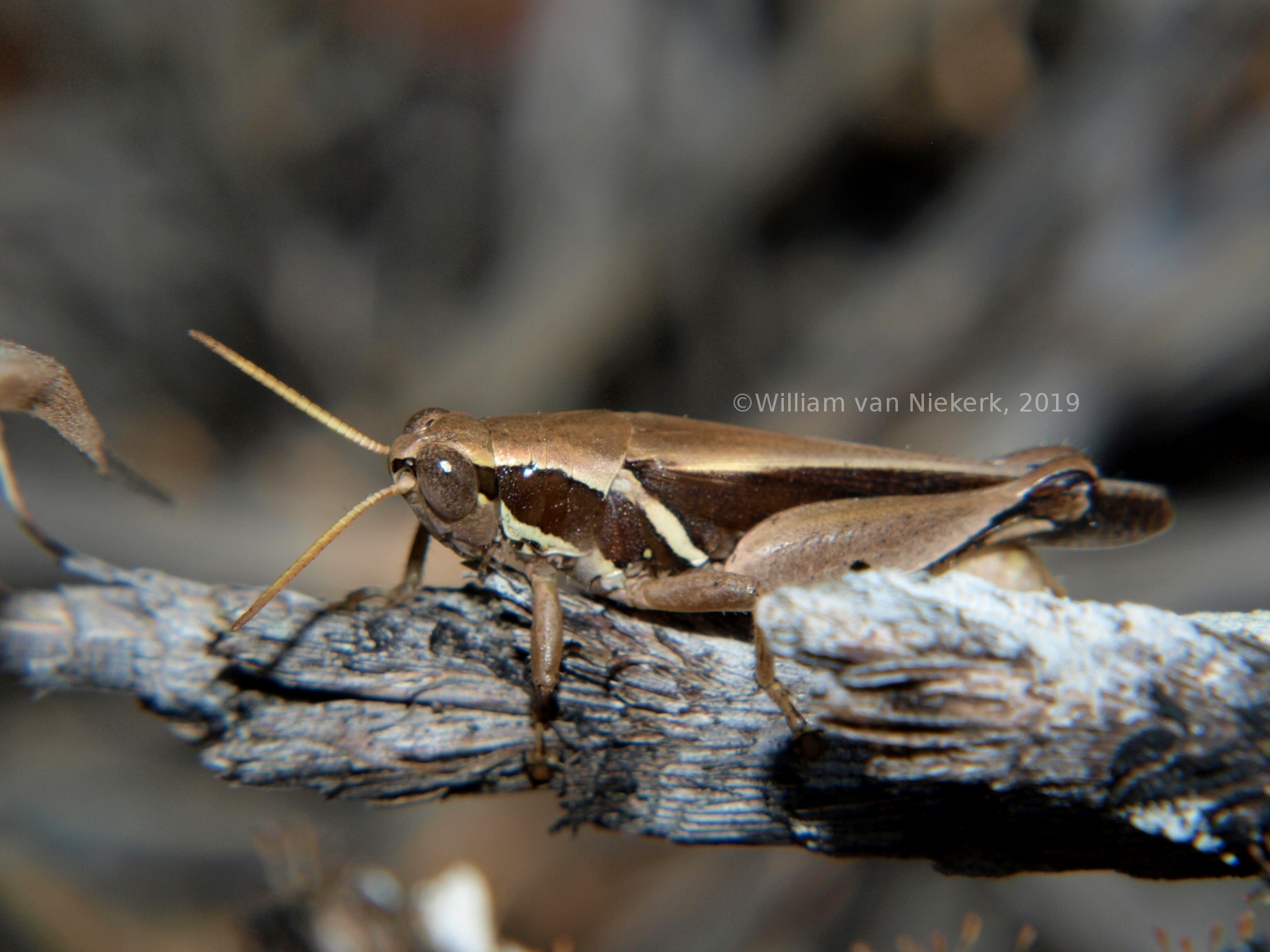
- Phaeocatantops solitarius – ubiquitous in Eastern Zambia and Malawi; similar to the widespread P. decoratus (which is usually recogniseable for the absence of a well-defined dark spot on outer surface of hind femur, but may vary). Most commonly found in disturbed areas around the main camp at Mutinondo.
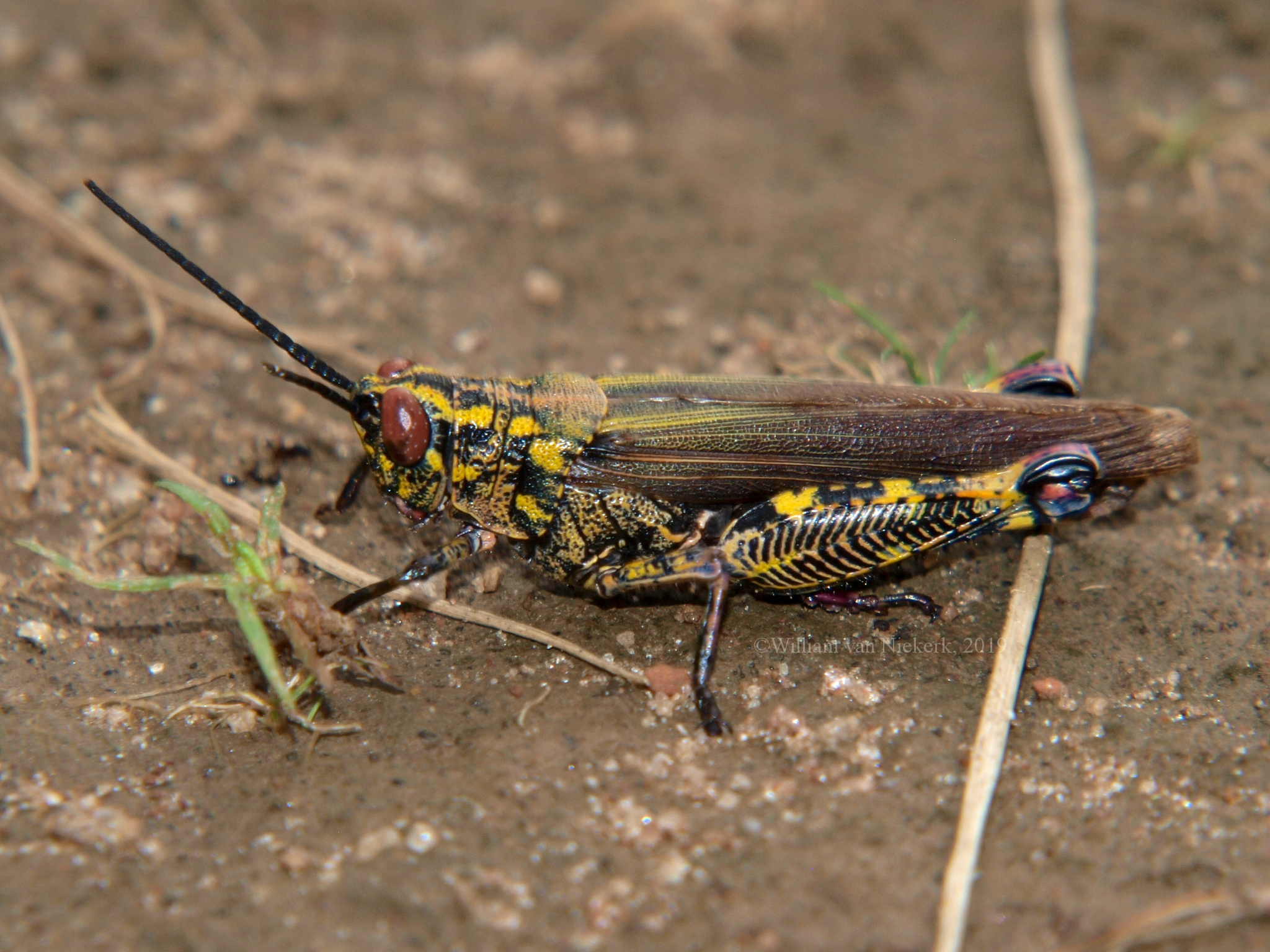
- Stenocrobylus festivus – Widespread; probably close to southern limit of its distribution in Mutinondo, where so far, it is only known from well-developed, near-riparian woodland.
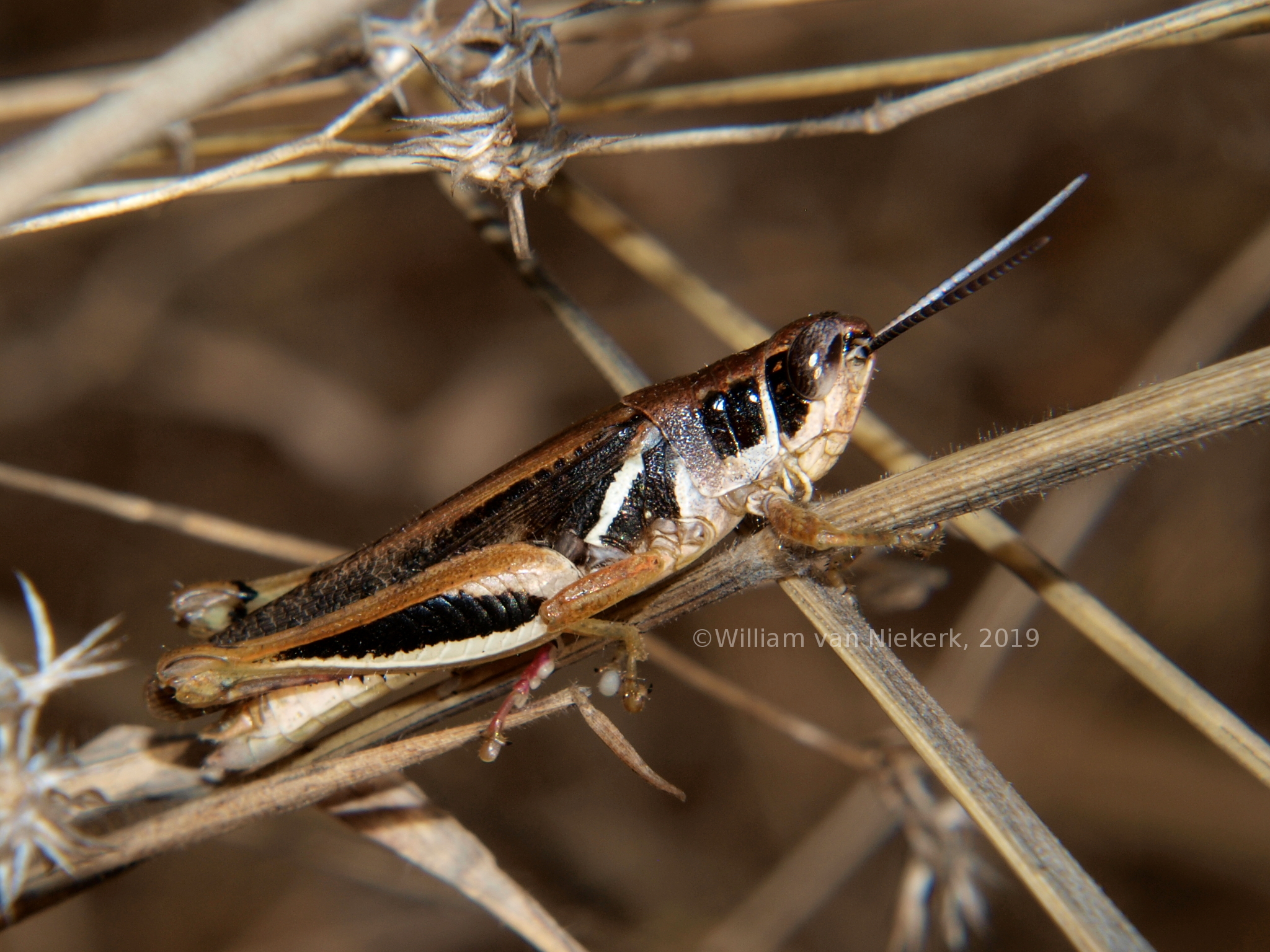
- Vitticatantops fasciatus – Primarily East African. Typically found in mature woodland. Distinguished from (numerous) other Vitticatantops by the continuous dark band on hind femur, but most readily distinguished from Hadrolecocatantops by the (external) form of the male genitalia.
Calliptaminae
Stocky, heavily built grasshoppers of woodland, usually ground dwelling.
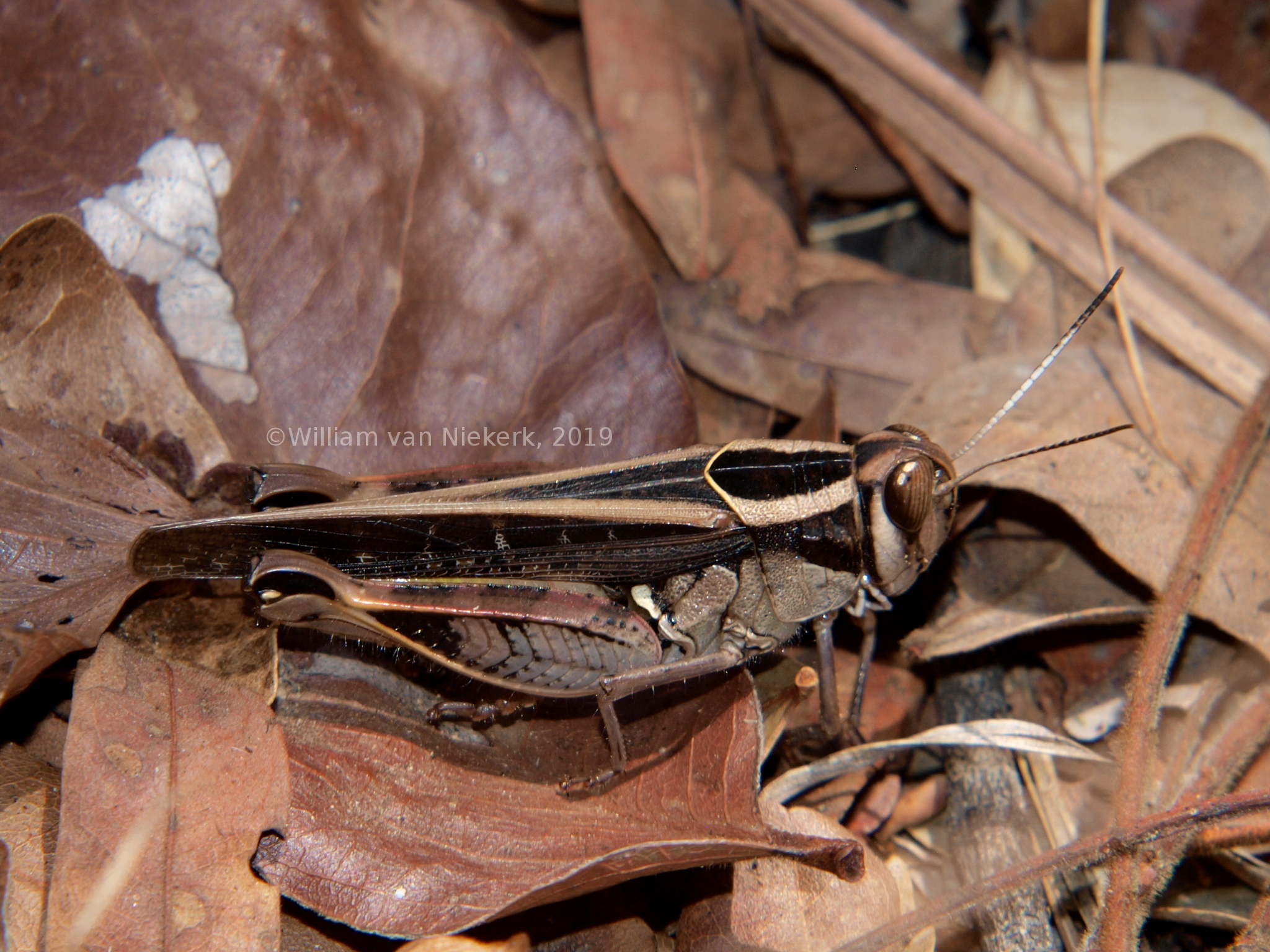
- Acorypha mossambica – Seemingly widespread in the miombo belt; recorded from Mozambique, Malawi, E. Zambia and likely present in Tanzania, D.RC., at least in southern parts. Almost ubiquitous (but rarely common) in well-drained woodland, especially on slopes.
Euryphyminae – Agile Grasshoppers
Similar to Calliptaminae in form; usually duller coloured and often flightless. Commonly browse on low vegetation.
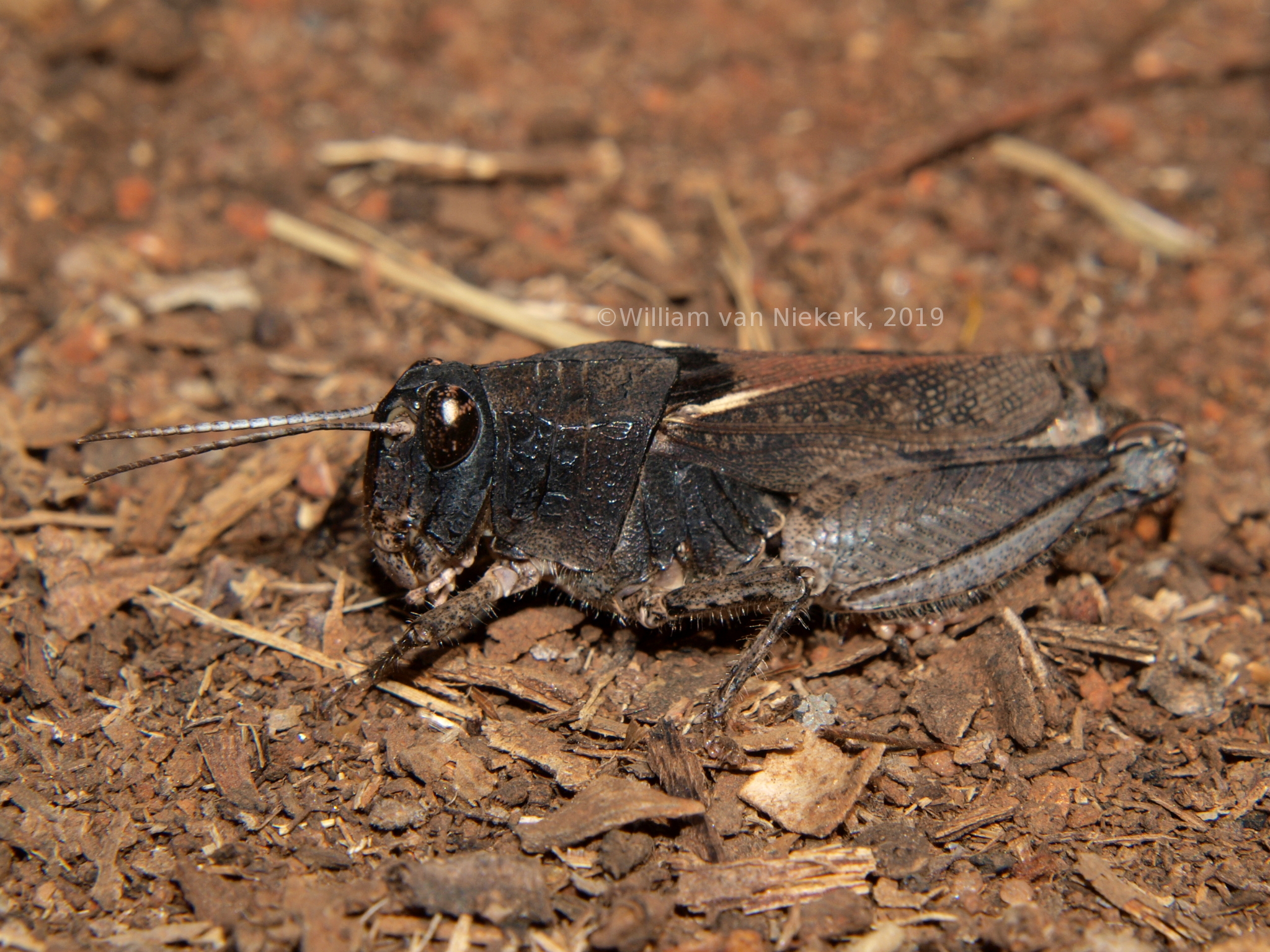
- Phymeurus granulatus – Widespread. Quite common in most woodland areas of Mutinondo.
Eyprepocnemidinae – Grassland Locusts
Usually found in grasslands; typically most abundant during the drier months. At least two further species present (but not yet satisfactorily examined) in Mutinondo’s dambo grasslands.
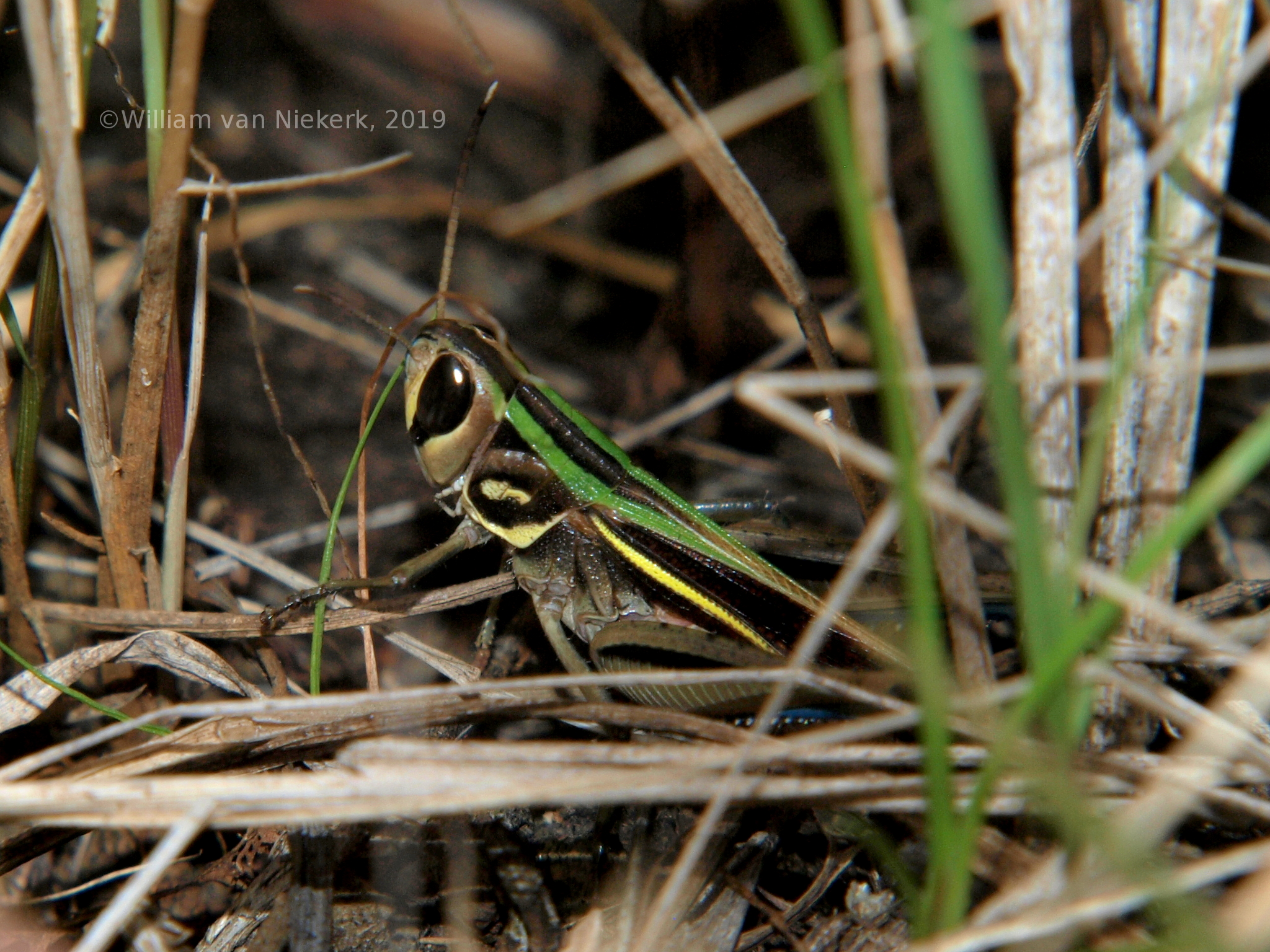
- Cataloipus roseipennis – Seemingly restricted to Malawi and E.Zambia. Common at Mutinondo, usually in open woodland or woodland-edge.
Oedipodinae – True Locusts and relatives
Many species thrive in disturbed areas; usually terrestrial, feeding on grasses. Most locust pests in this subfamily.
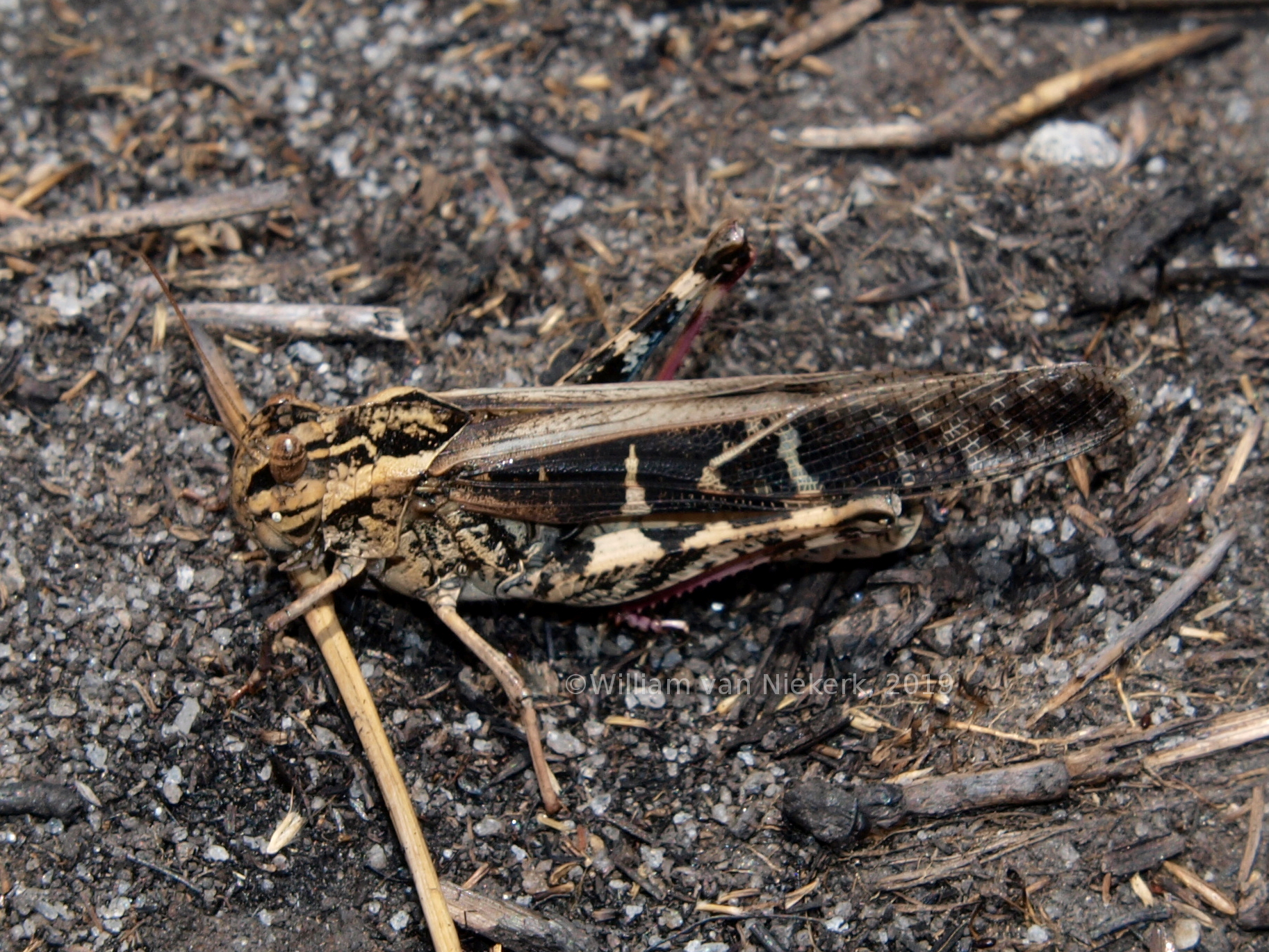
- Gastrimargus africanus – Throughout old-world tropics. At Mutinondo, most common at dambo-edge, but also in disturbed areas.
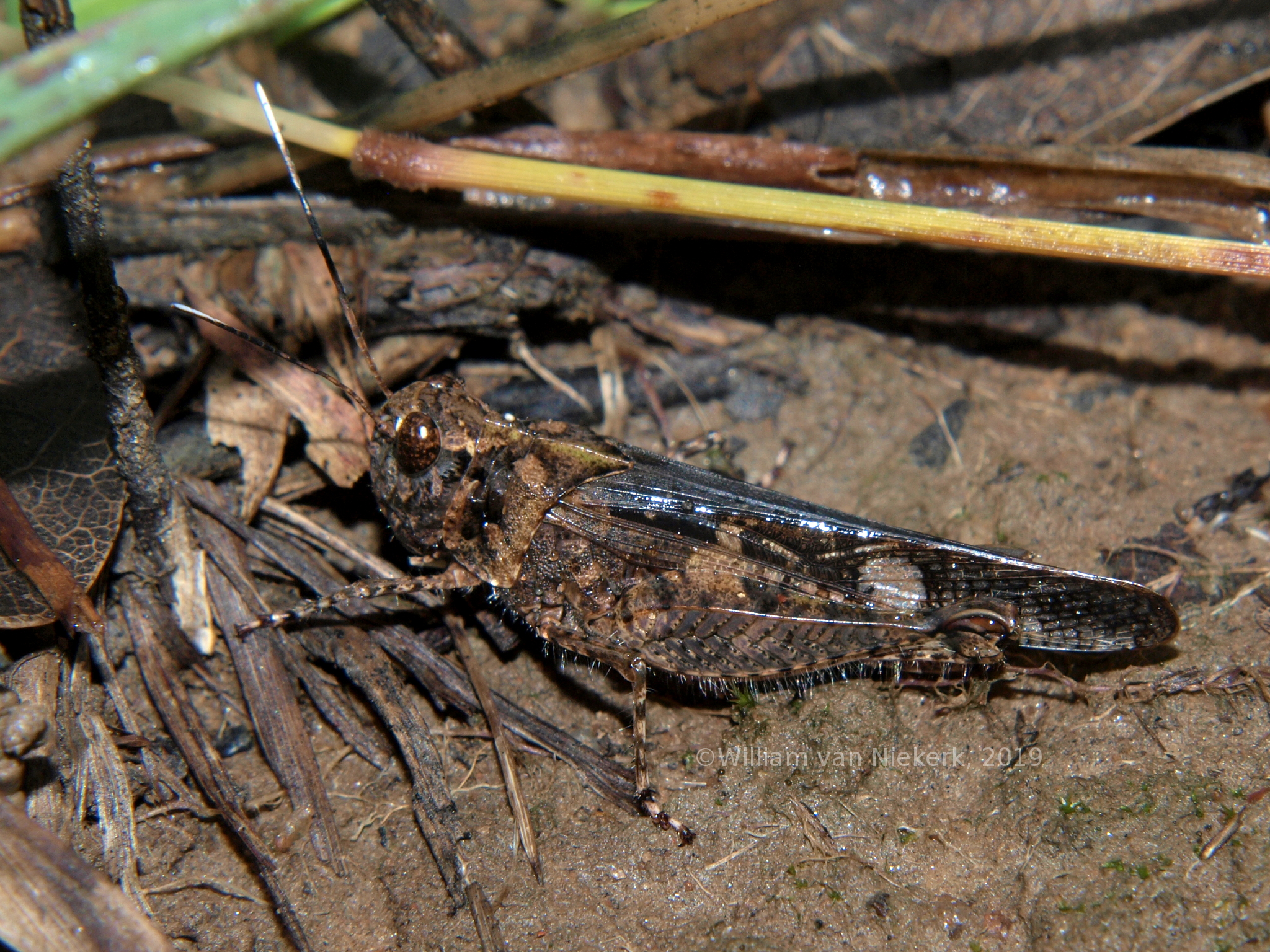
- Heteropternis pugnax – Widespread. Usually in woodland, seems to favour compacted soils including paths and roads.
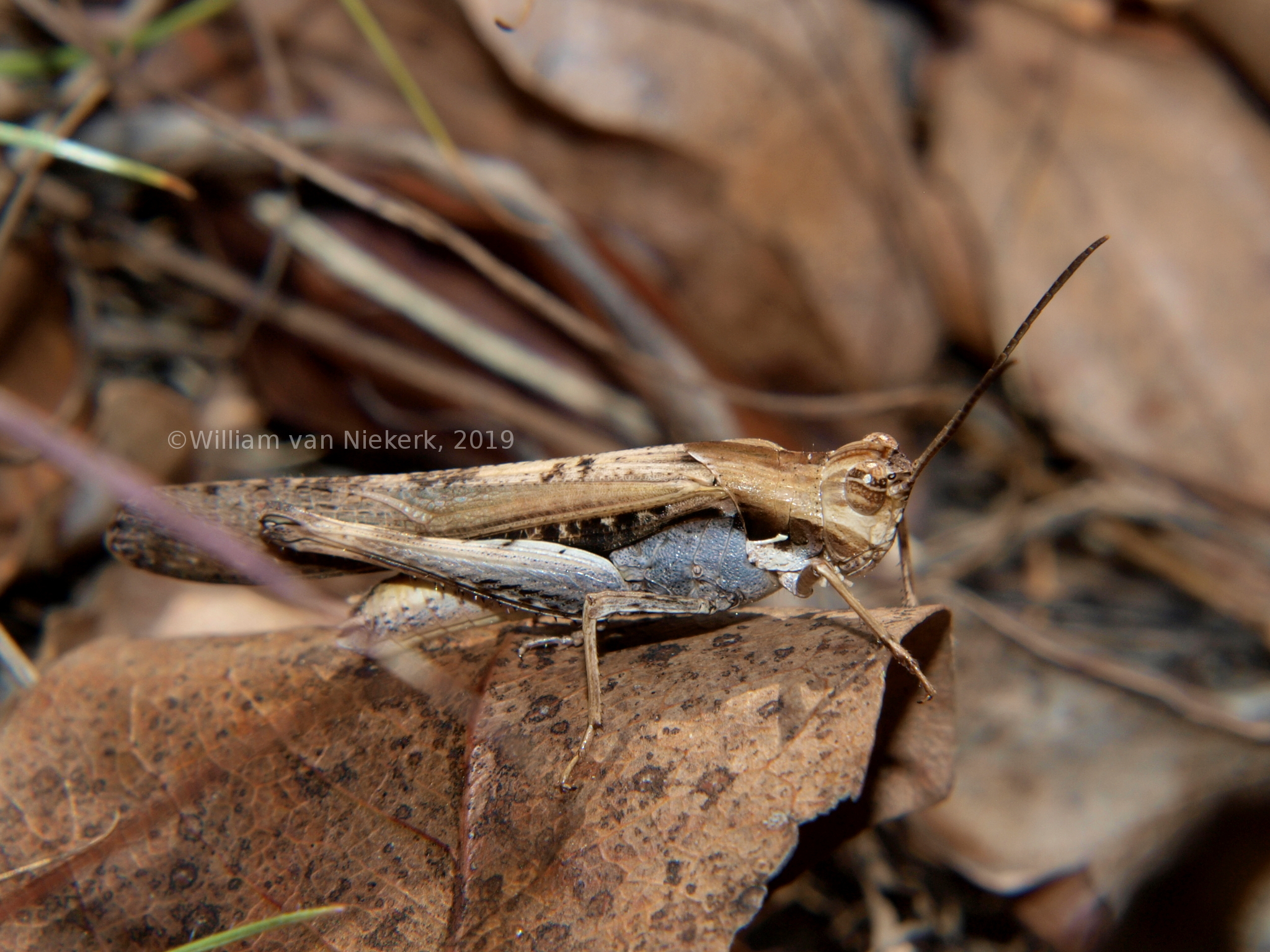
- Morphacris fasciata – Widespread. Usually in dense, dank vegetation, especially riverine, disturbed or woodland-edge.
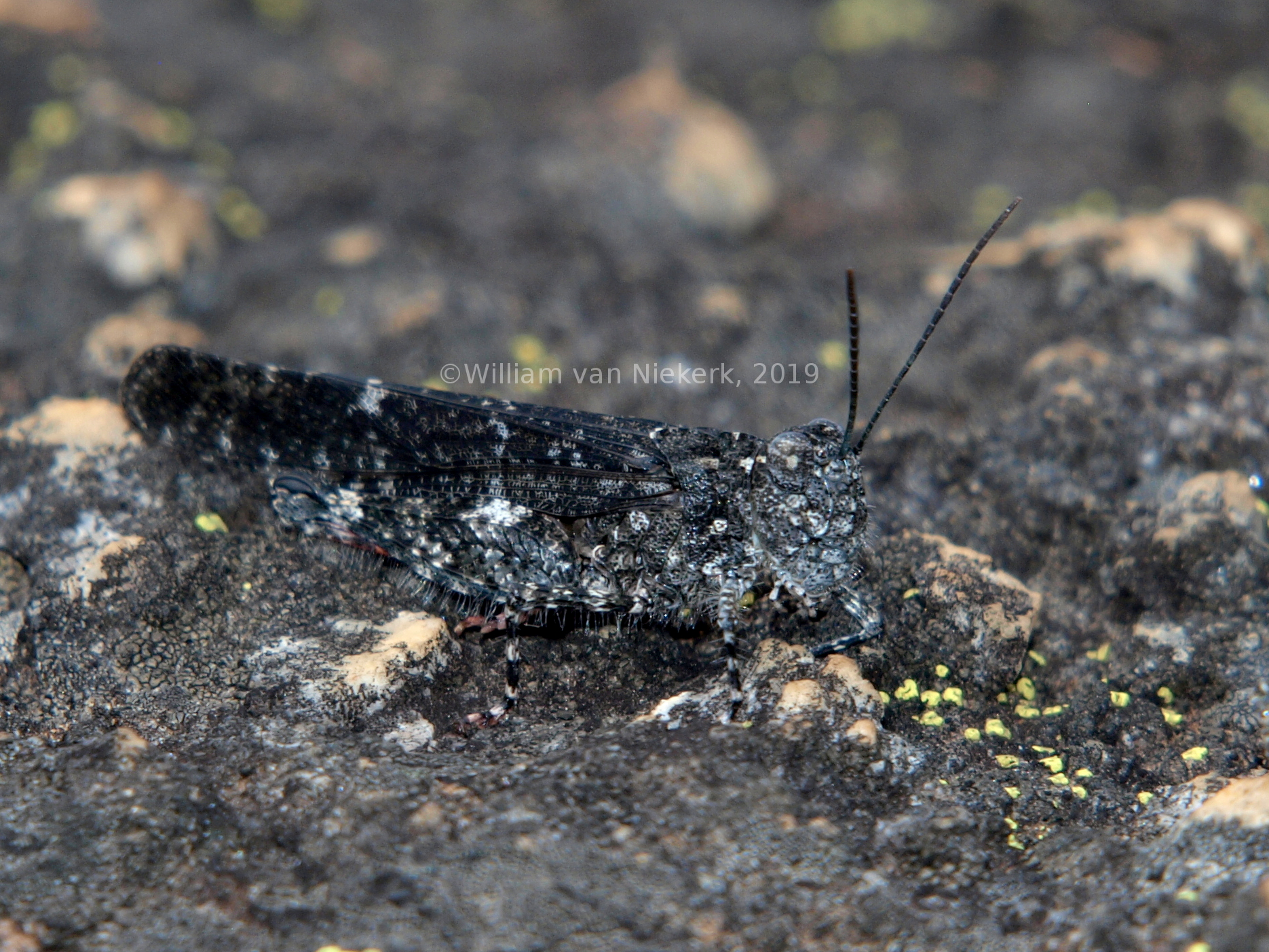
- Scintharista saucia – Existing records for this species appear to be limited to the western half of Southern Africa. Abundant and conspicuous on granite pavement and inselbergs.
Cyrtacanthacridinae – Tree Locusts
Large to massive; in drier regions, several species can become serious agricultural pests.
- *Cyrtacanthacris aeruginosa – widespread. Presumably found in woodland (record not mine).
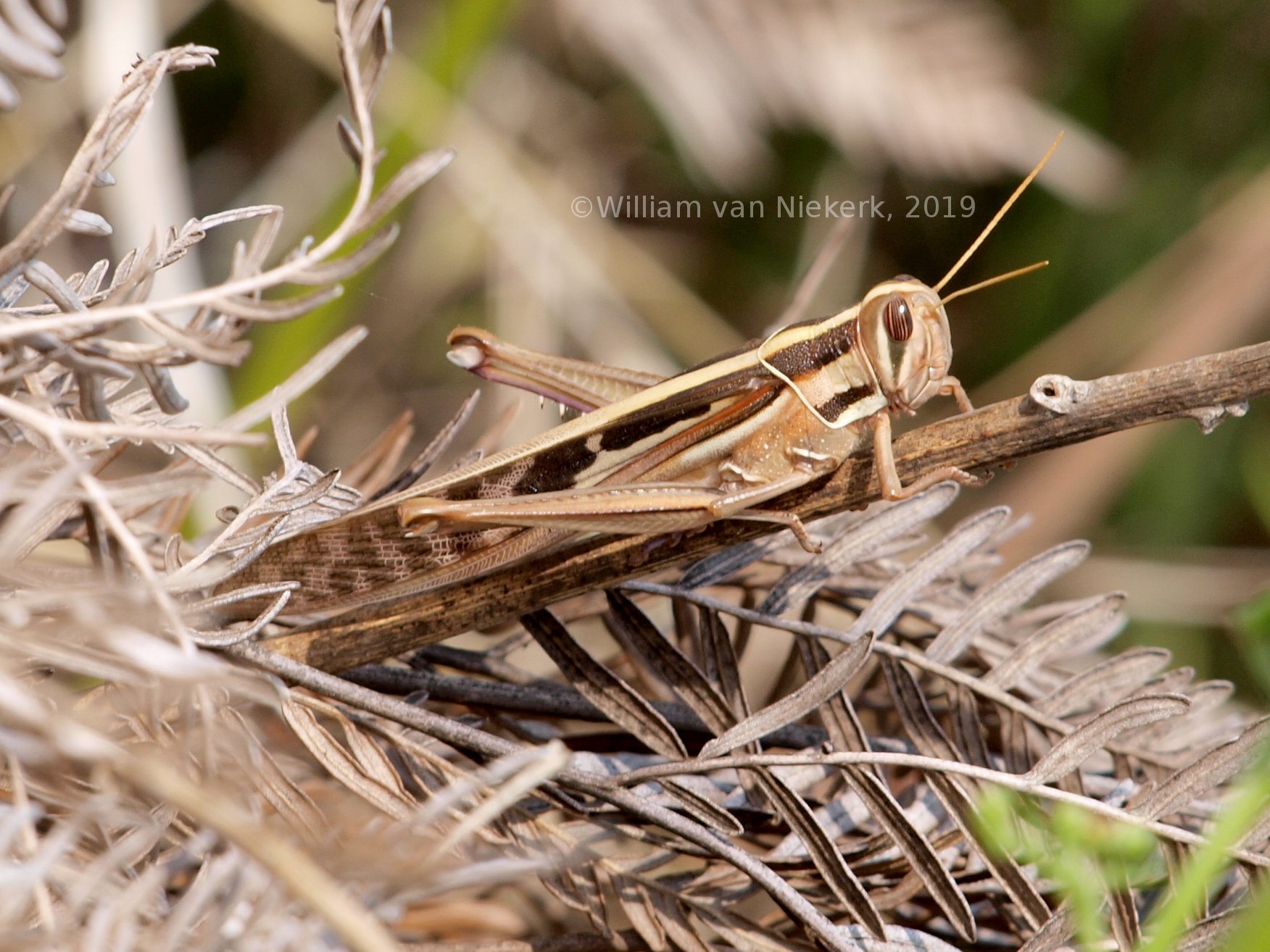
- Nomadacris septemfasciata (Red Locust) – Pan-African, sometimes a major pest of crop monocultures. At Mutinondo, most commonly seen in disturbed areas, particularly bracken fields.
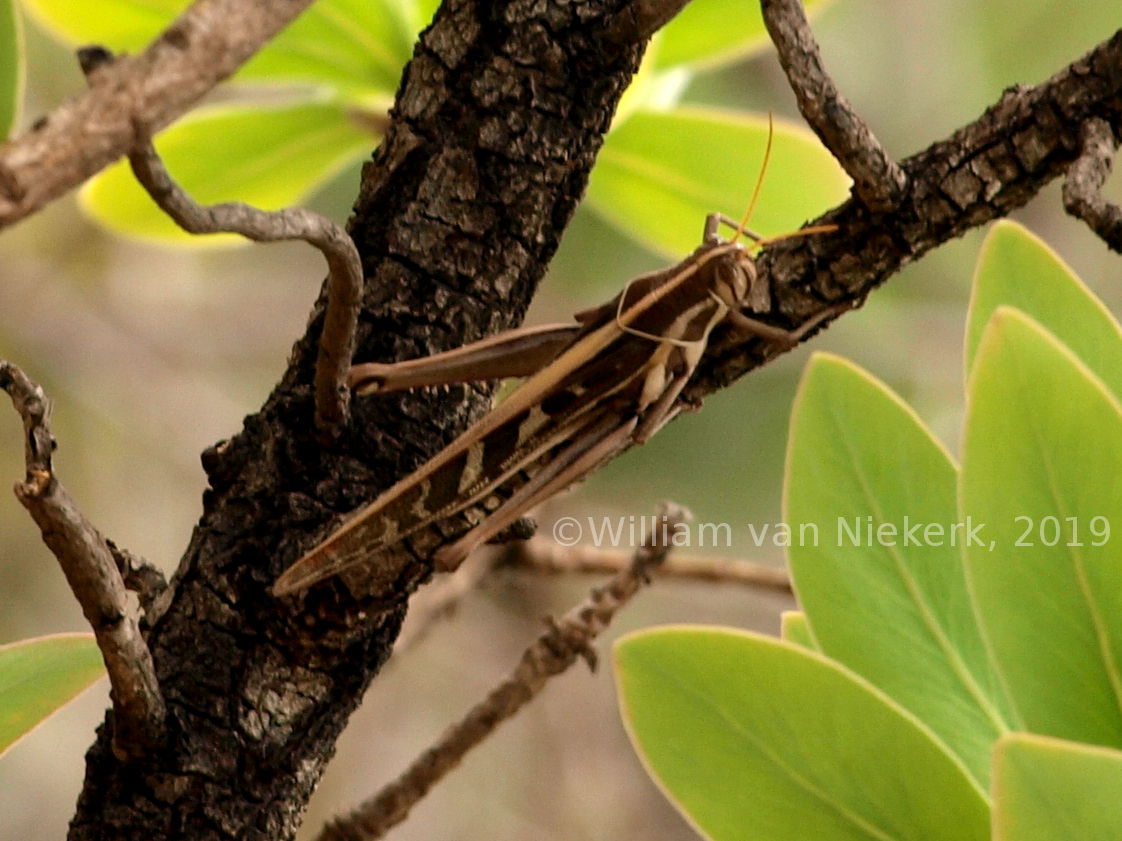
- Ornithacris pictula – Widespread. Conspicuous, if not always numerous, in Mushitu and woodland.
Toad Locusts/Rock Locusts – Family Pamphagidae
Large, slow-moving, and closely related to true grasshoppers; females usually entirely flightless, males long-winged. Most Zambian species closely associated with deep leaf-litter, although they appear to browse on a wide variety of woody plants, lichen and occasionally (usually dry) grasses as well.
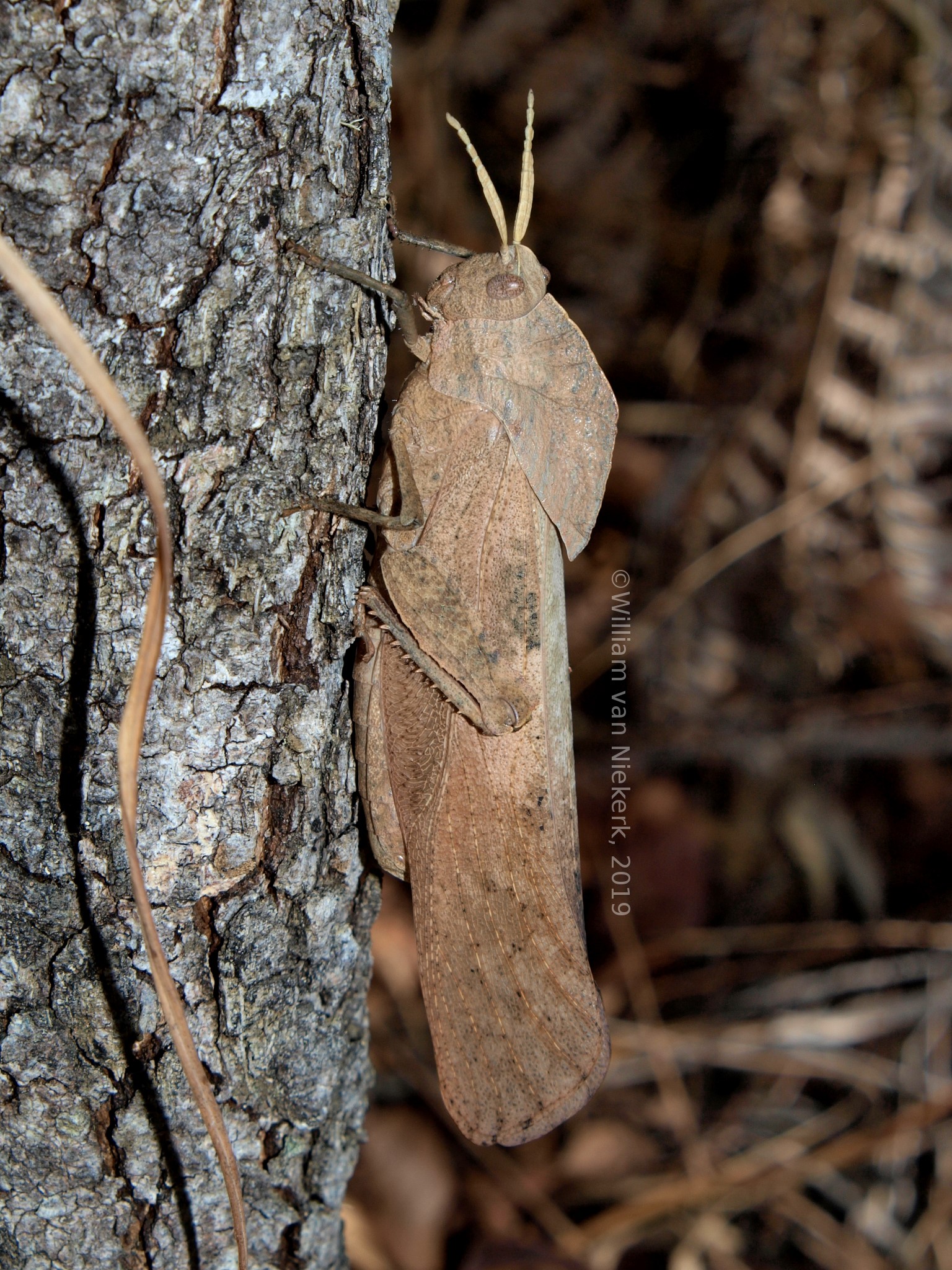
- Lobosceliana loboscelis - Fairly widespread in southern and south tropical africa. Females flightless, usually found among leaf-litter; males call late in the dry season from low in vegetation.
“Bark Hoppers” – Family Lentulidae
Small to medium-sized, squat and flightless grasshoppers found only in Southern and easternAfrica.
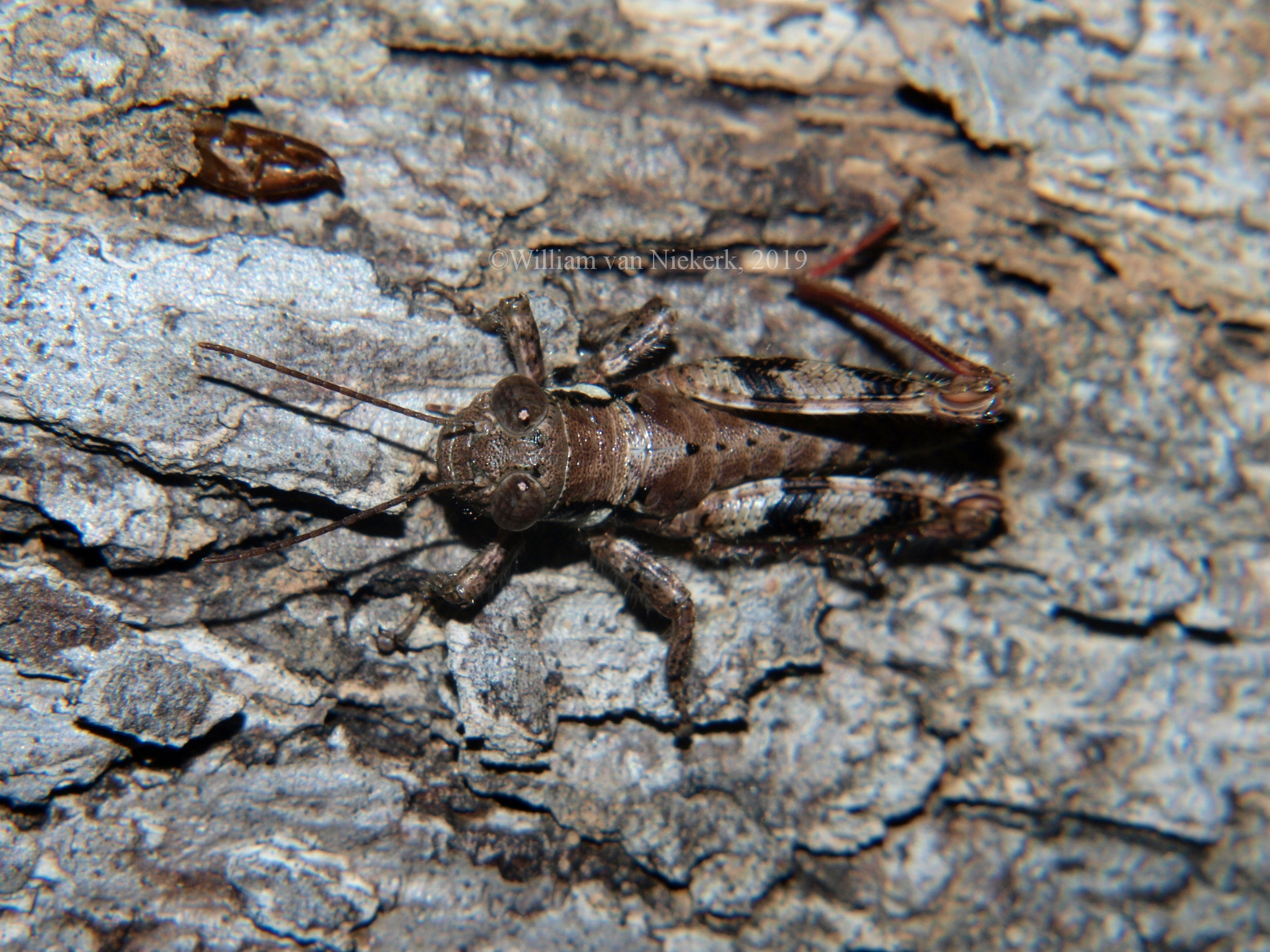
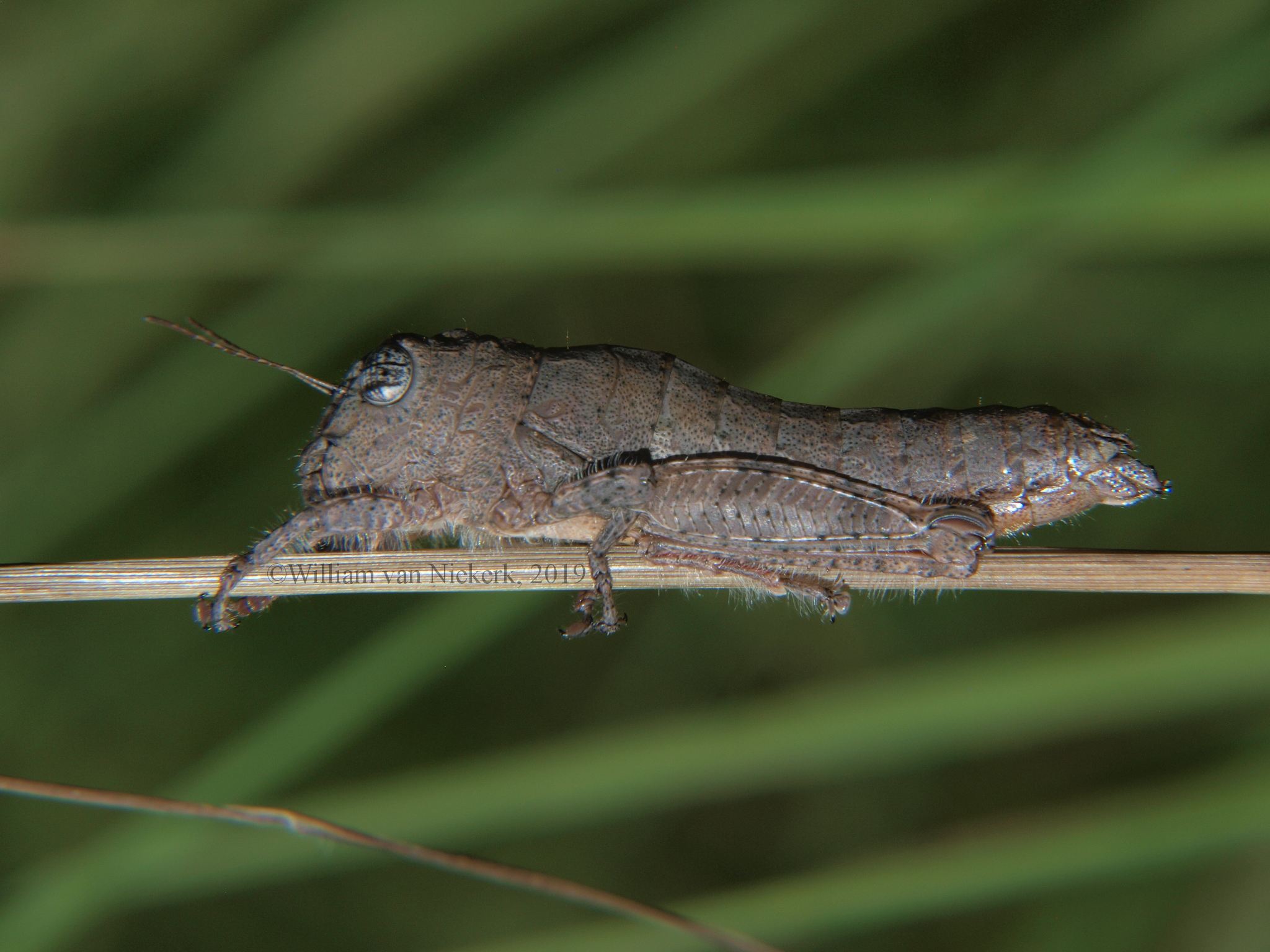
- Mecostibus rubripes – Found in Tanzania and Zambia, and probably Malawi; usually found on tree-bark, but seemingly uncommon throughout the area. Male above, female below.
Summer Hoppers/False Monkey-Stick Hoppers – Family Thericleidae
Tiny, flightless, herbivorous and often colourful grasshopper relatives, mostly slow-moving specialist feeders on specific genera of trees, and rarely seen far from these. Males and females often very distinct in appearance. Family is largely limited to Sub-Saharan Africa, although one species is known from the Arabian peninsula, and
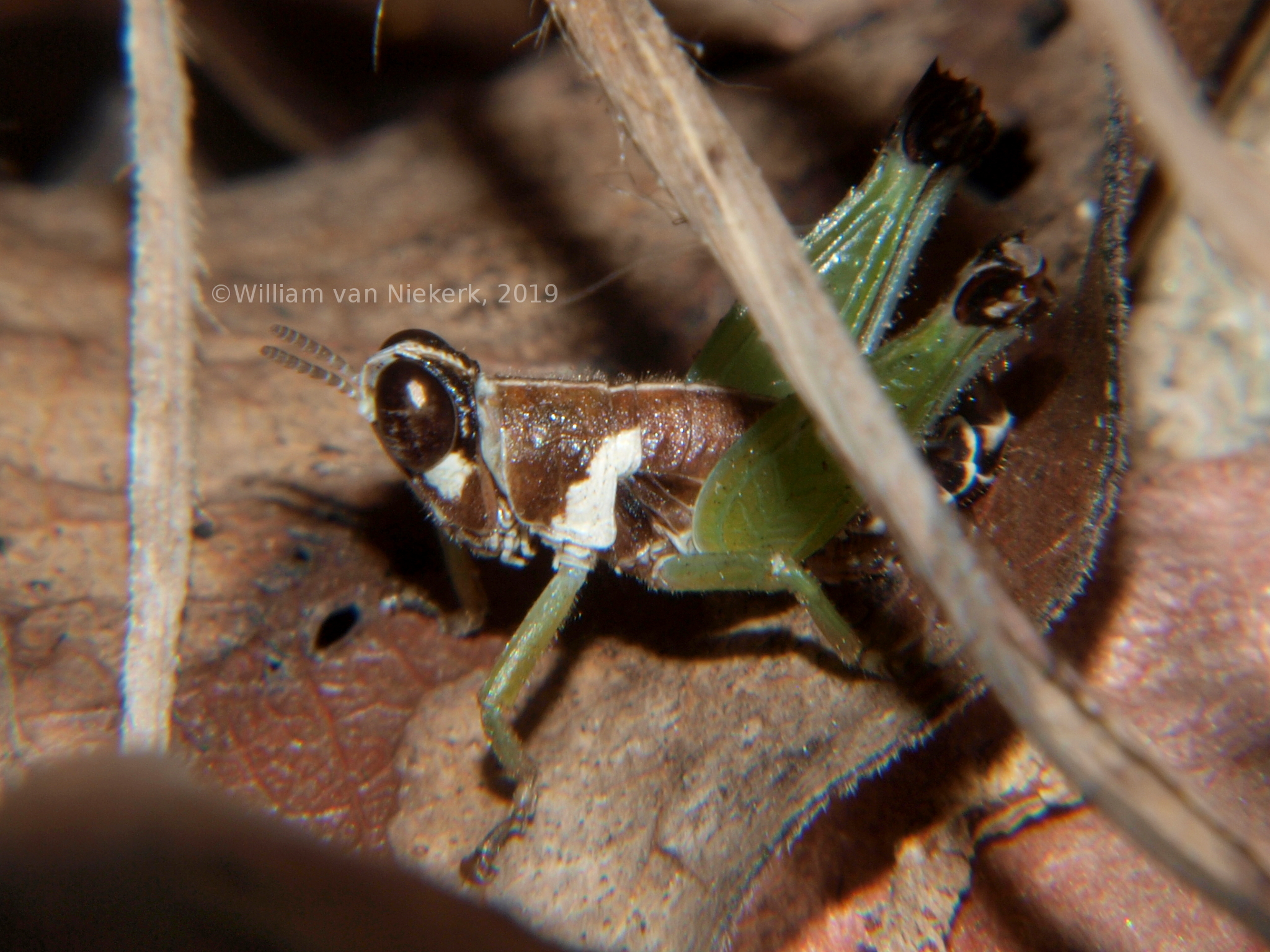
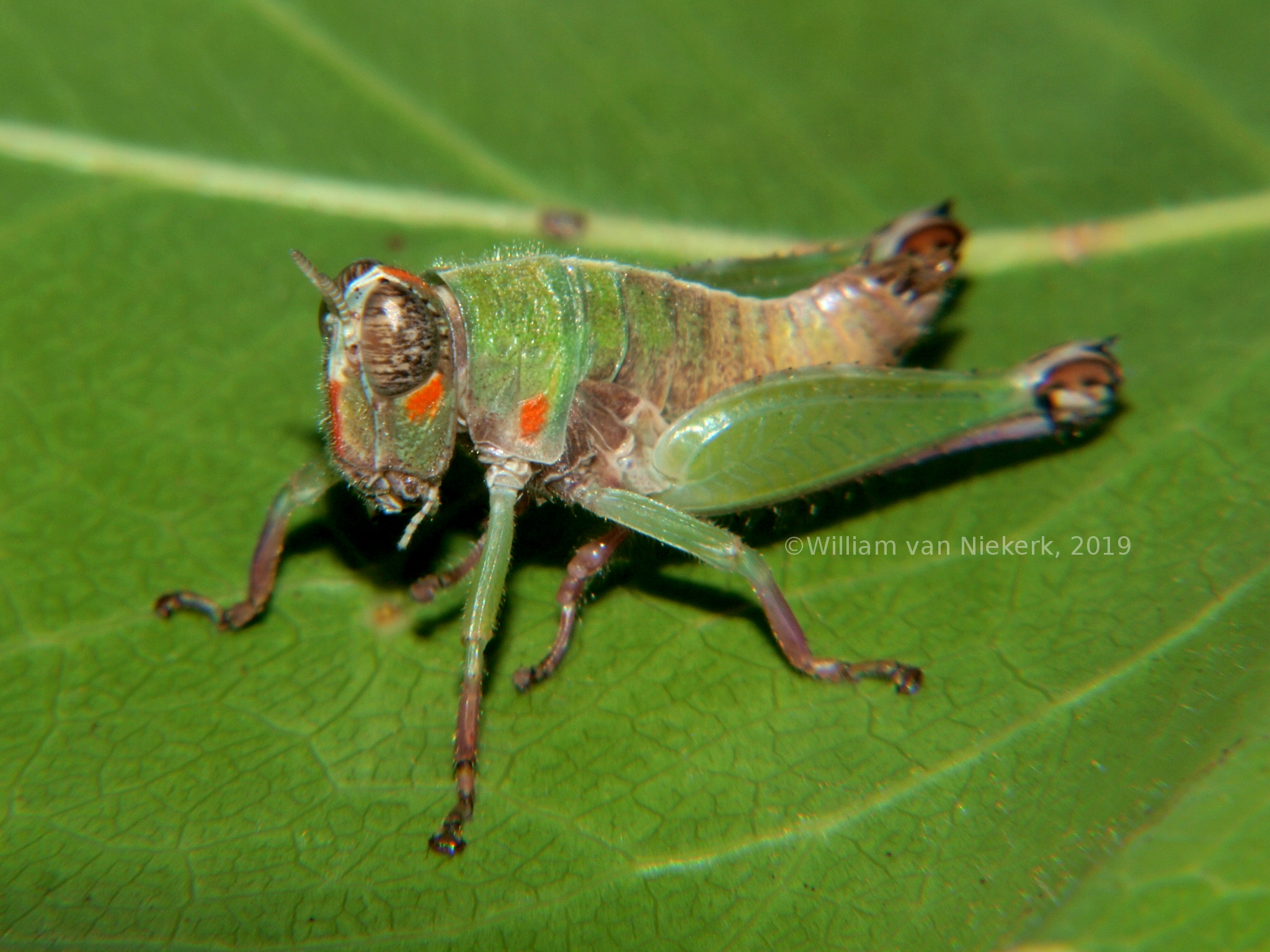
- Thamithericles croceosignatus – widespread for the family, occurring in Zambia, Malawi, and southern D.R.C. Uncommon in woodland; food-plant unclear, possibly of family Solanaceae (historic record) or Rothmannia (fairly common association). Male is shown above, female below.
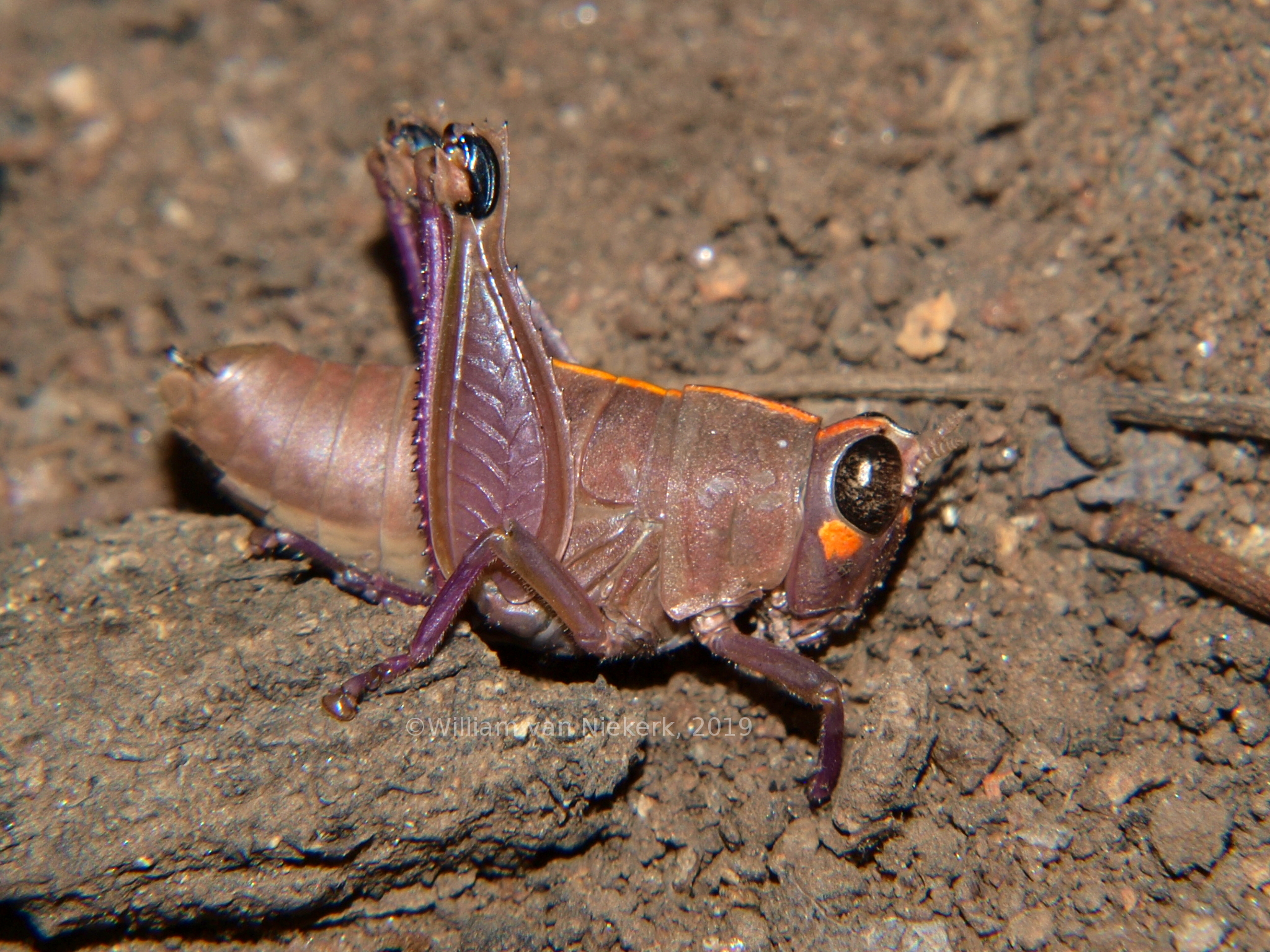
- Thamithericles tanzaniae – Previous records limited to Tanzania; new to Zambia. Females mostly seen in riverine woodland and dambo-edge, often with Parinari capensis and Parinari curatifolia. Also took Brachystegia, Gardenia in captivity (also ate Protea, which was apparently fatal to it). Female shown.
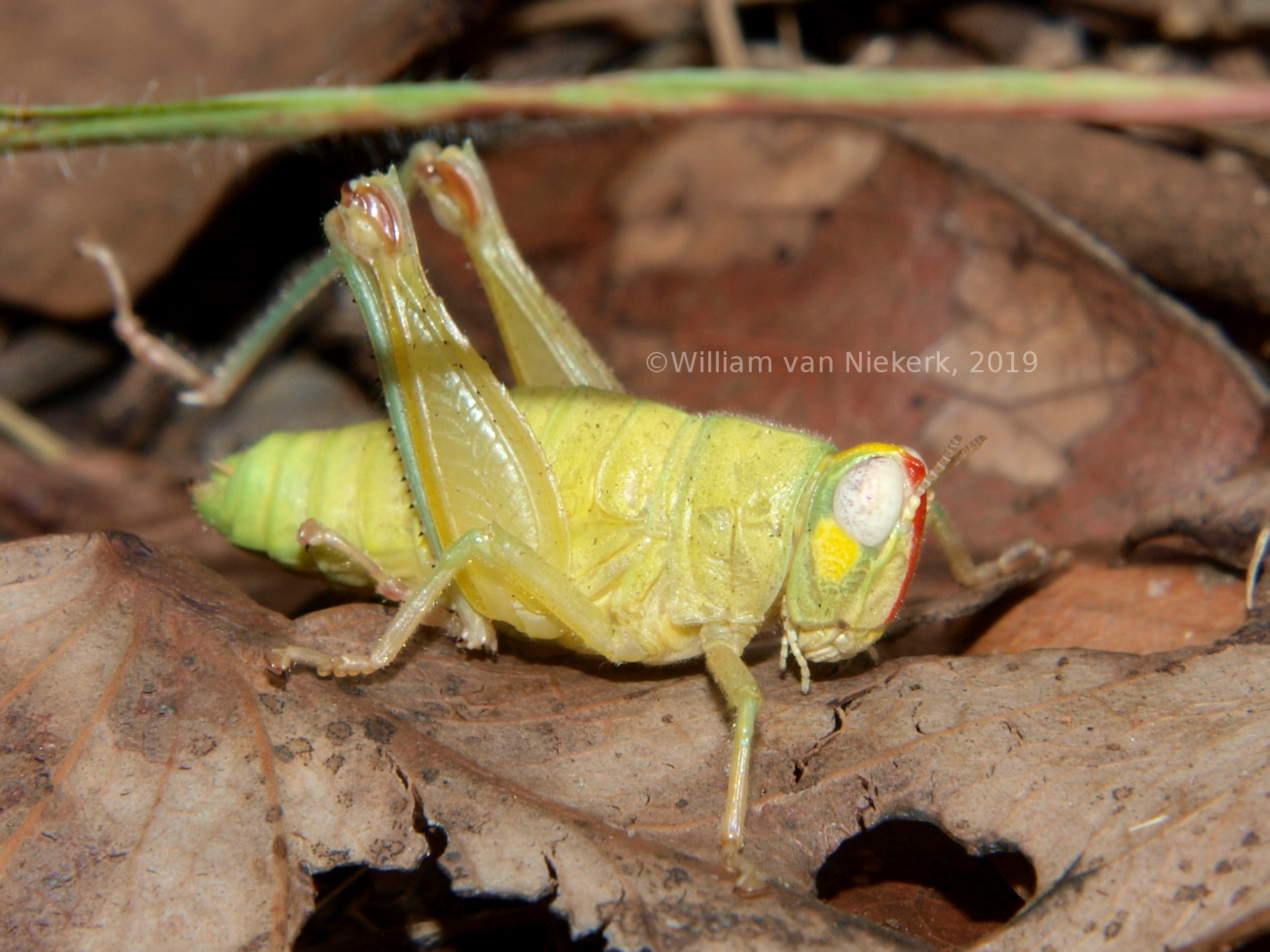
- Thamithericles, cf. nr. genisflammeis – A single female of an unknown Thamithericles was found in mature woodland in November. While visible characters do not correspond entirely to any described species, structure of head and pronotum are closest to T. genisflammeis, recorded from Copperbelt, N. Western Zambi and D.R.C. Female shown.
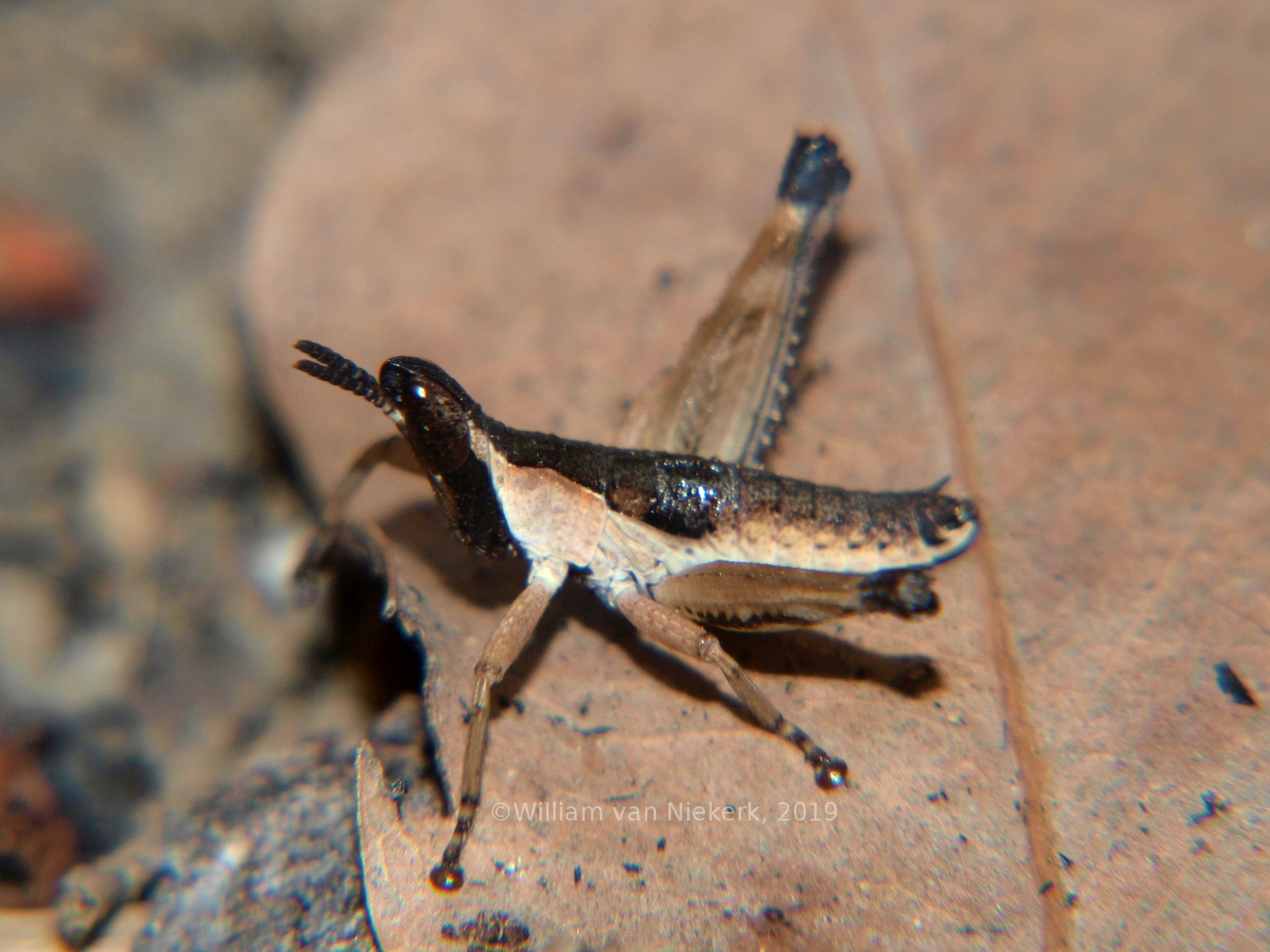
- Stenothericles jagoi – Endemic; previously recorded only from Mbala. Seems to be associated with Brachystegia boehmi, although also ate leaves of B. longifolia and B. spiciformis in captivity. Male shown; female very similar, but larger.
Monkey-Stick Hoppers – Family Euschmidtiidae
Tiny, slender-bodied and active, herbivorous grasshopper-relatives, mostly with underdeveloped wings in both sexes.
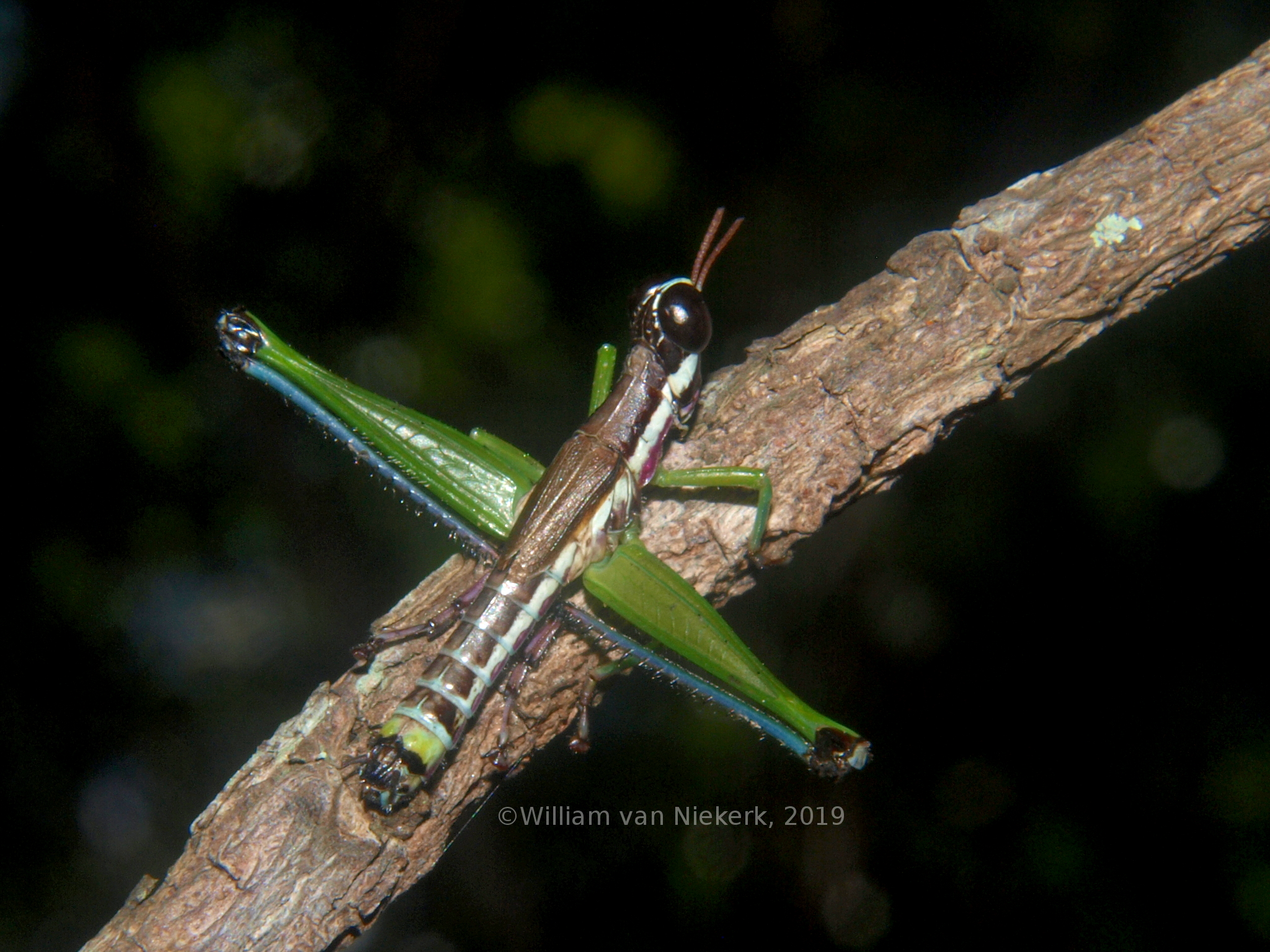
- Euschmidtia sp. - genus new to Zambia, species is most probably new to science. Adults most usually found on trees of genera Uapaca and Protea, although captive specimens survive well on leaves of Uapaca and Gardenia, and mostly shun Protea.
Blubber Locusts – Family Pyrgomorphidae
Medium to very large (for insects), toxic, often brightly coloured and sculptured herbivores, typically associated with milkweeds (Euphorbiaceae) and other poisonous plants. Many species short winged and flightless, often
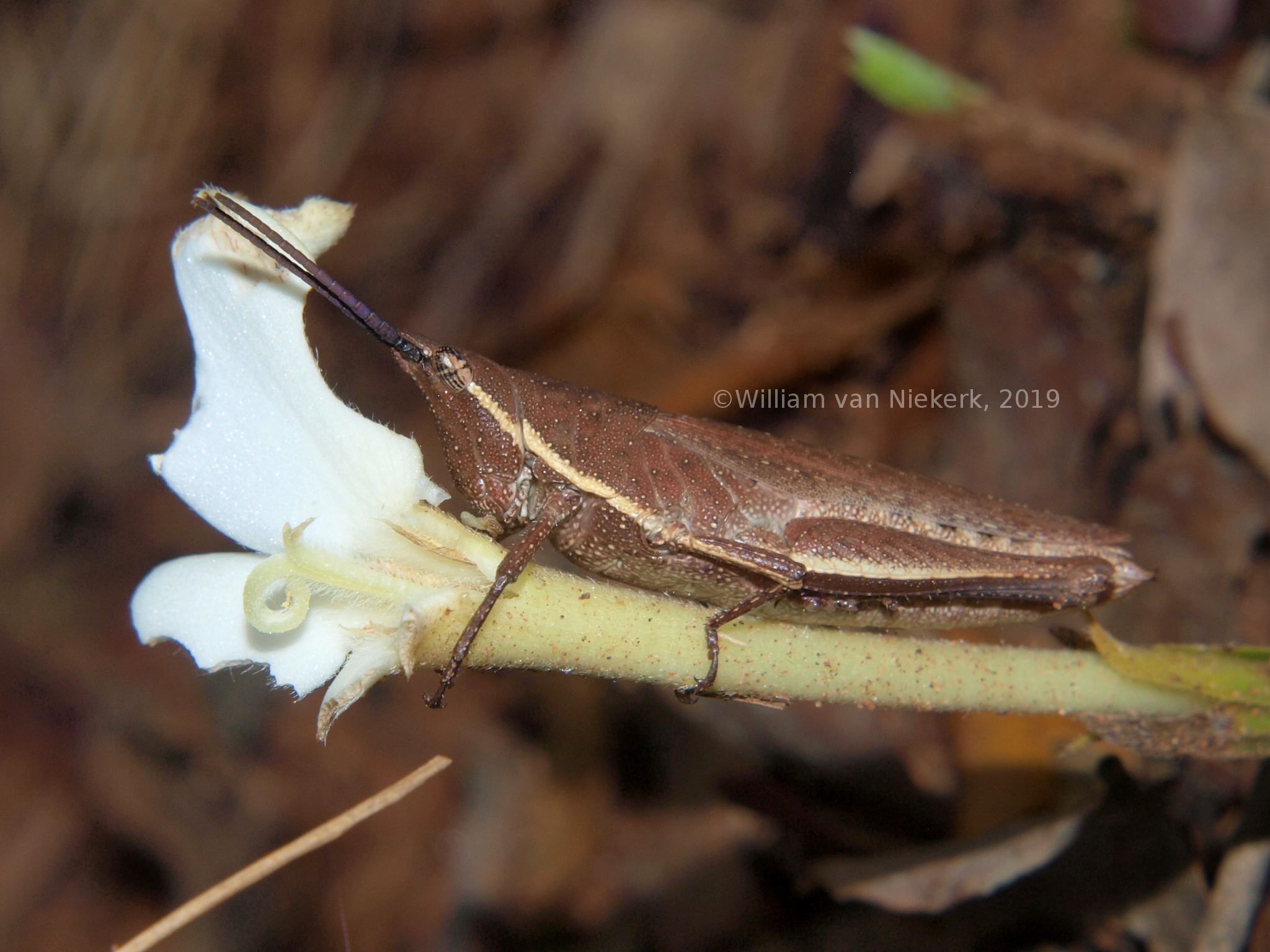
- Tanita lineaalba – Corresponds to types and description of this Angola-described species. Possibly limited to miombo belt; very common in woodland throughout the site (and much of Zambia), particularly conspicuous immediately after fires, which it seems to survive well.
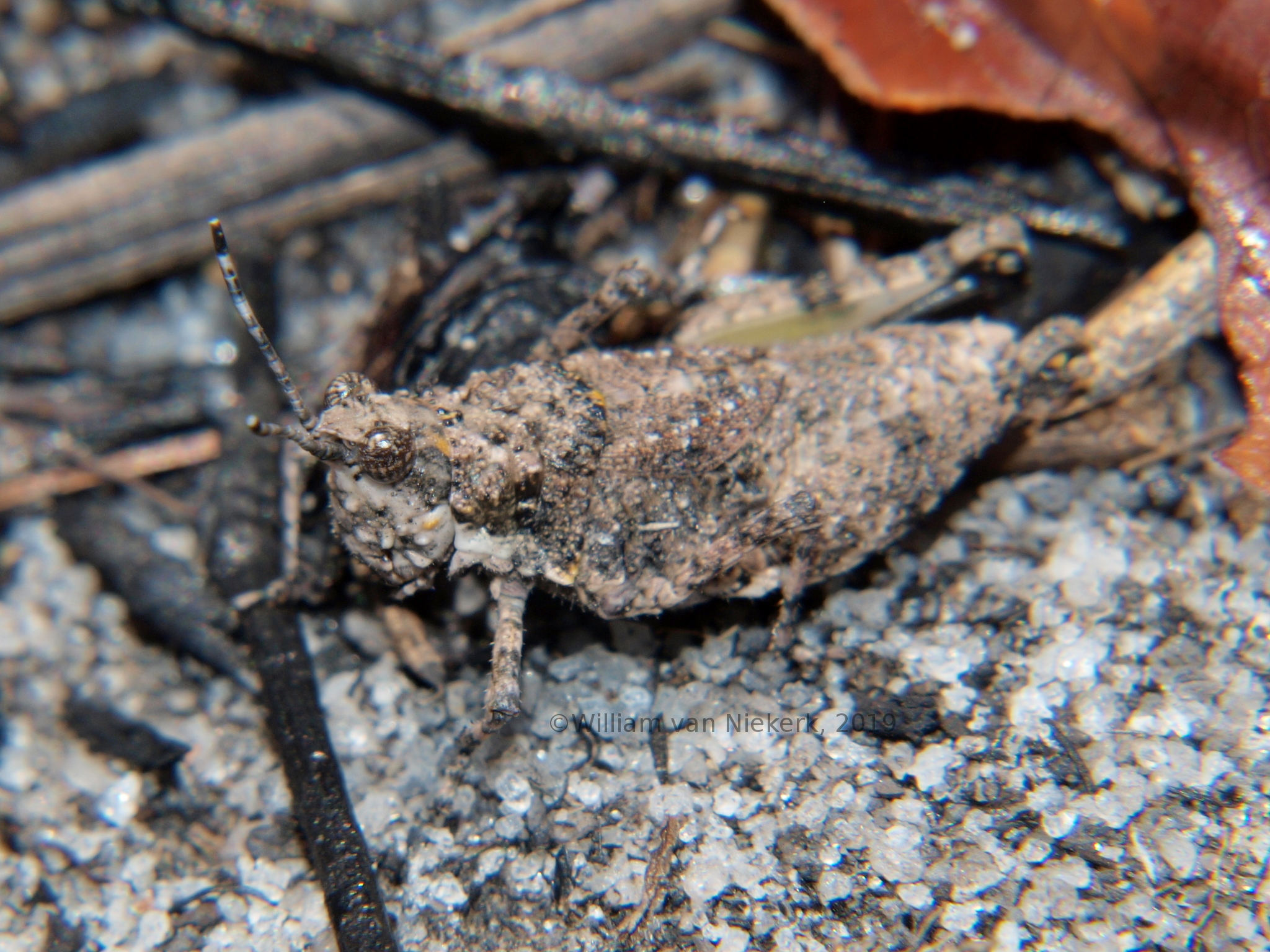
- Chrotogonus (Chrotogonus) hemipterus – Widespread. Common in sandy soils, especially dambo-edge.
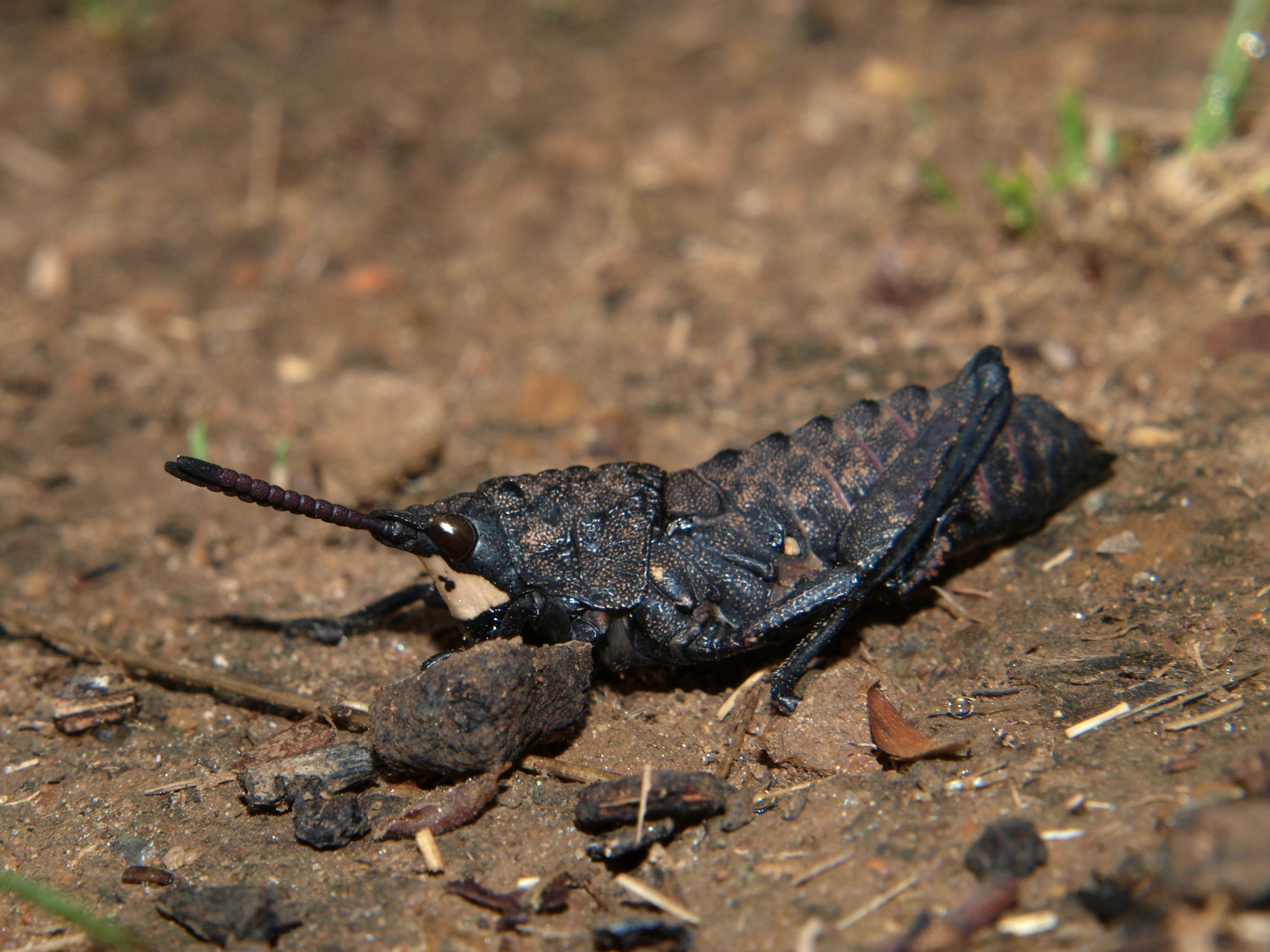
- Maura bolivari – narrowly distributed in south tropical africa, into Malawi and D.R.C. Adults are common almost everywhere in the early rains.
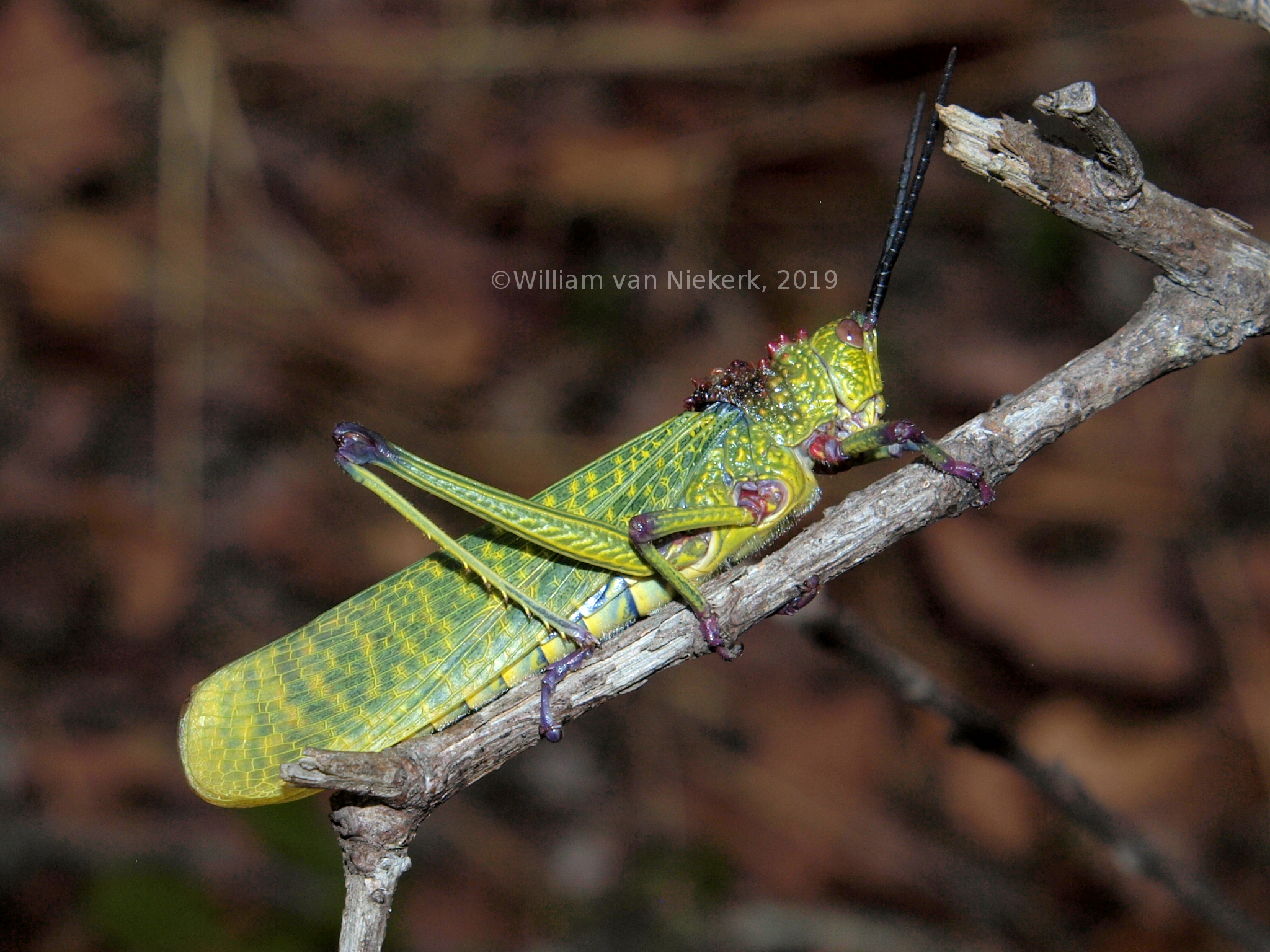
- Phymateus (Phymateus) viridipes – Widespread. Usually in woodland or disturbed grassland areas; occasionally on dambo edge.
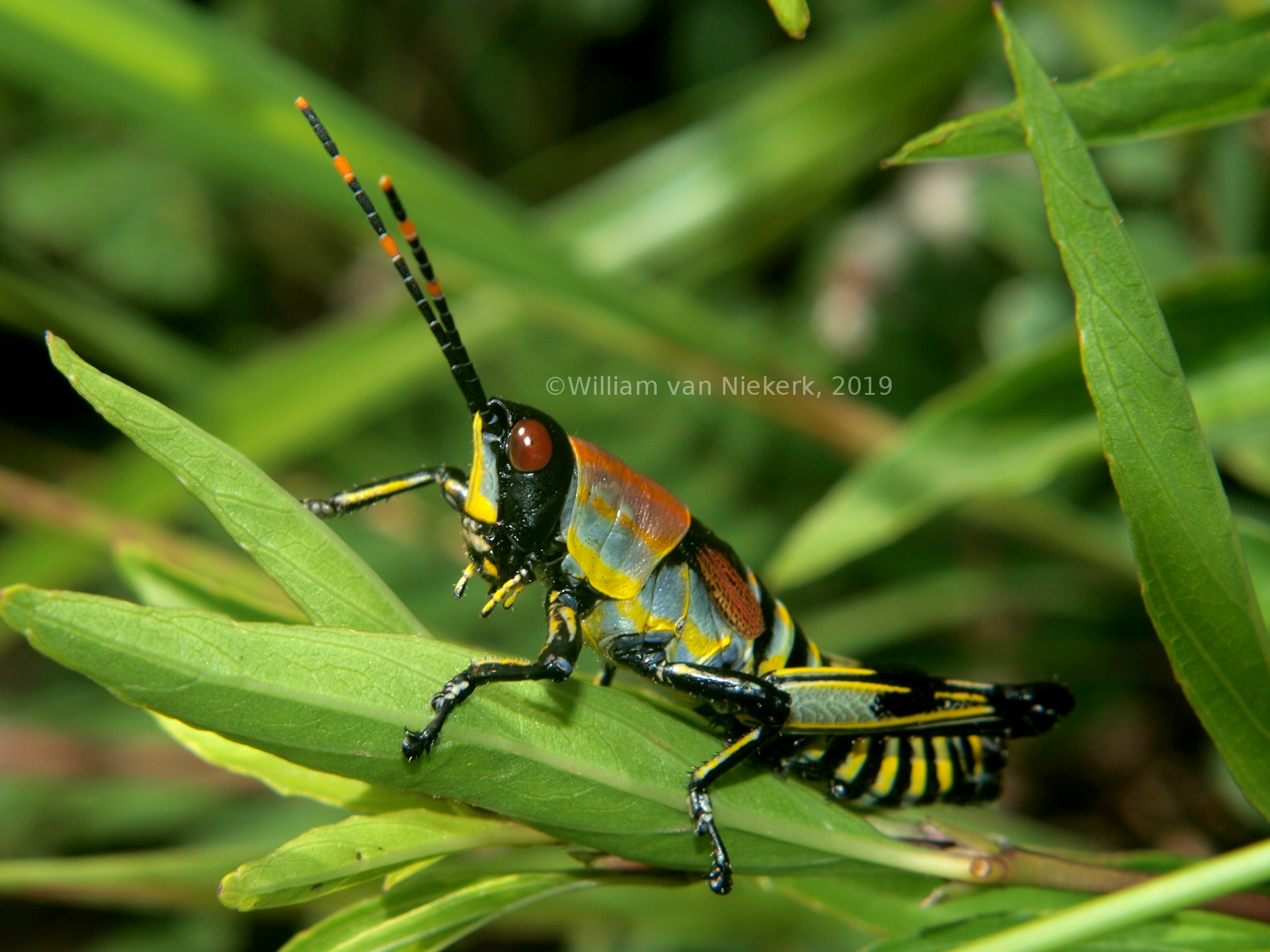
- Zonocerus elegans – Widespread. Common in woodland, mushitu and dambo edge throughout the wilderness area, adults usually appearing in February (some probably found year-round).
Grouse-Locusts – Family Tetrigidae
Generally small to tiny, algivorous or herbivorous relatives of grasshoppers, strongly associated with water. Family immediately recognised by the massively extended pronotum (visible upper plate of thorax), which covers most of the wings and abdomen above , and sometimes the head as well. Often strongly ornamented.
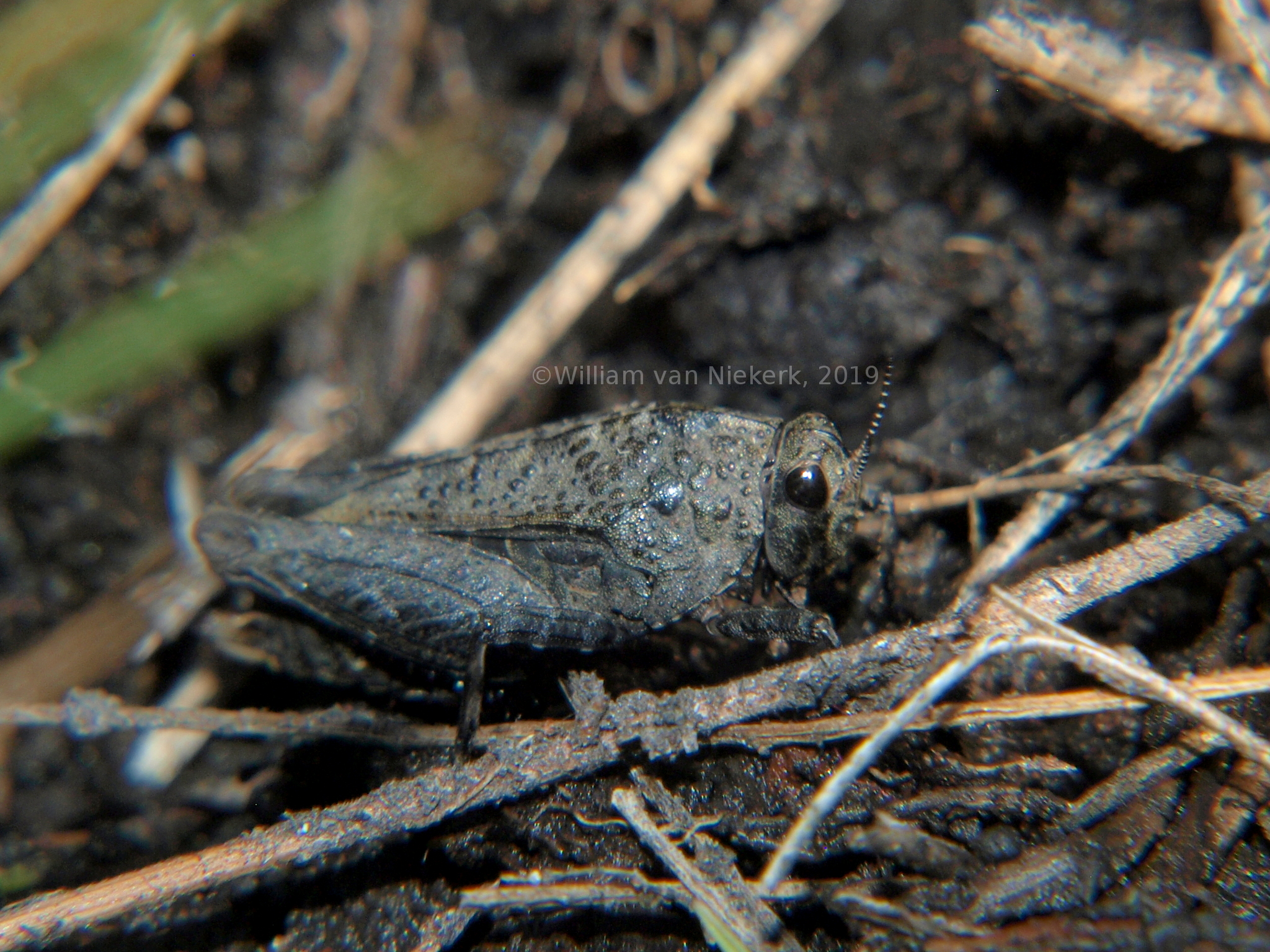
- Dasyleurotettix infaustus – Widespread. Usually found on sandy stream-banks and in dambos – especially in areas of bare soil.
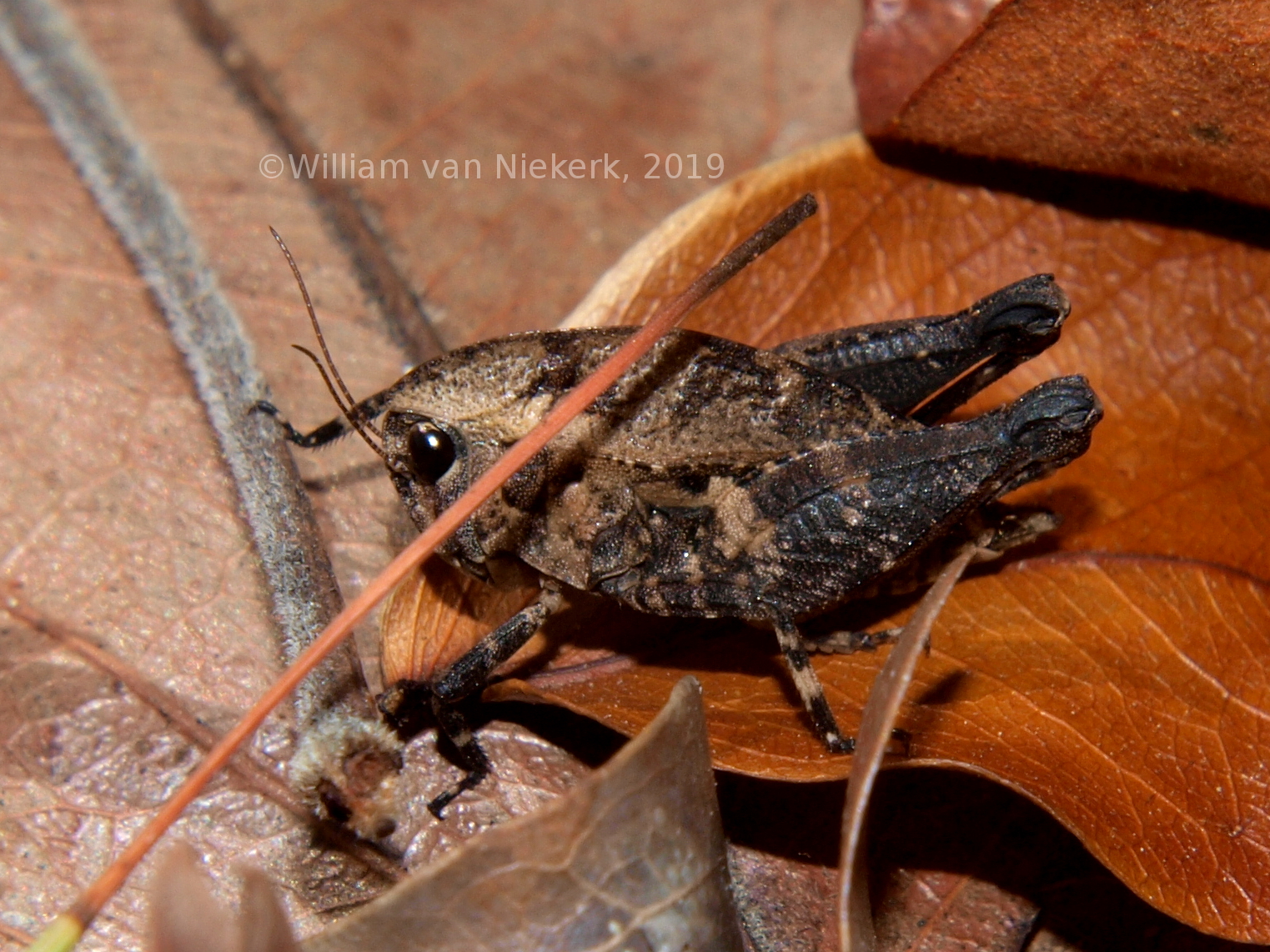
- Phloeonotus humilis – Widespread. Less commonly found close to water than most related species; common in Miombo throughout rains.
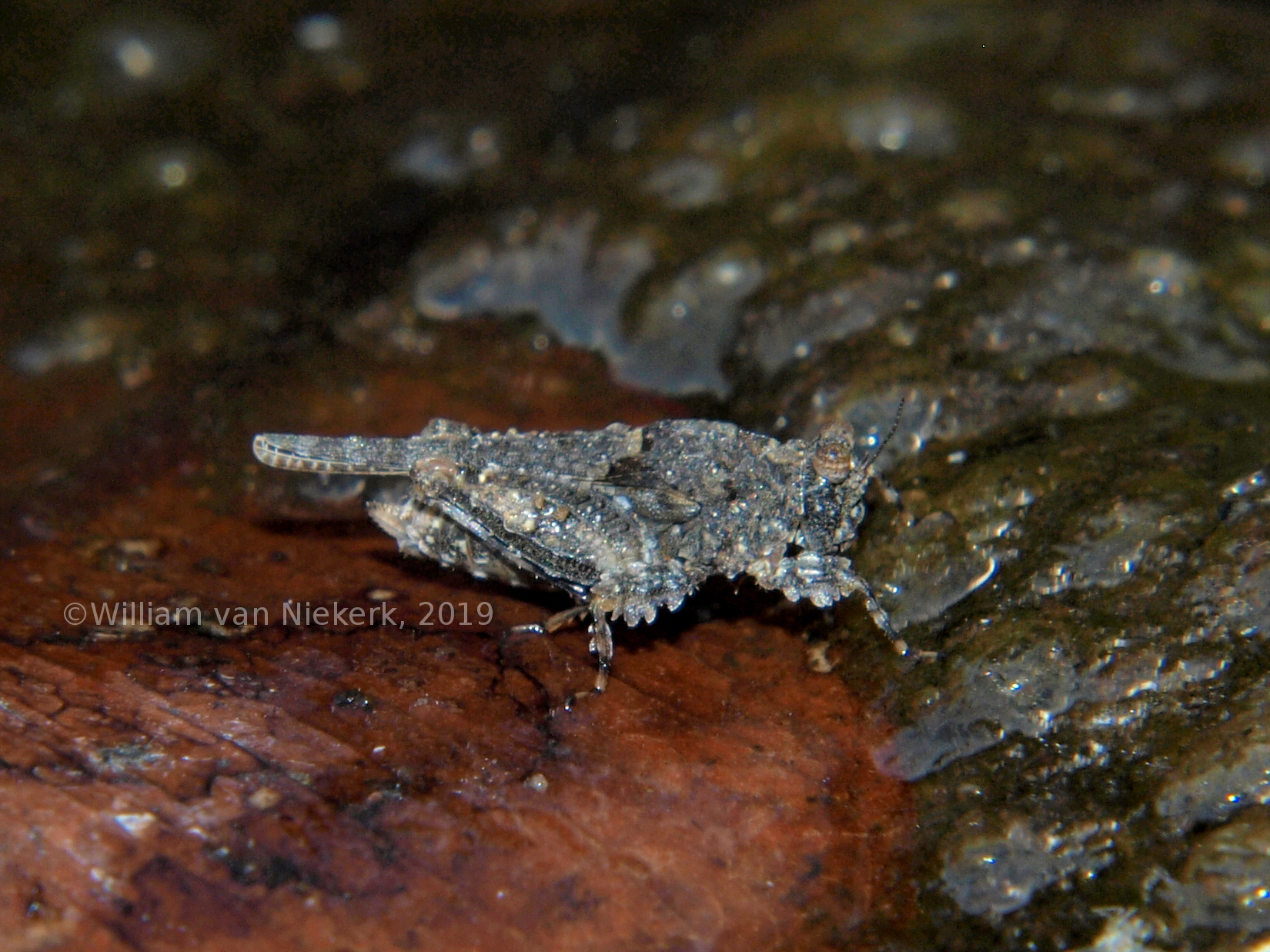
- Trachytettix scaberrimus – Widespread. Most commonly seen on riverside rocks covered with moss and algae; usually easy to find at Ndubaluba and the rapids during low-flow periods.
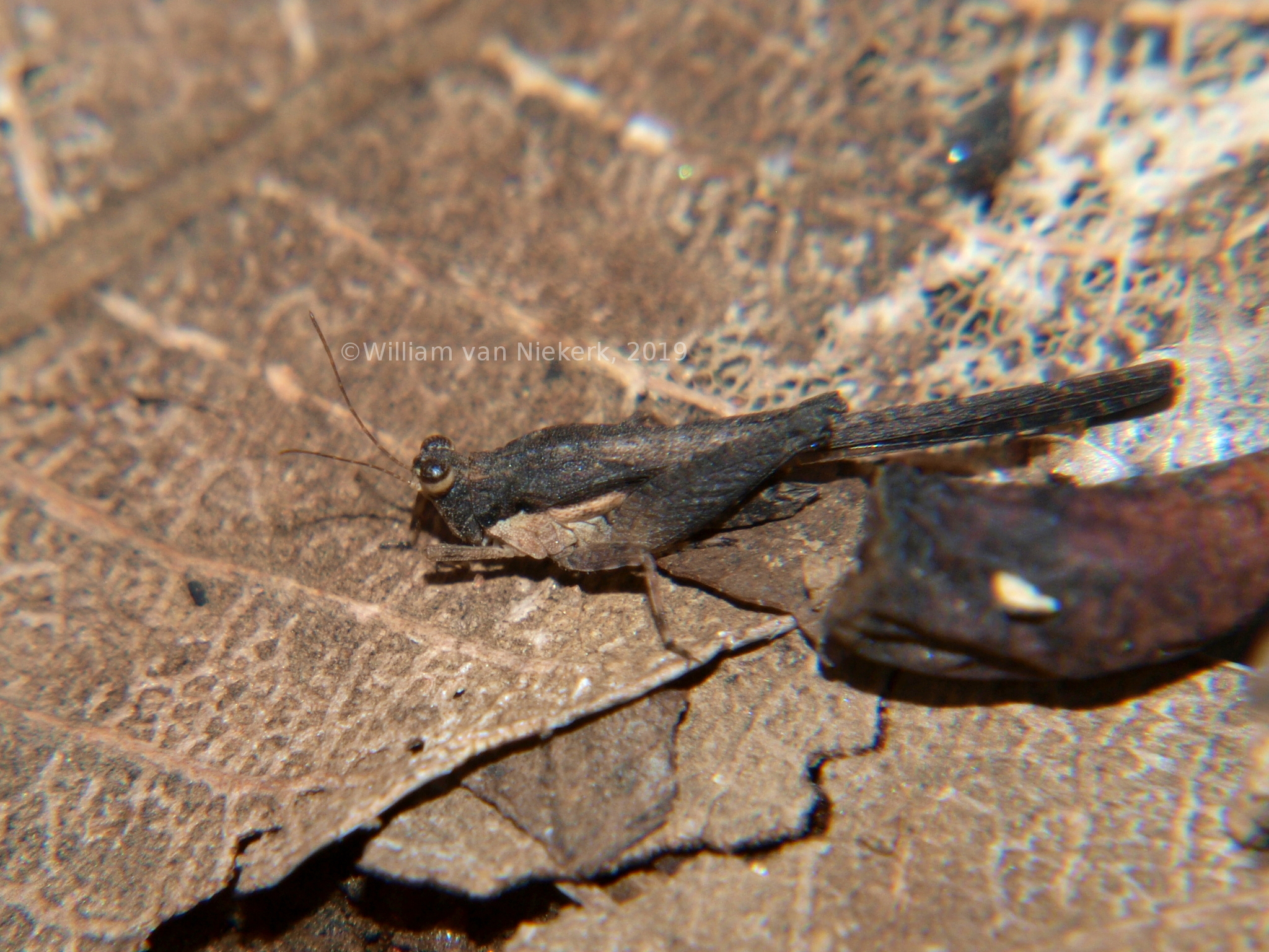
- Paratettix sp. - Several very similar species regionally; many of them widespread. At Mutinondo, strongly associated with riverine thicket and dense forest, distributing further into miombo following heavy rain.
True Crickets – Family Gryllidae
Small to medium-sized, variously herbivorous or (more usually) omnivorous; usually living at or near ground level (with a number of exceptions); males of most species call loudly at night.
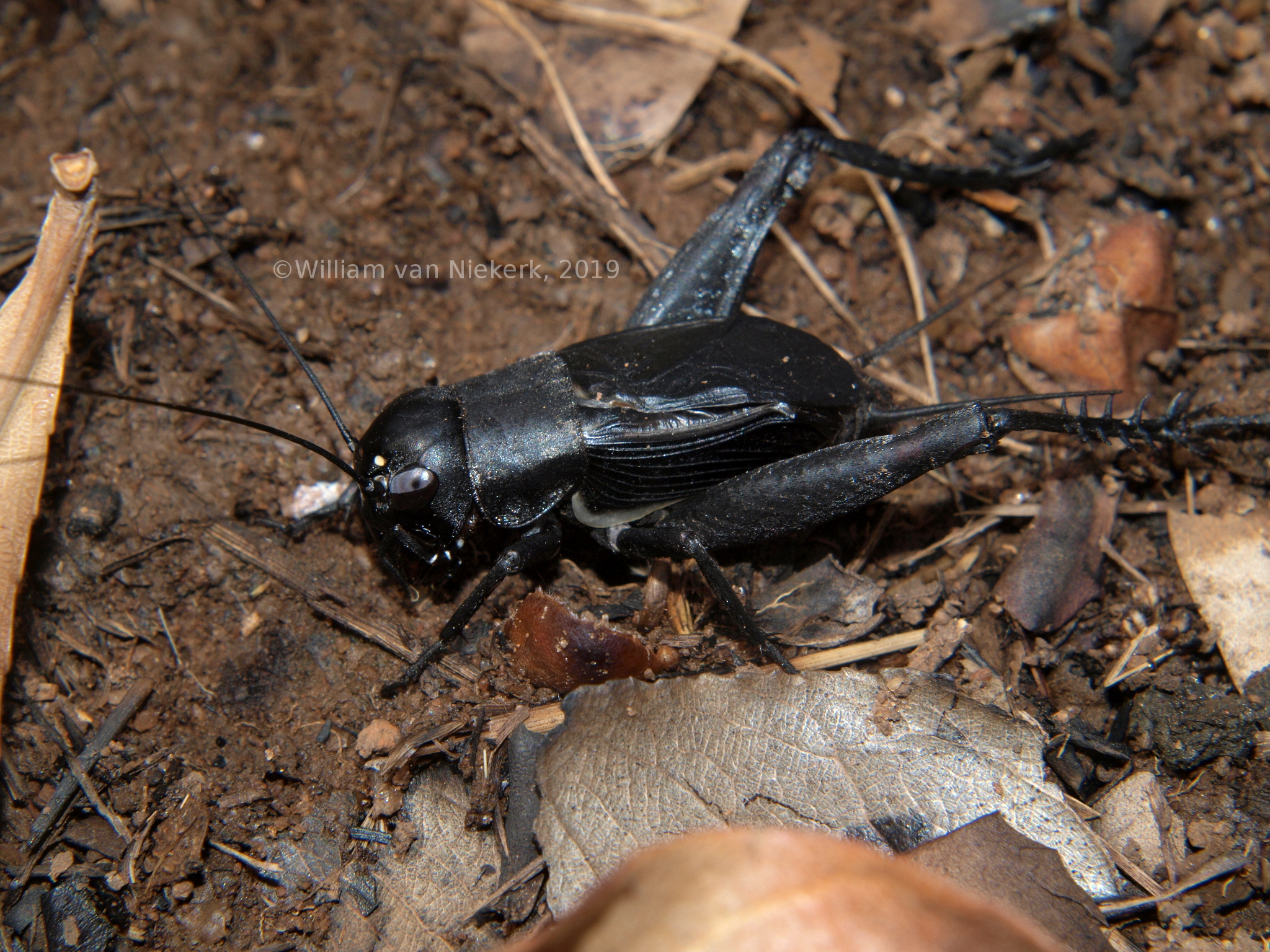
- Grylloderes maurus – Widespread. Largely nocturnal, but may be found calling in woodland on overcast days.
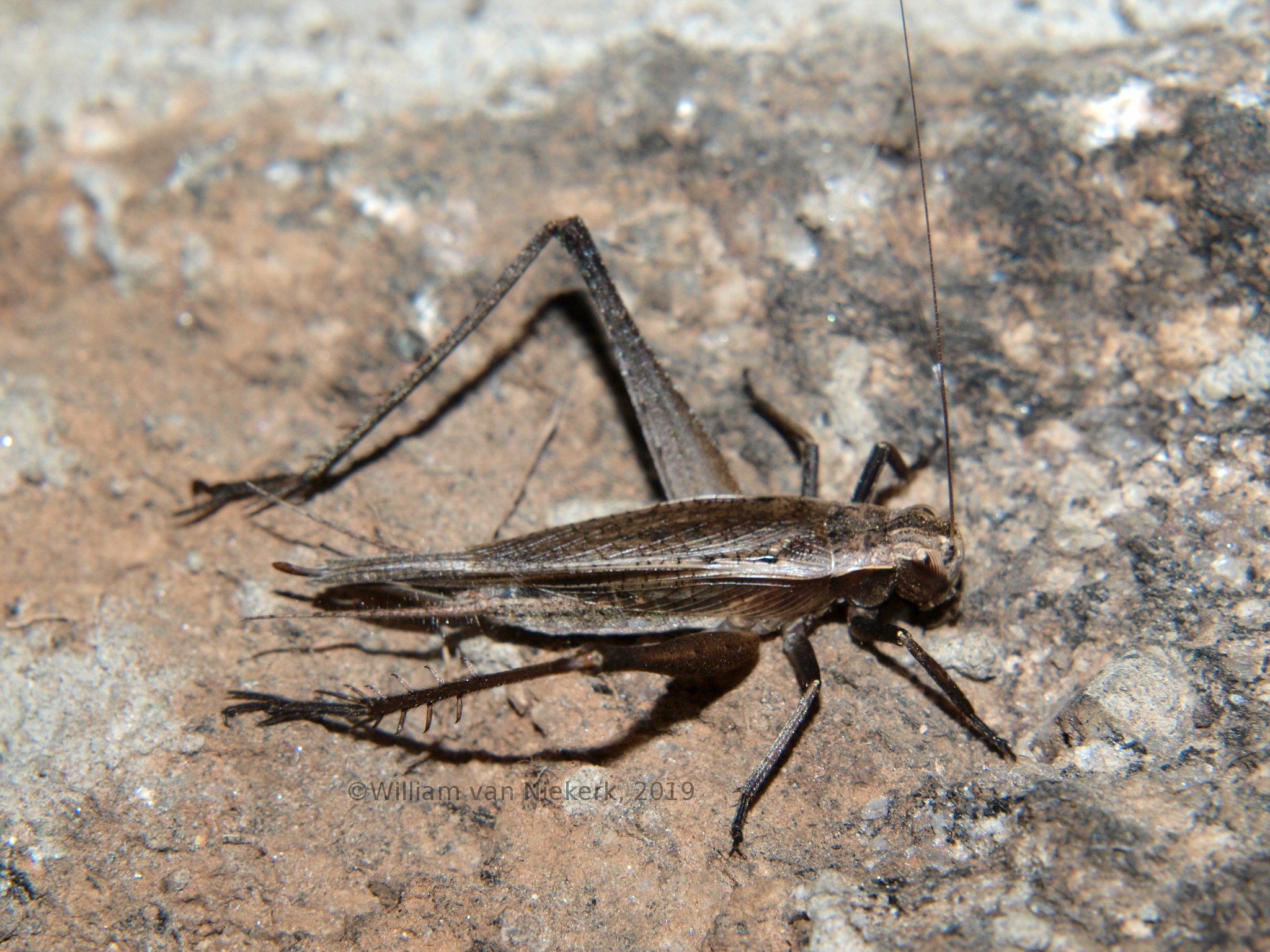
- Xenogryllus eneopteroides – underrecorded, never common, but probably widespread in East and Central Africa. Comes to lights, but typically associated with dambo grasslands, particularly during dry months.
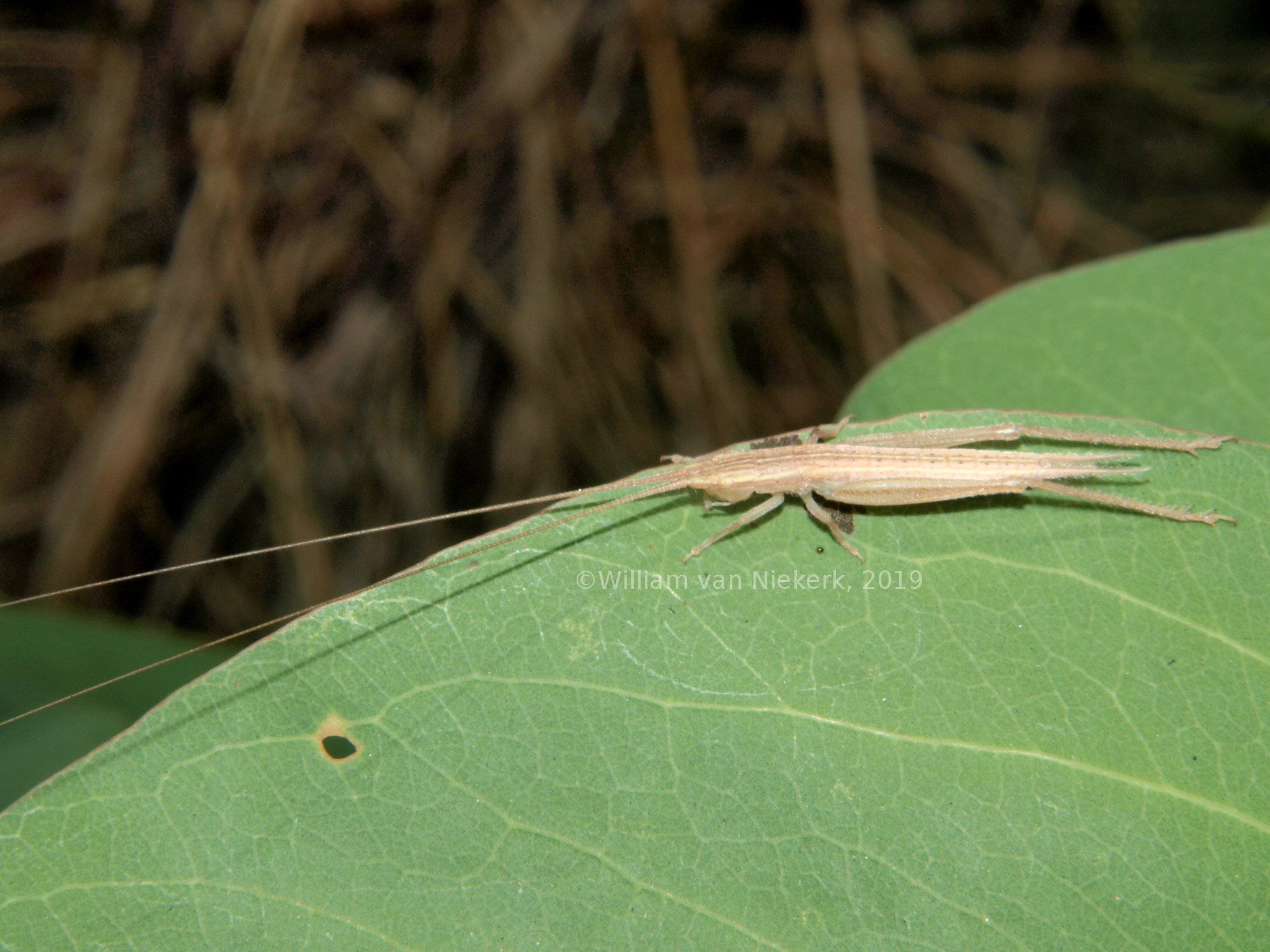
- Euryscirtus (Euryscirtus) bivittatus – Widespread. Largely associated with dense, damp vegetation, especially riverine (including mushitu).
Cave Crickets – Family Phalangopsidae
Long-legged, flightless and omnivorous, usually associated with caves and underground cavities; some species make use of attics, soakaways and outbuildings.
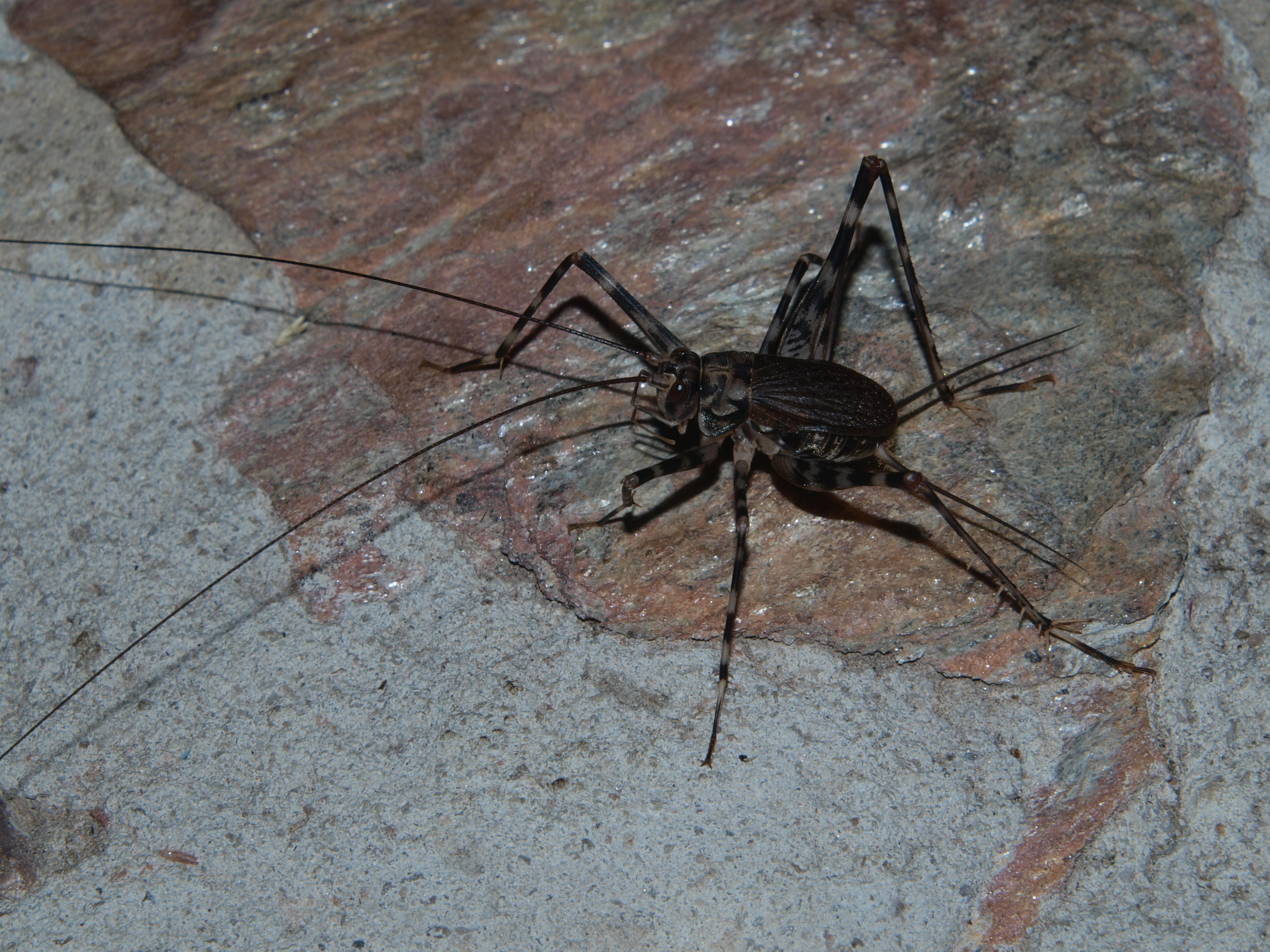
- Phaeophilacris (Speluncacris) spectrum. Relatively widespread, somewhat synanthropic, and most usually found in and around buildings.
Scaly Crickets – Family Mogoplistidae
Small to tiny, flightless and usually silent relatives of crickets, commonly found on bark (especially Arachnocephalus) and in leaf-litter or dank vegetation.
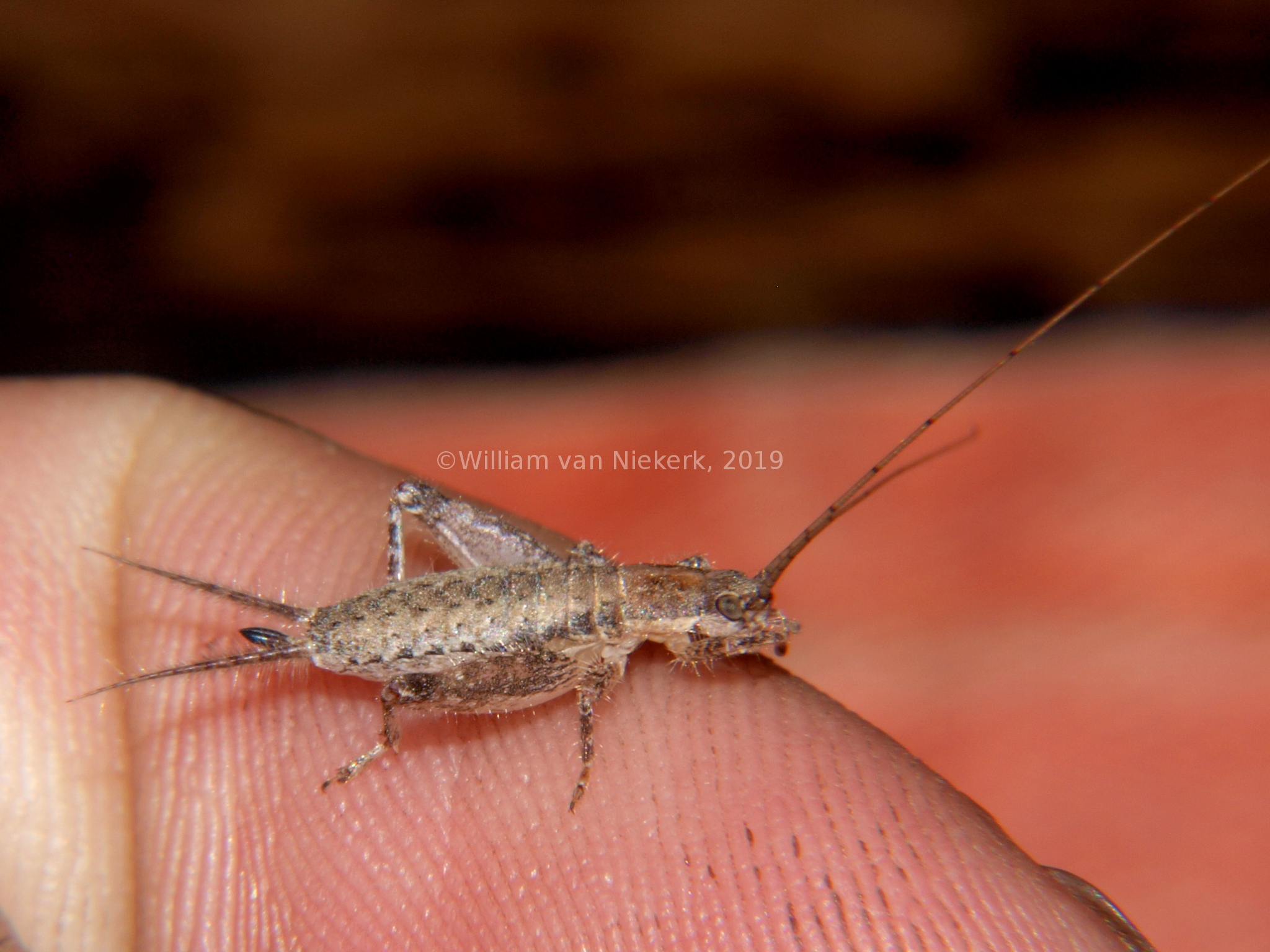
- Arachnocephalus sp. – Genus widespread; ubiquitous in miombo; understudied and in need of a regional revision; Zambian Arachnocephalus may prove to represent several new species.

- Ectatoderus cf ochraceus – corresponds well to description and images of type of this species, otherwise limited to the Kenya/Tanzania border region.
Katydids and armoured Crickets
Generally medium sized to large, herbivorous to carnivorous insects. Sometimes split into several families; at their most diverse in forested areas, but with specialists for most habitats. Primarily nocturnal and canopy-dwelling, so easily overlooked.
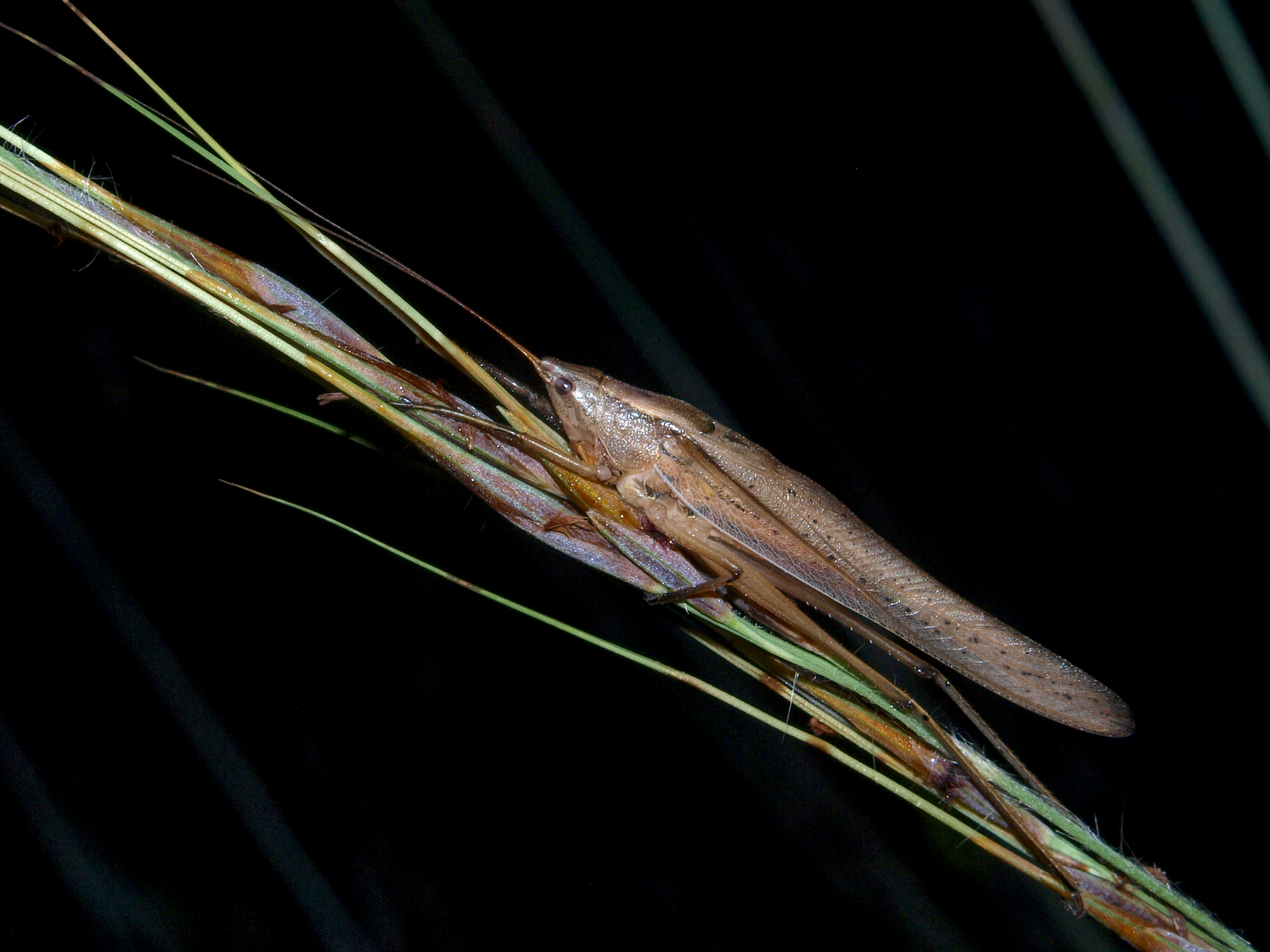
- Ruspolia flavovirens – Widespread in central Africa. At Mutinondo, often found calling from seepage grassland on inselbergs.
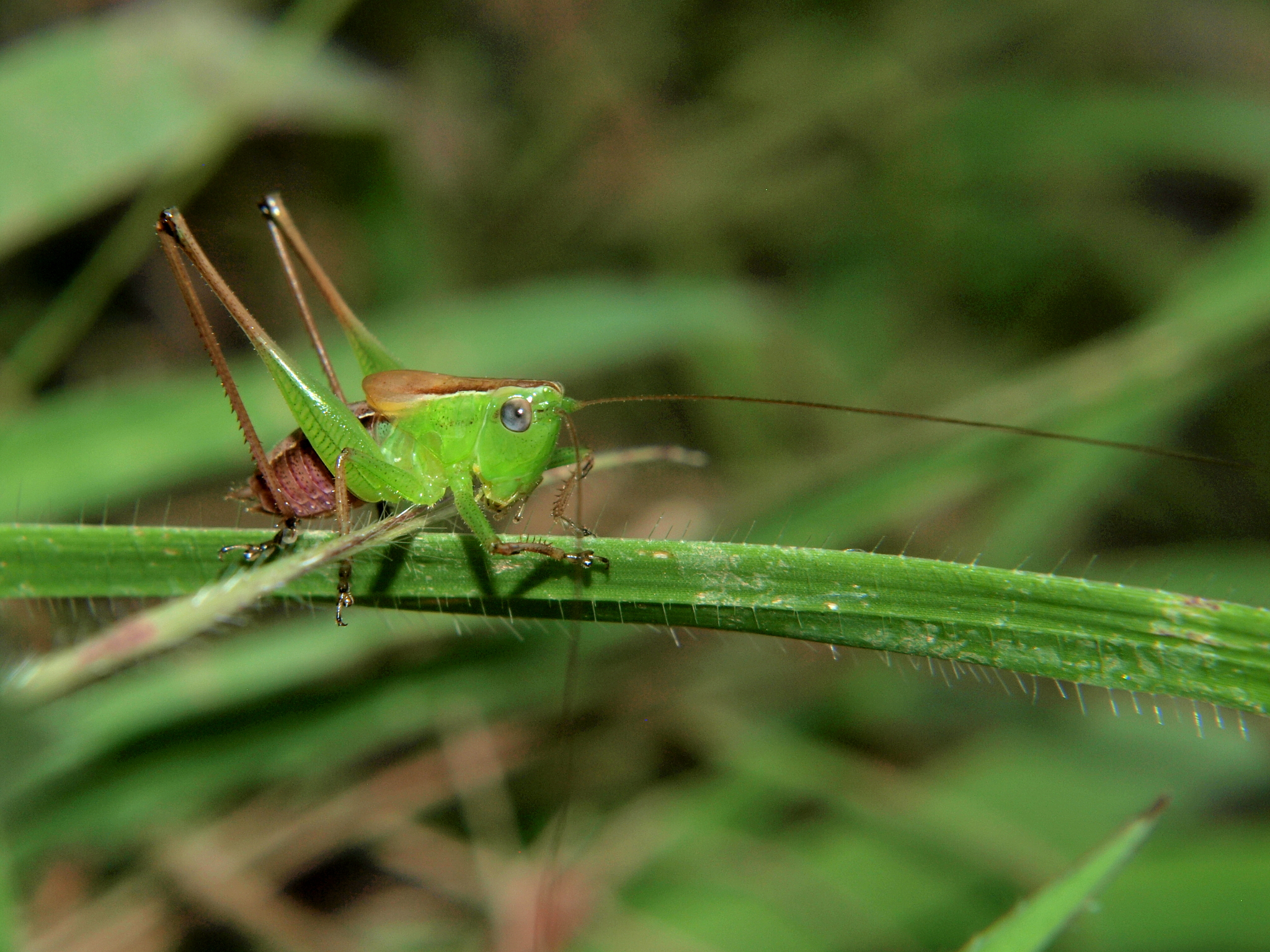
- Undescribed species “Zambiscirtes mutinondo” (provisional name) – a member of the endemism-prone subtribe Karniellina; male cerci are unlike any described species or genera, but most similar to Naskreckiella. Newly recorded; no type has yet been captured for proper description, occasionally seen in dambo-edge and riverine grassland.
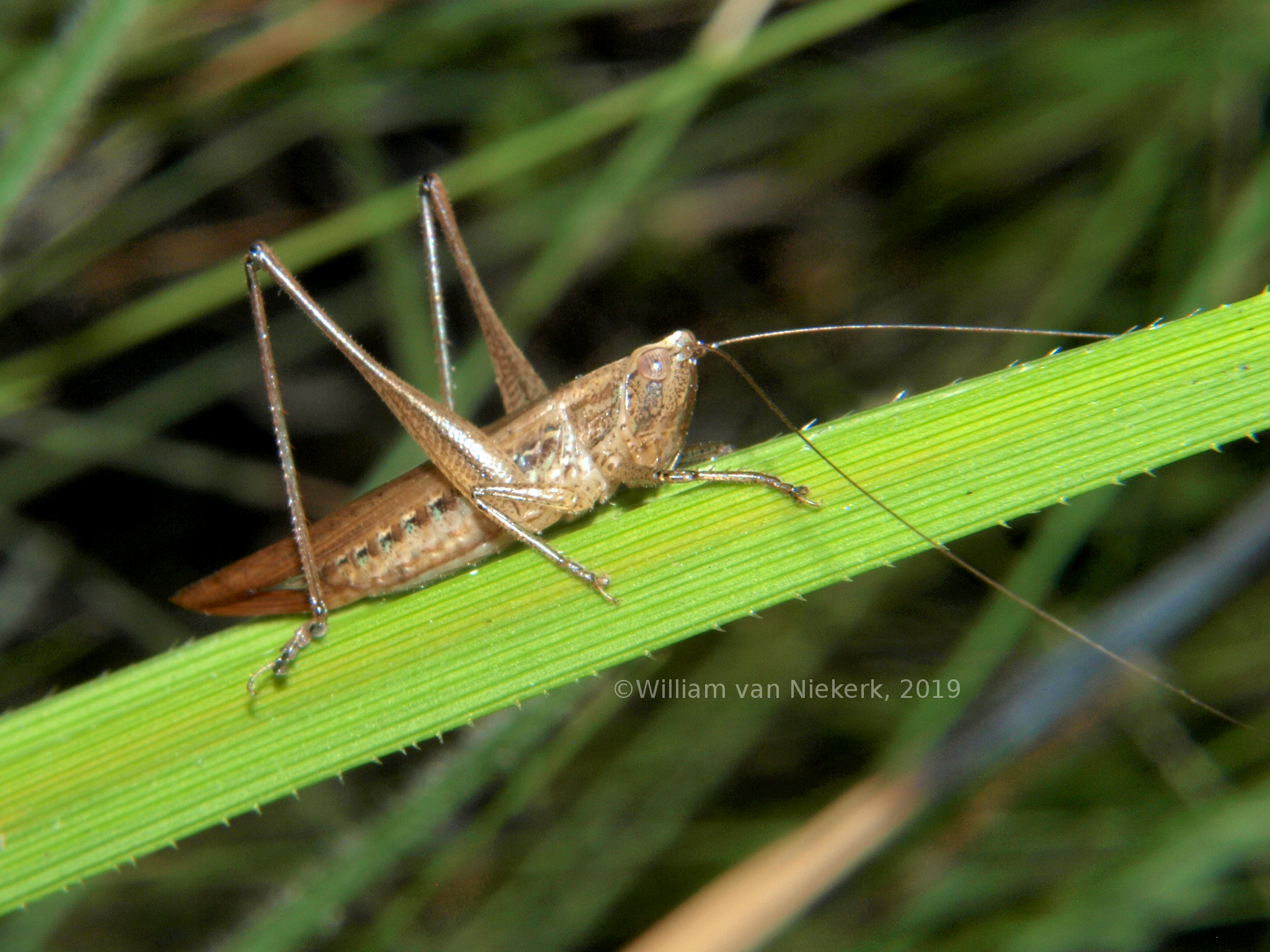
- Conocephalus (Conocephalus) conocephalus (African Meadow Katydid) – Widespread, ubiquitous in grasslands.
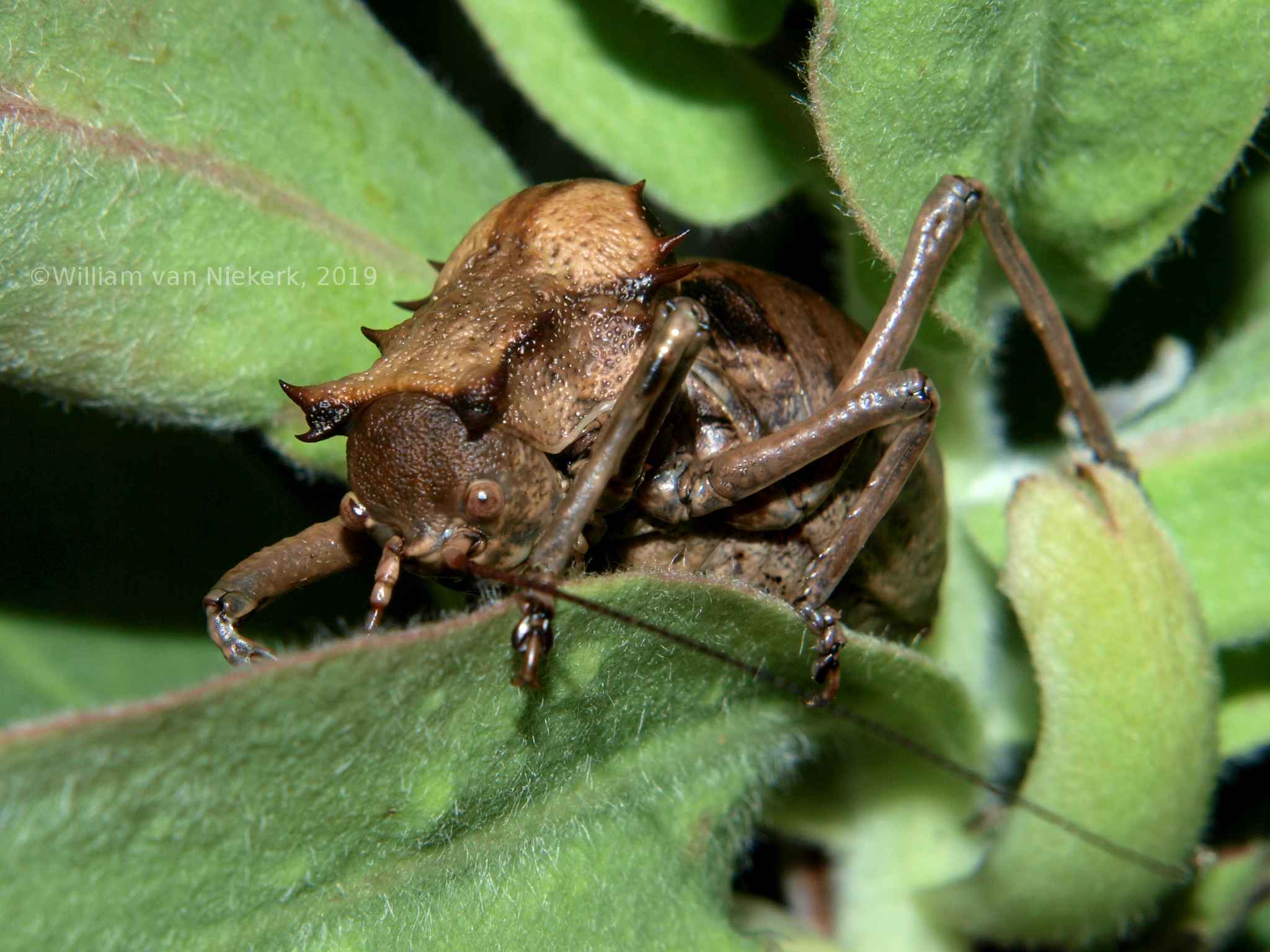
- Enyaliopsus parduspes (Common Koringkriek/Armoured Cricket) – Widespread in the North-East of Zambia, entering southern D.R.C., southern Tanzania and Malawi. Omnivorous; relishing carrion or soft-bodied insects. Calls from low vegetation in woodland and woodand-edge.
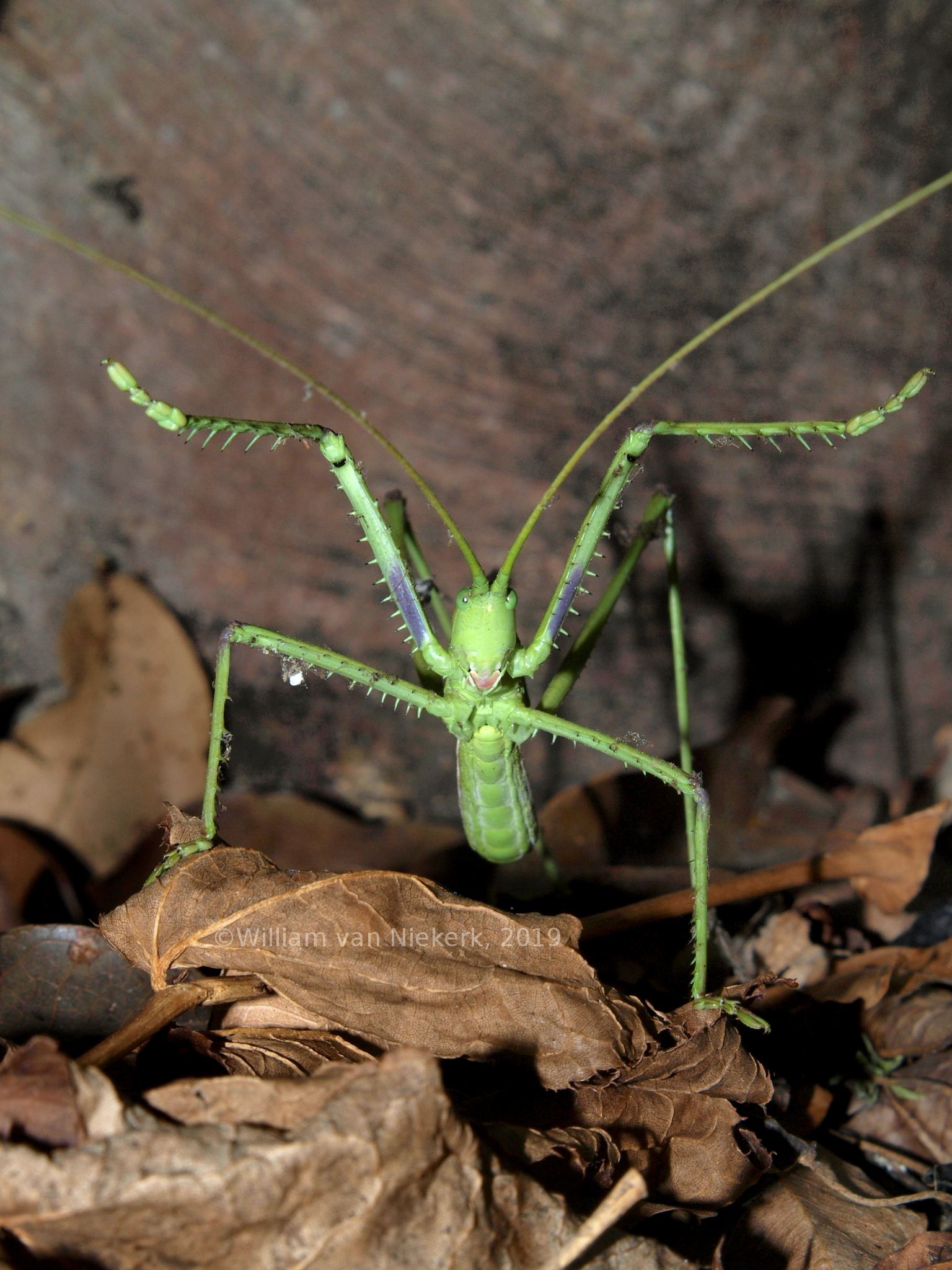
- Clonia (Clonia) multispina (Many-Spined Predaceous Katydid) – Otherwise Tanzania, Malawi. Attracted to lights and buildings; probably most at home in dense woodland canopy and Mushitu.
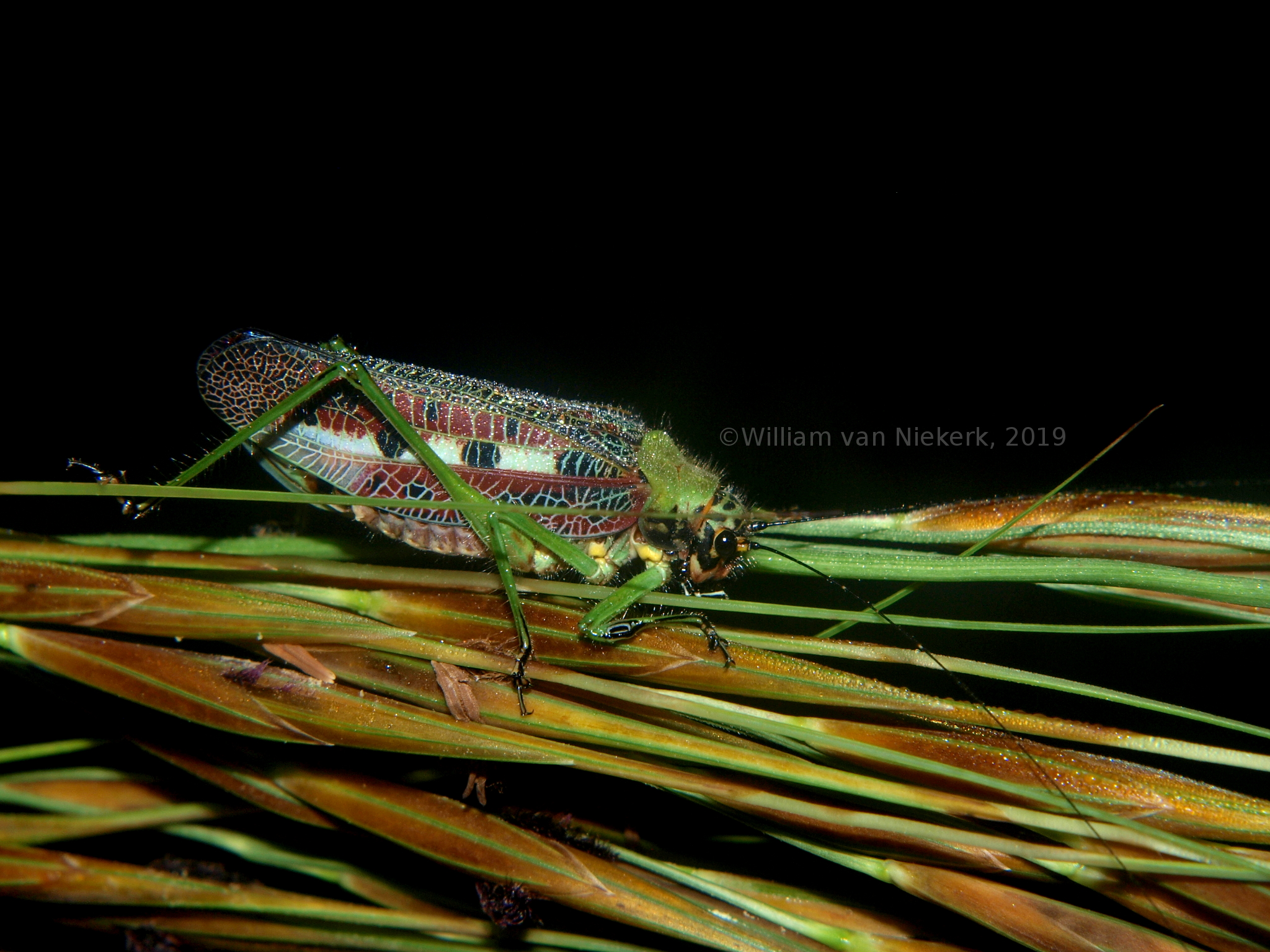
- Pardalota haasi (Haas’ Gaudy Katydid) – Southern D.R.C., Zimbabwe. Calls by day and night, usually in woodland trees, occasionally from shrubby growth in open areas.
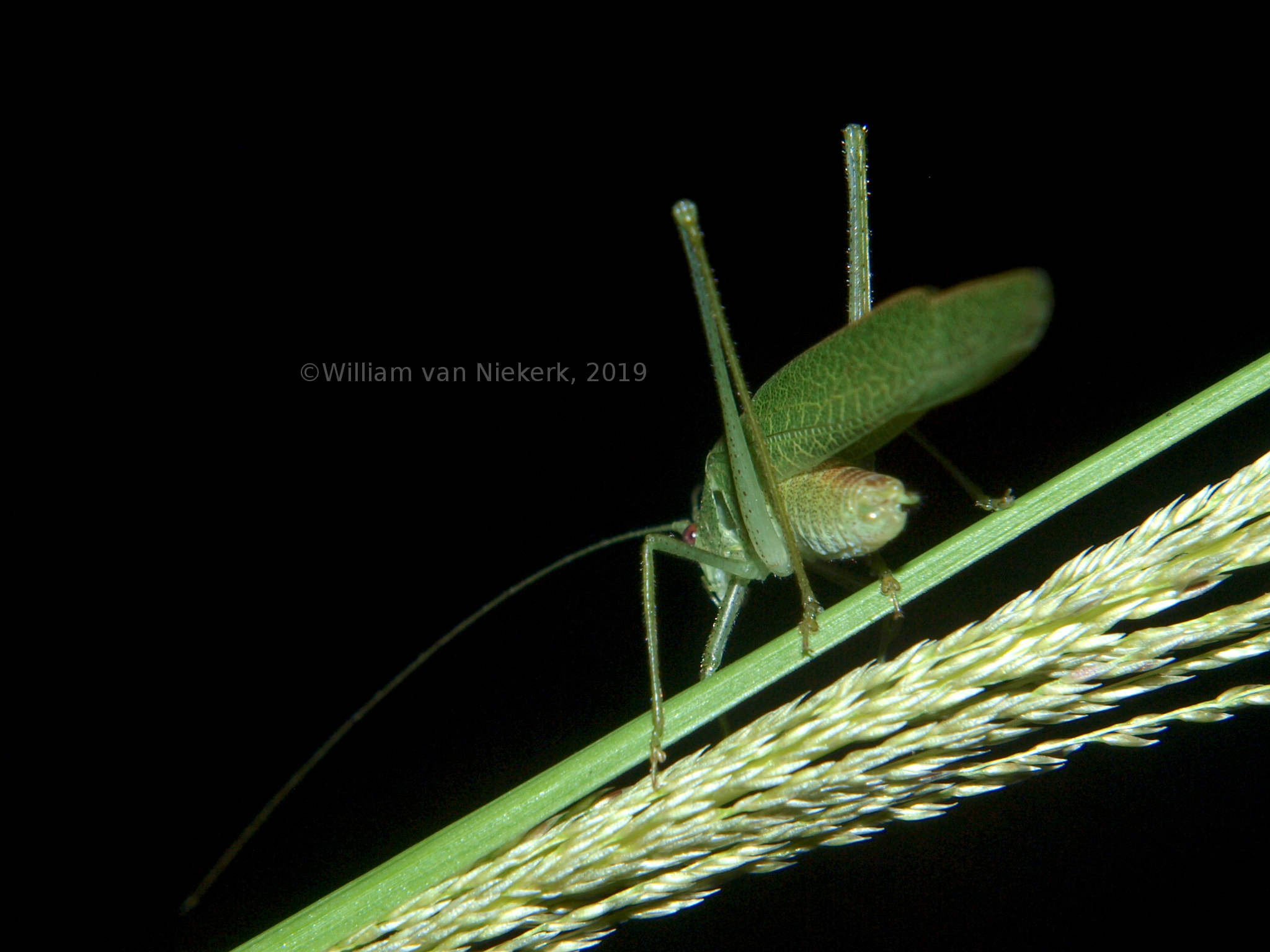
- Eulioptera reticulata – Fairly widespread, common; at Mutinondo found in mature woodland areas.
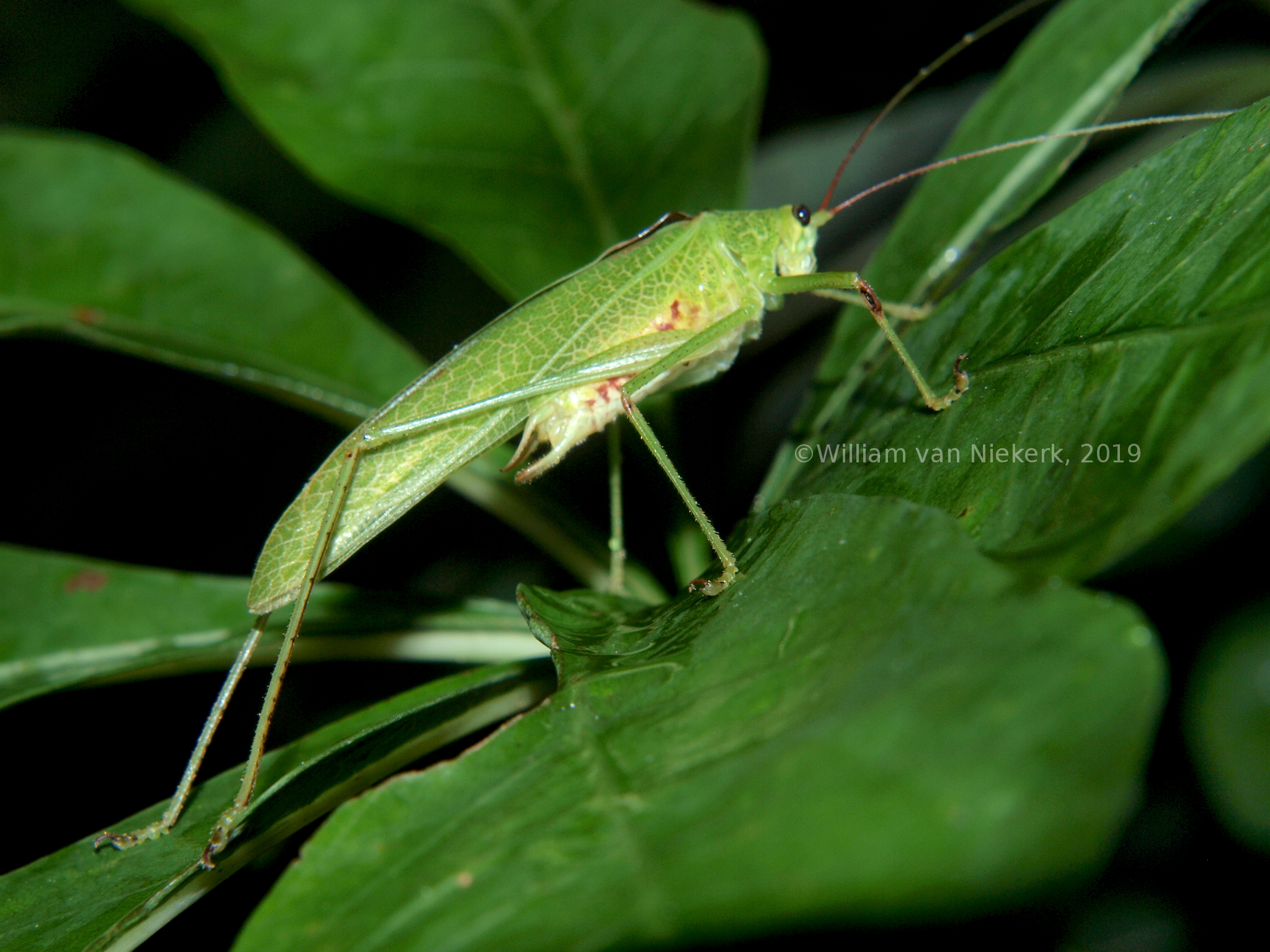
- Melidia brunneri – Widespread. At Mutinondo, in woodland and disturbed areas, most readily found when calling at night.
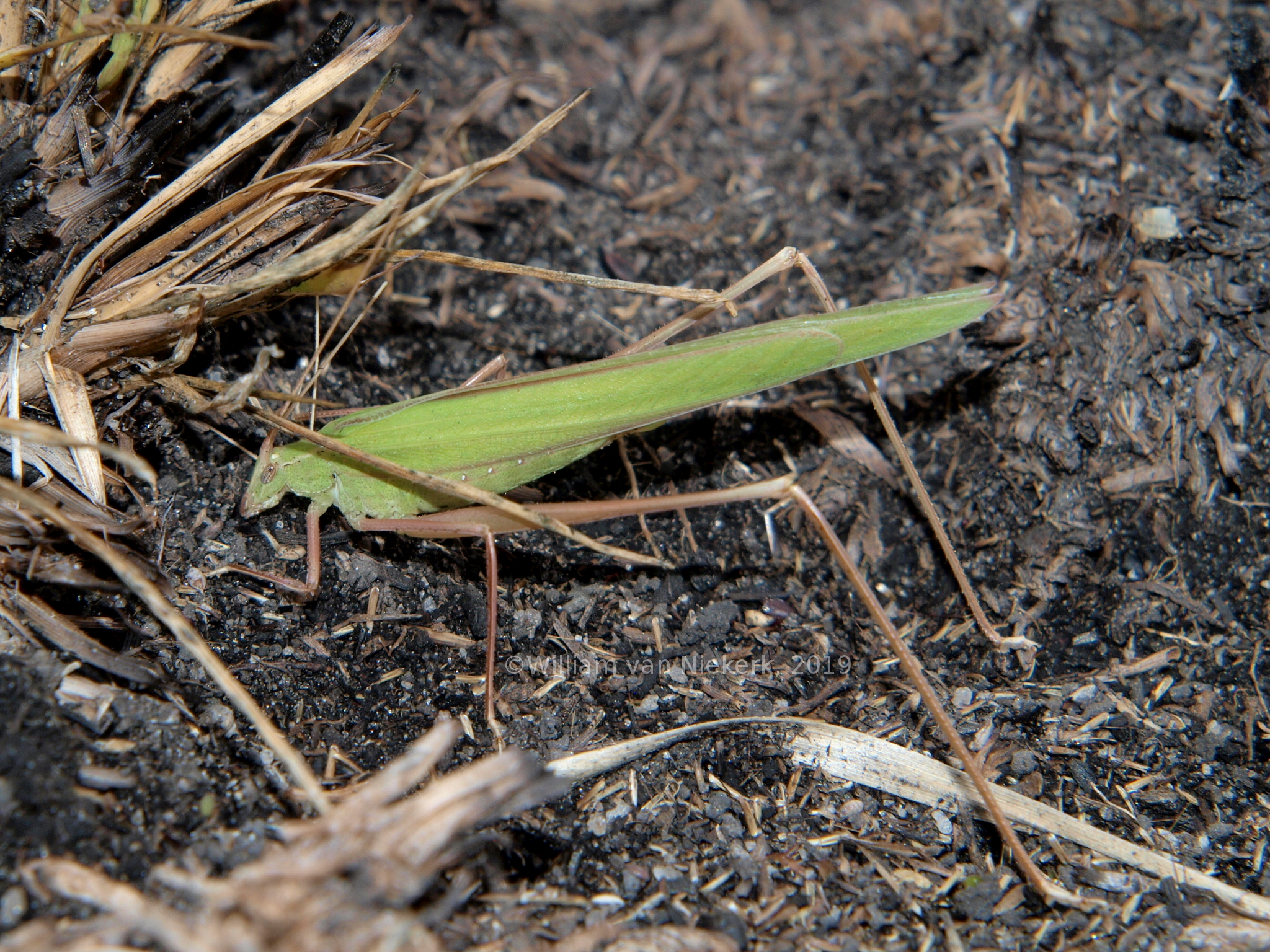
- Tylopsis sp. - Most likely the widespread T. continua. The most conspicuous katydid during the dry season, in all wooded and partially wooded environments – rarely in dambo.
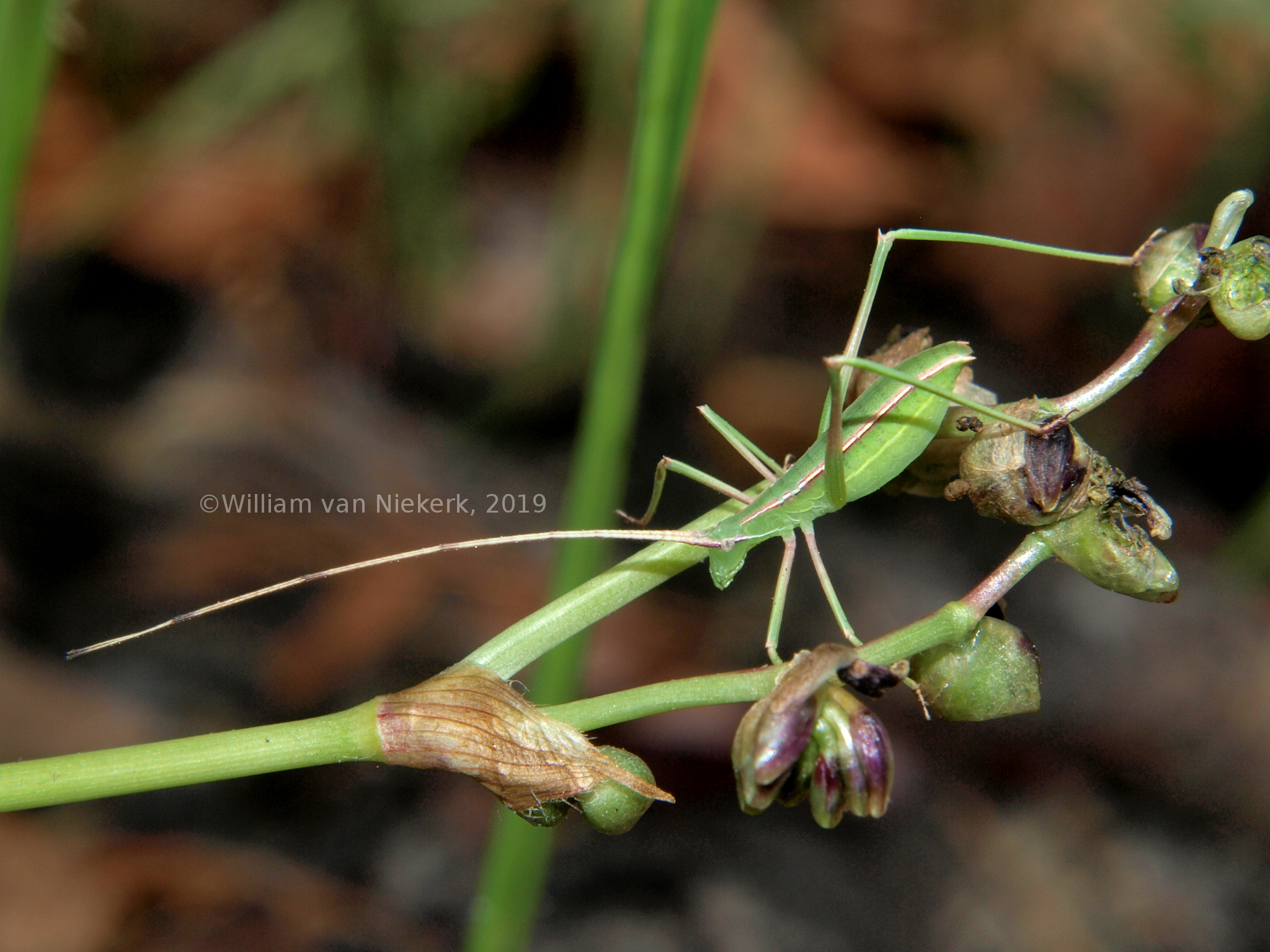
- Horatosphaga sp. - only nymph seen; calls attributed to unseen males of this genus are unlike those of the nationally common Horatosphaga media.
- Cymatomera sp. – Bark Katydid. Probably limited to Mushitu and mature woodland; known to be present by decomposed (unidentifiable beyond genus) remains found at the rapids below Ndubaluba.
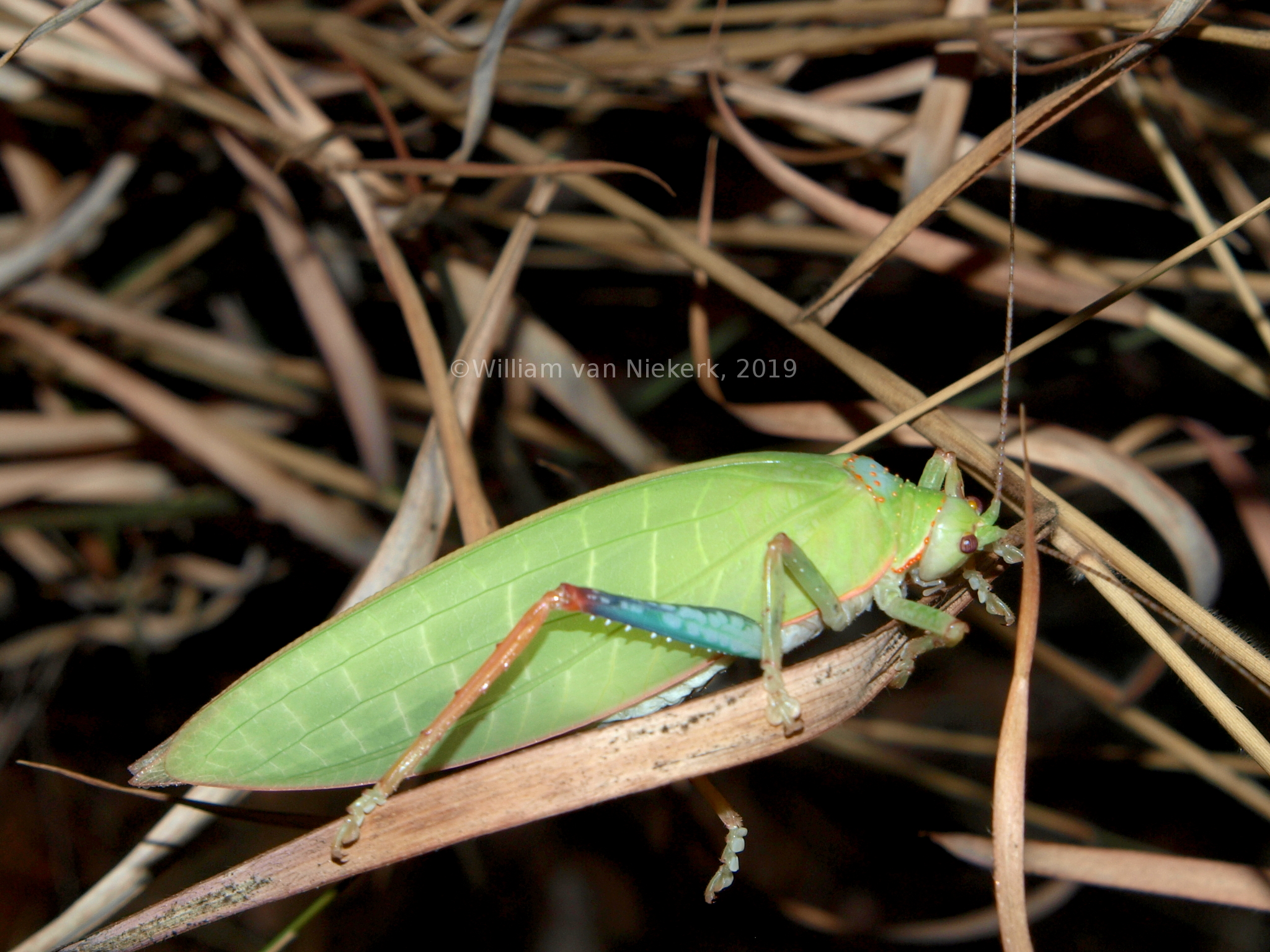
- Zabalius cf. centralis – Genus poorly recorded in Zambia; Z. centralis, otherwise known from the D.R.C. side of the Luapula river, appears to be the best match for this female. Typically favour mature woodland and forest, but do venture on to lodge rock, probably attracted by lights.
Leaf-Rolling Crickets
Medium sized and often inconspicuous cricket-like insects, resembling rather squat, large-footed katydids, generally underrecorded and understudied in much of Zambia.
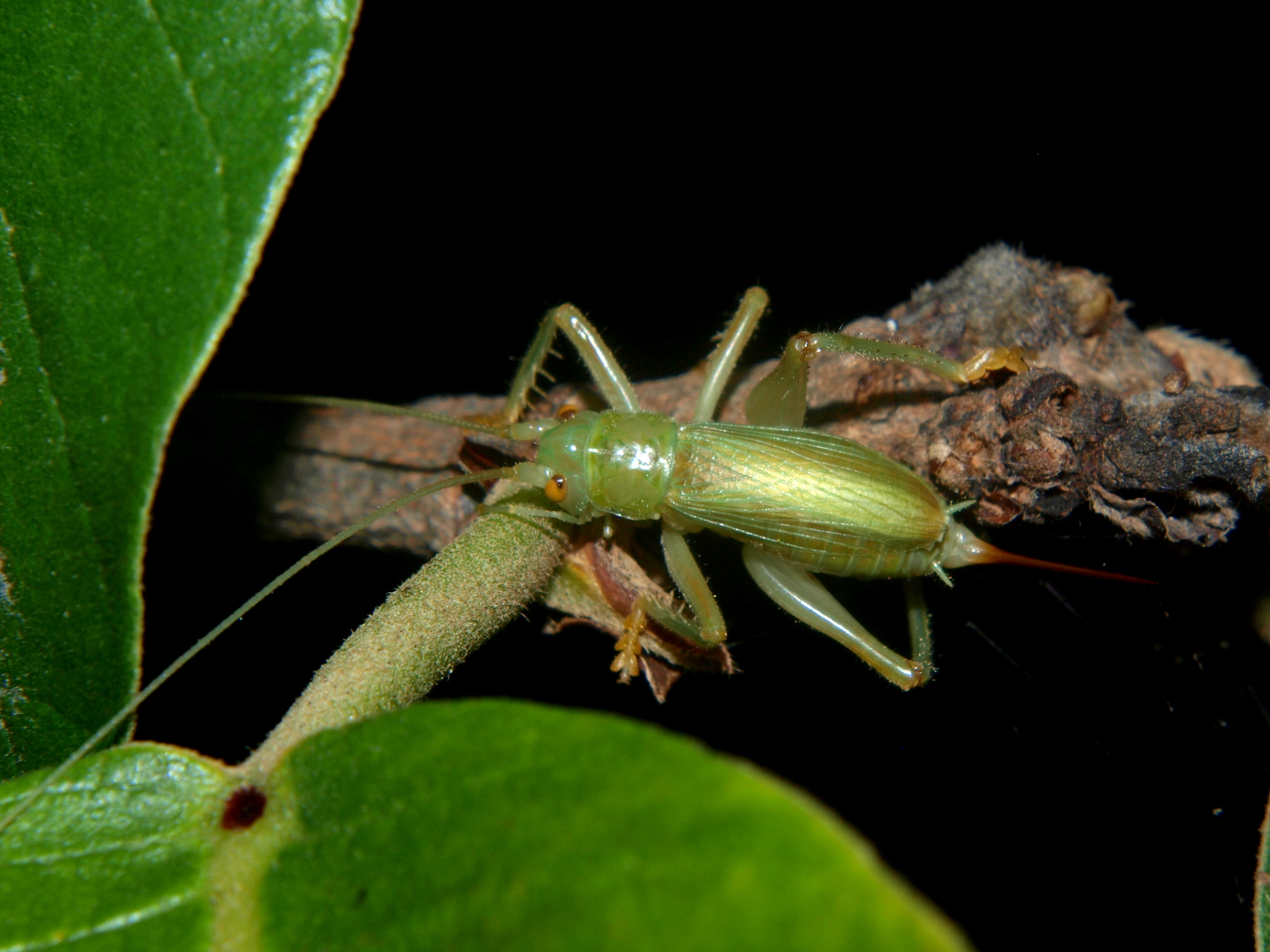
- Atychogryllacris cf. infelix – A. infelix is widespread in central Africa, .


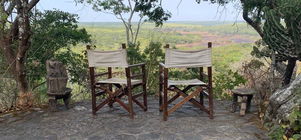
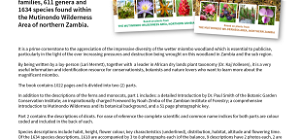
Share This Page